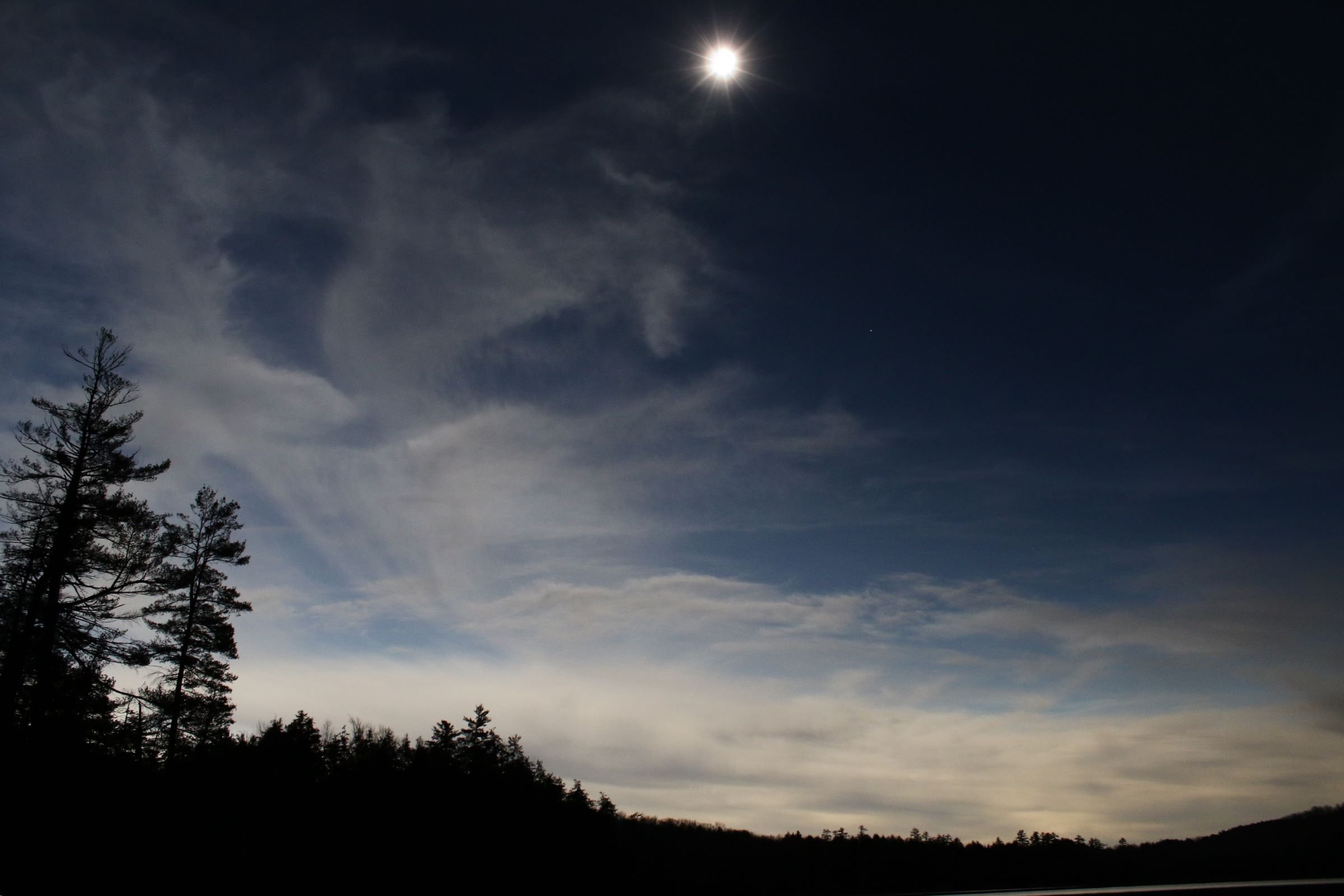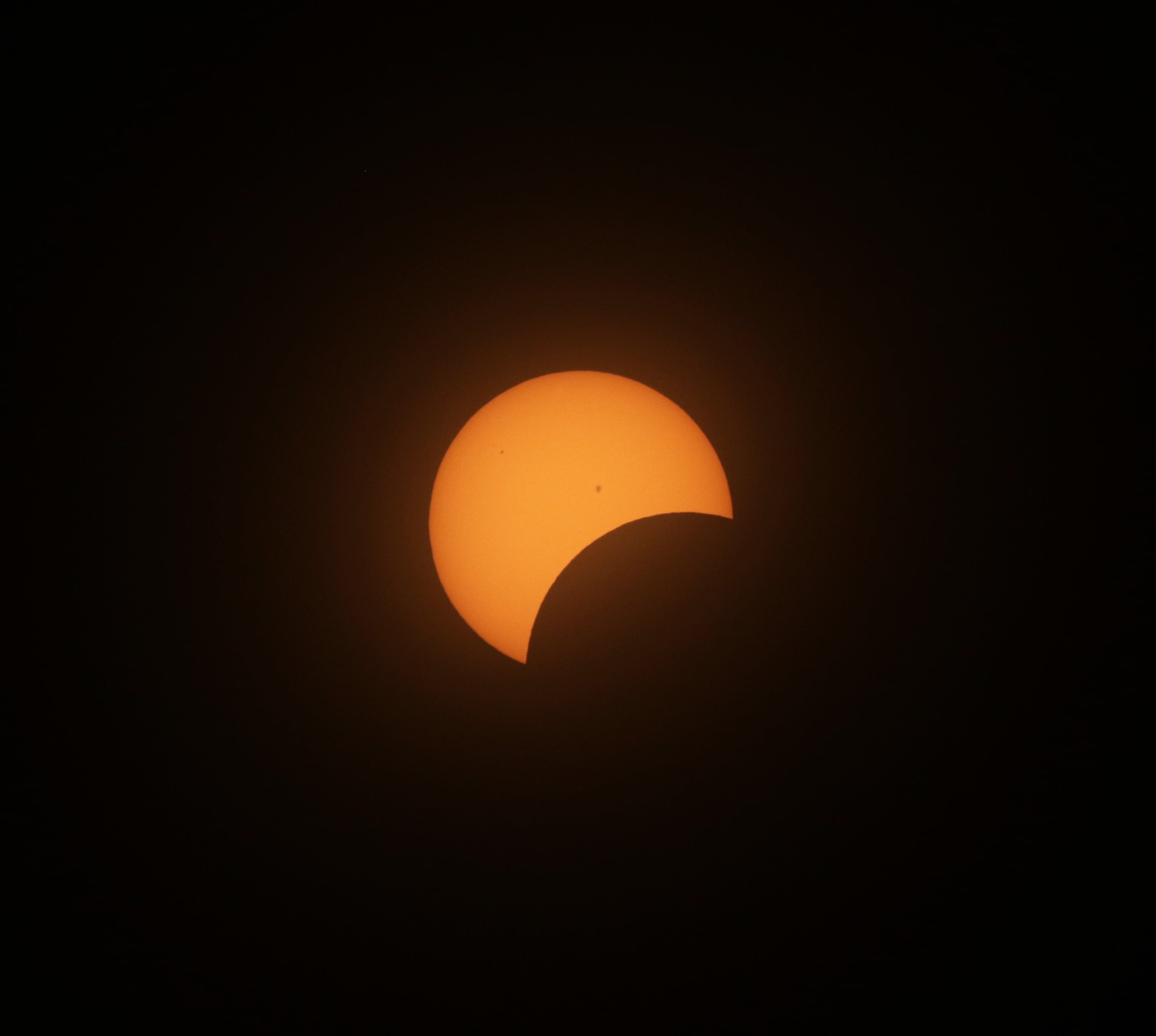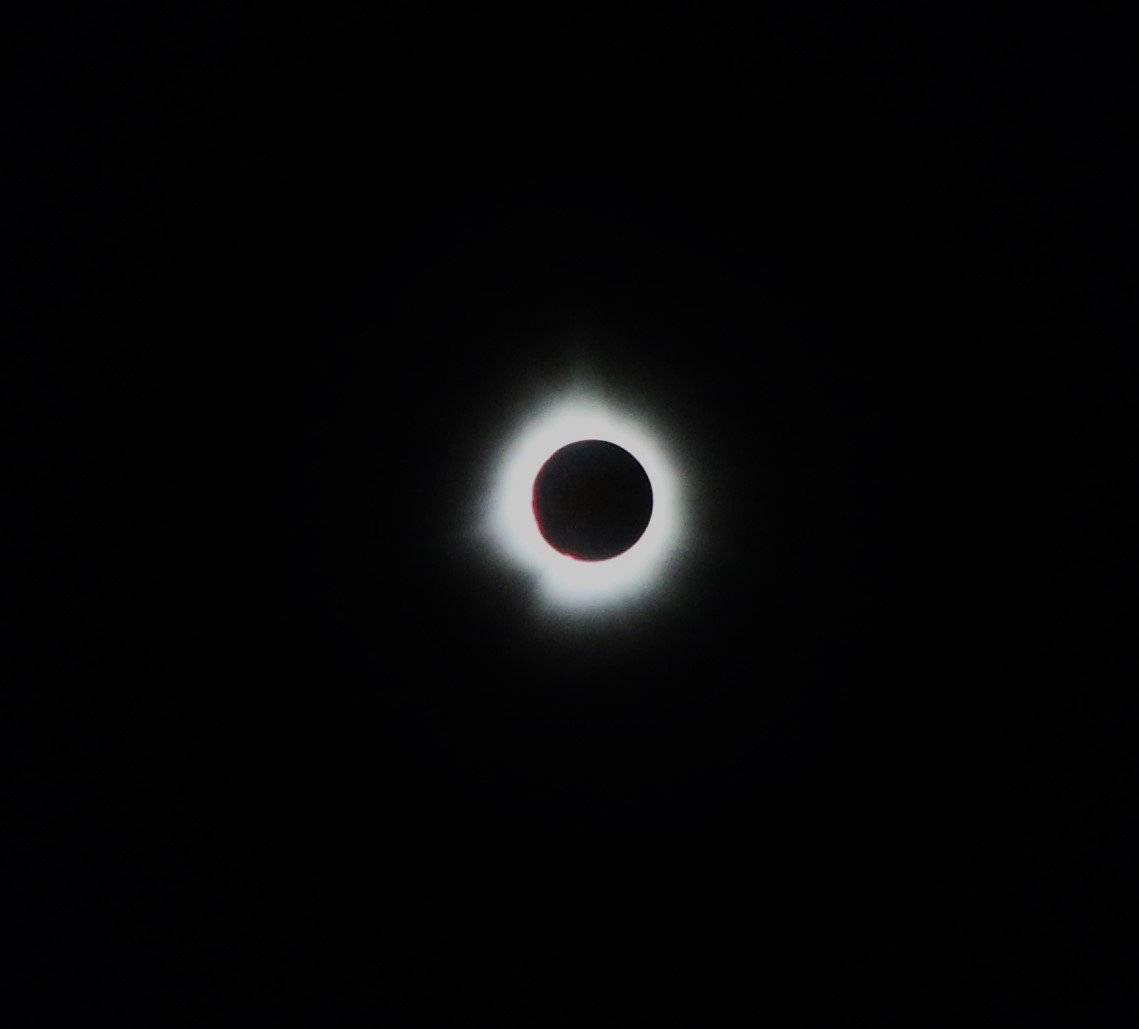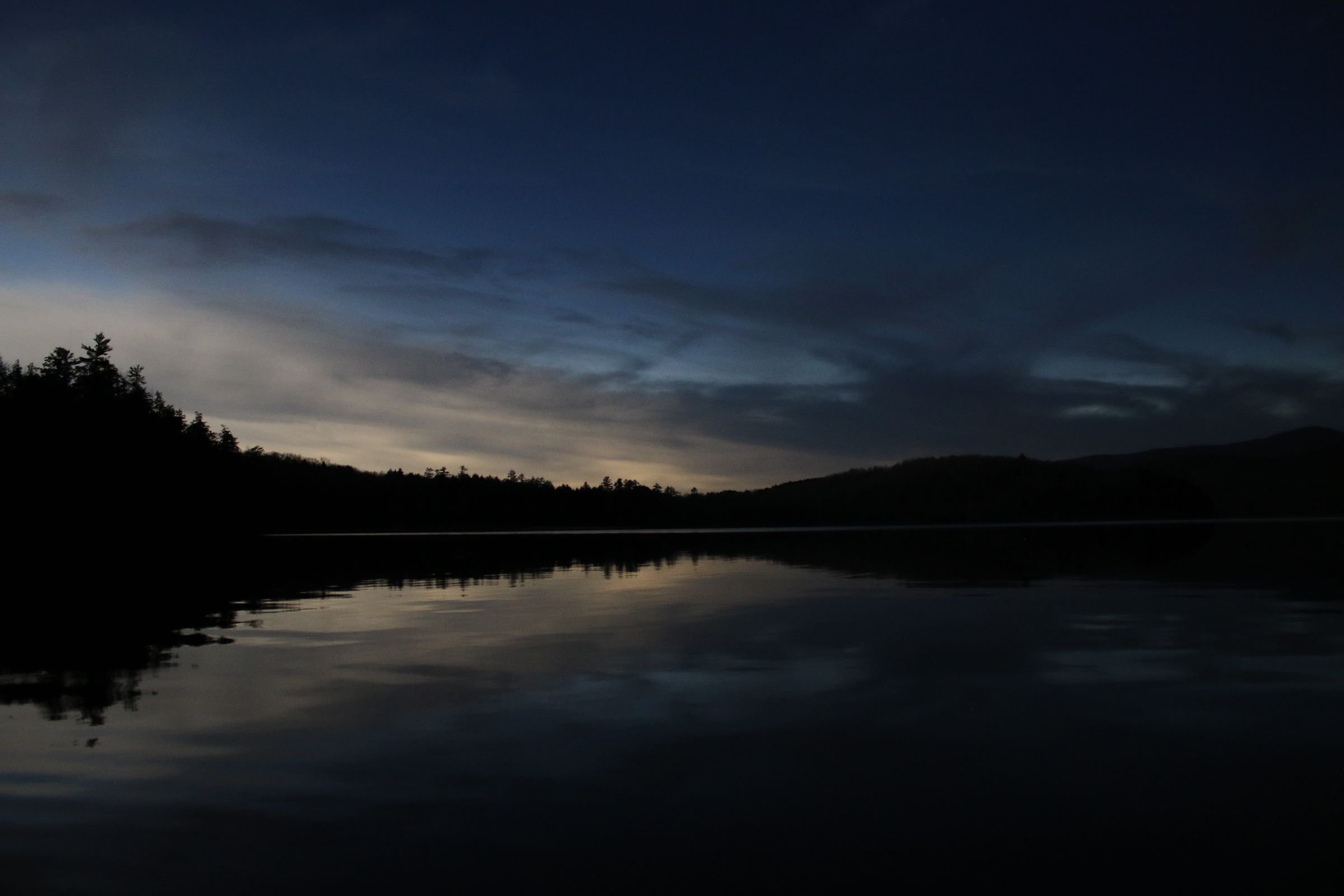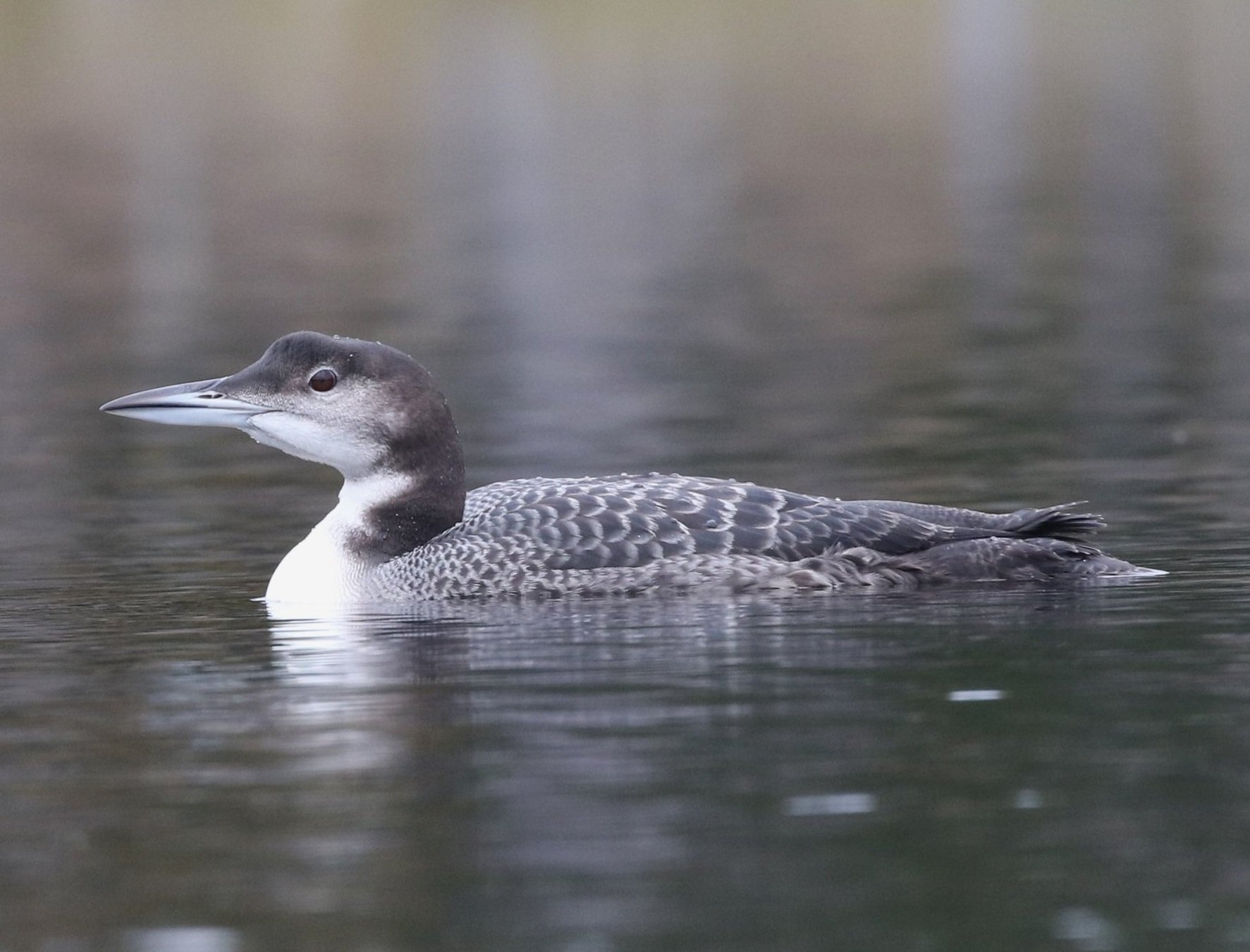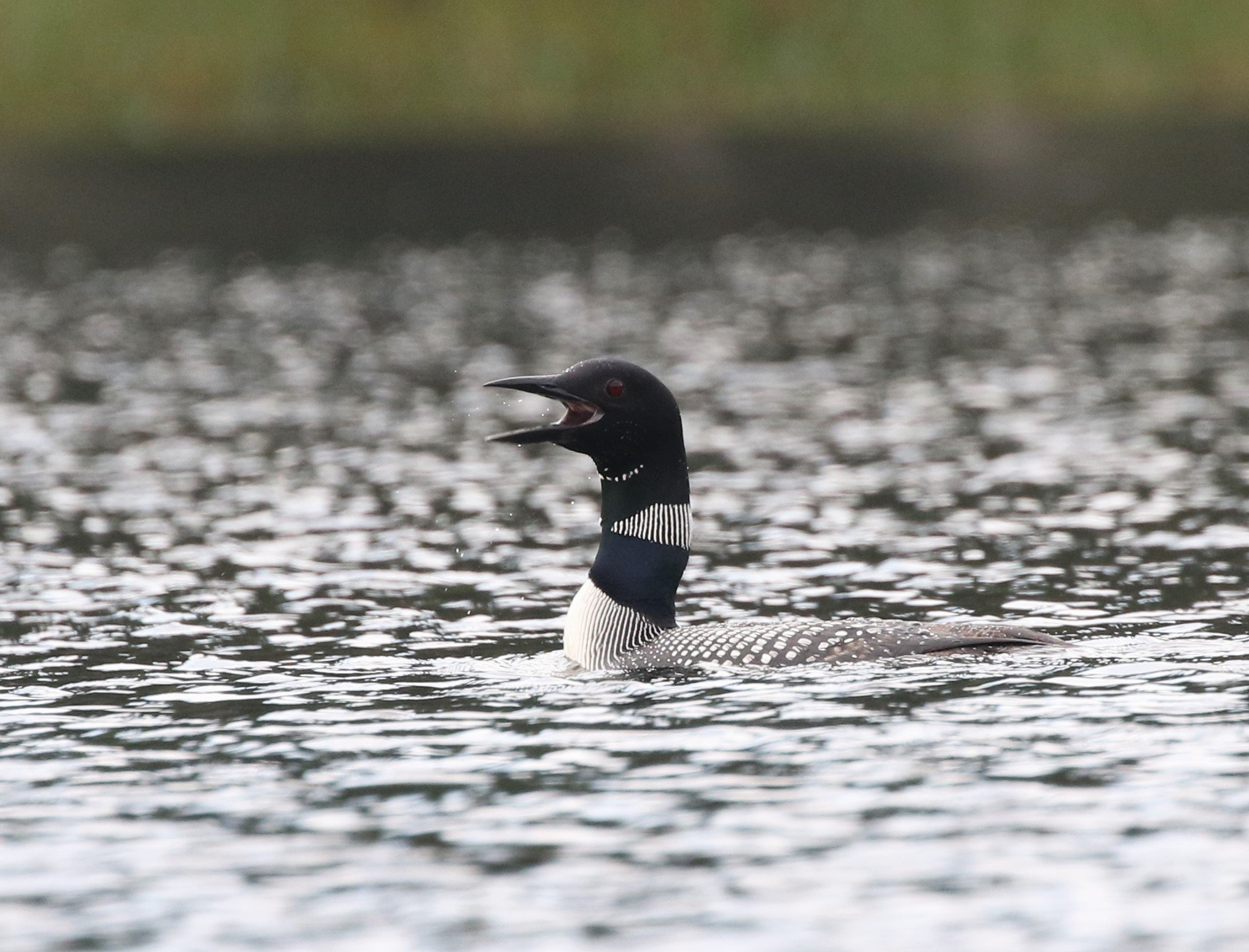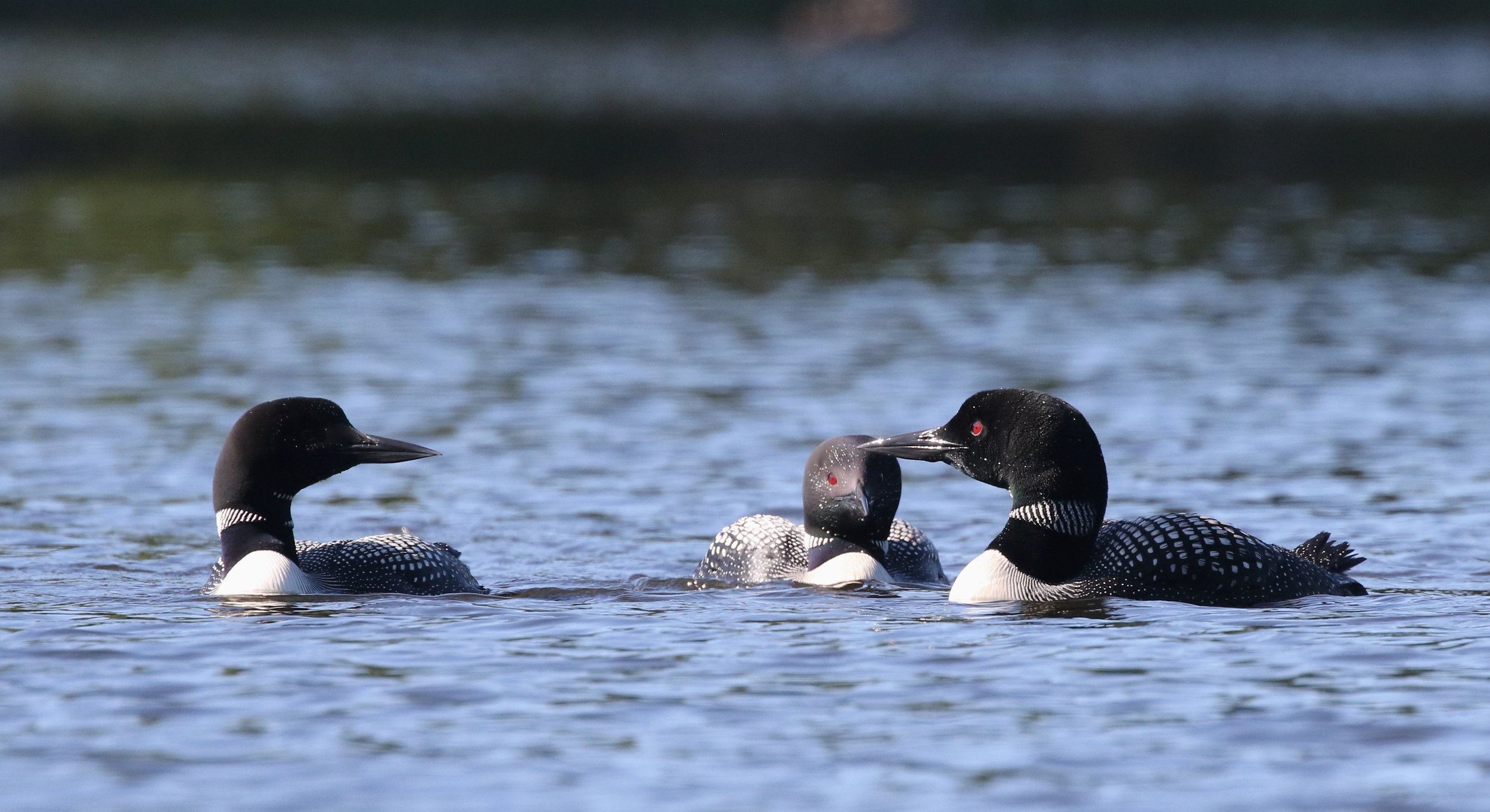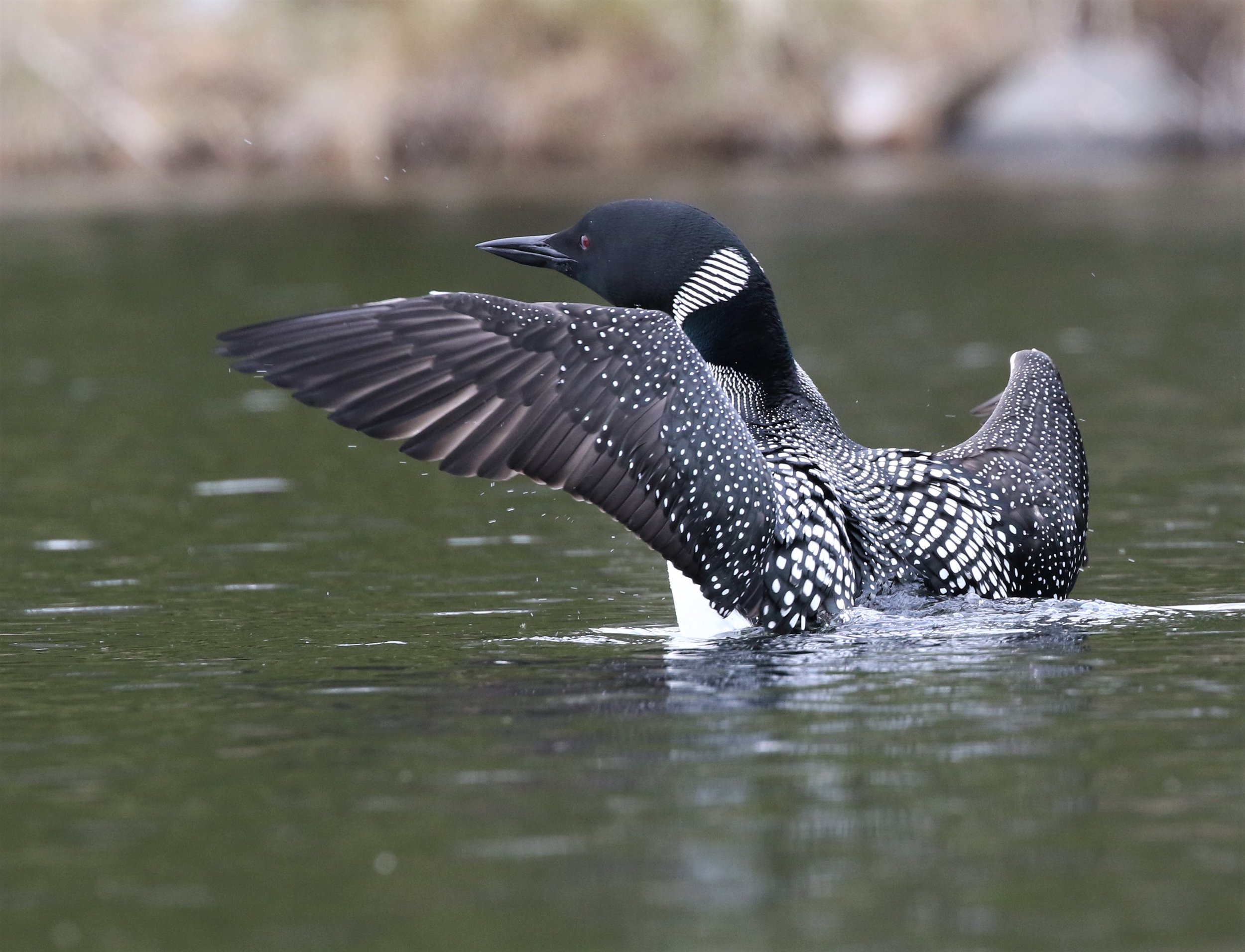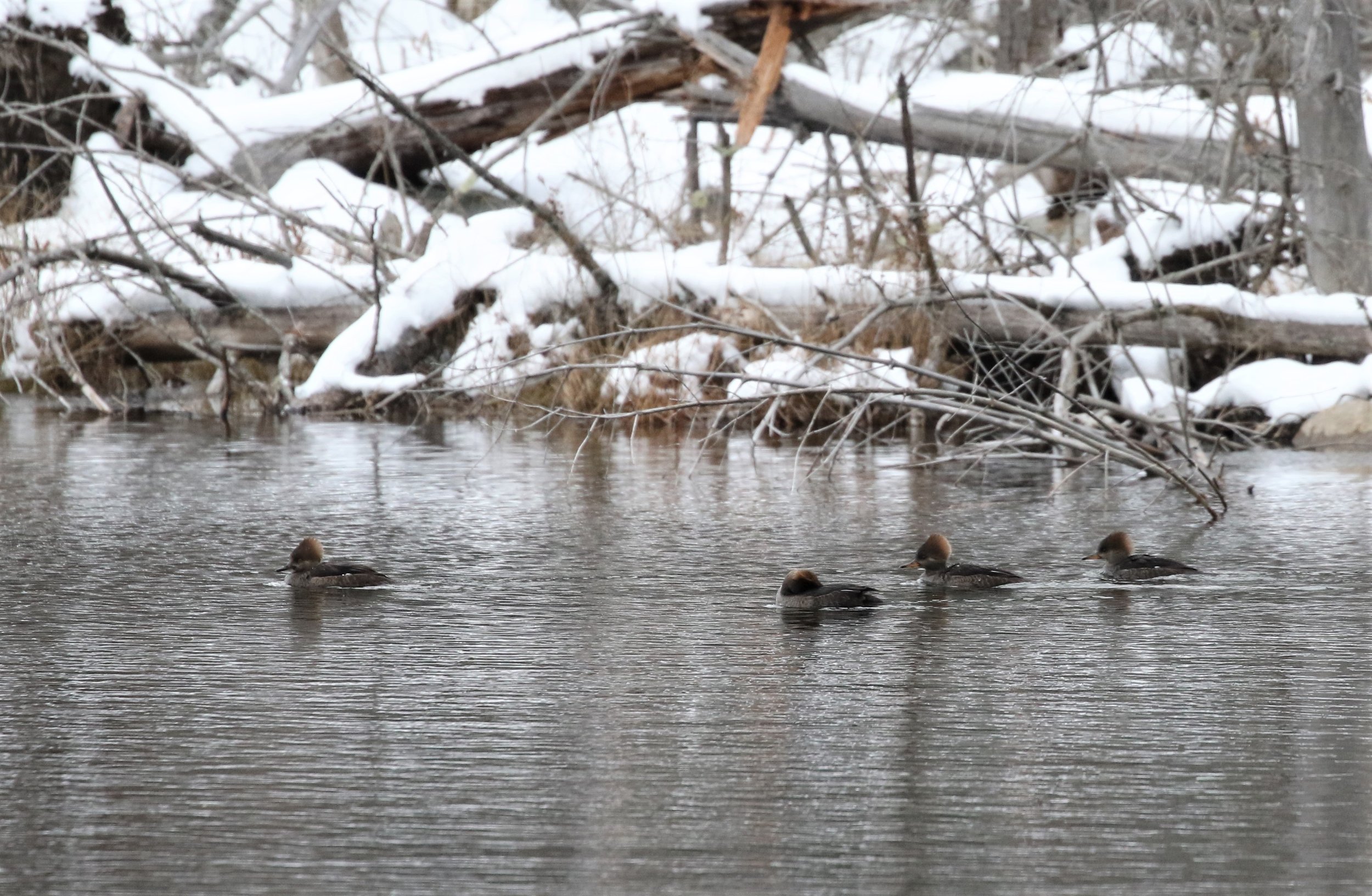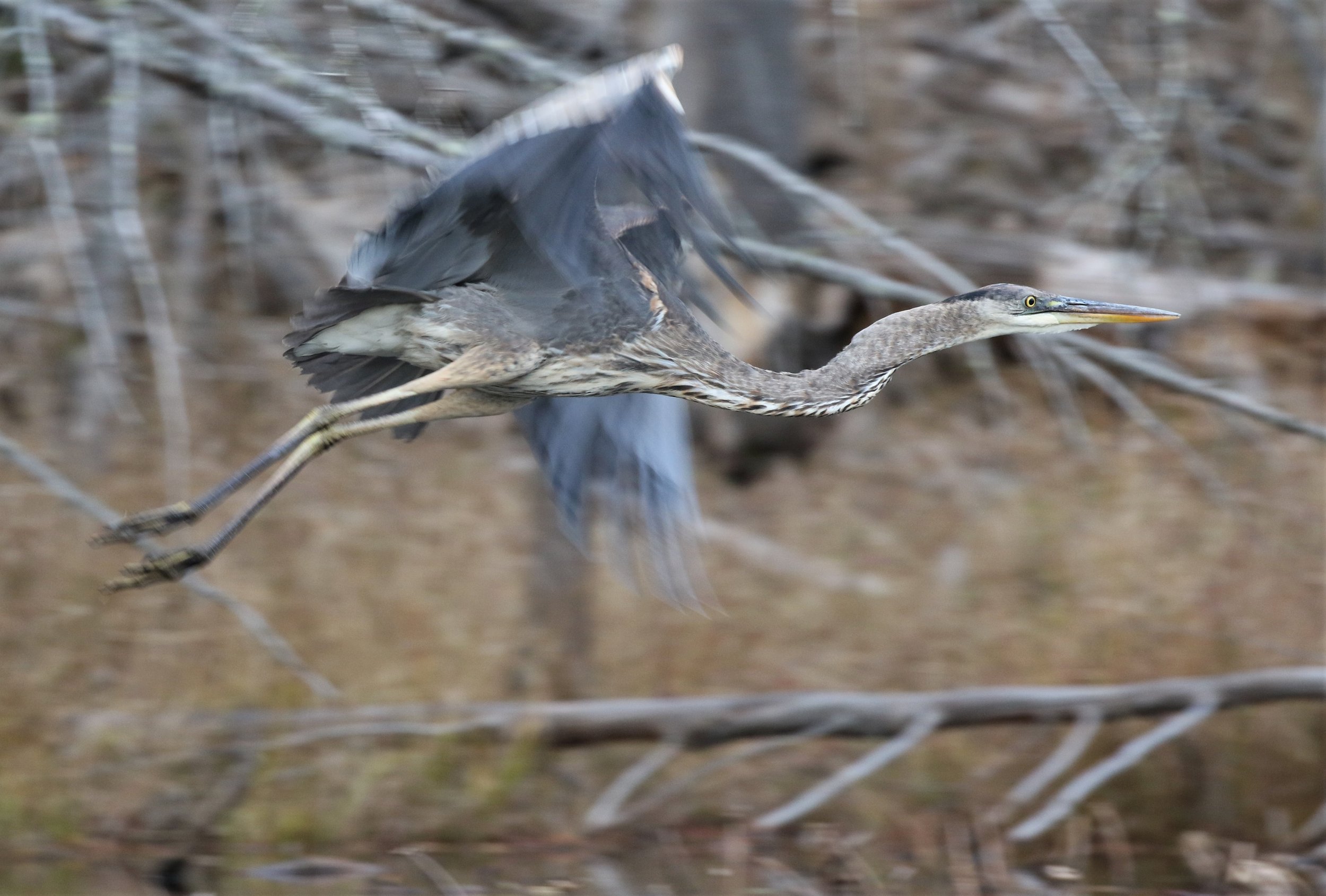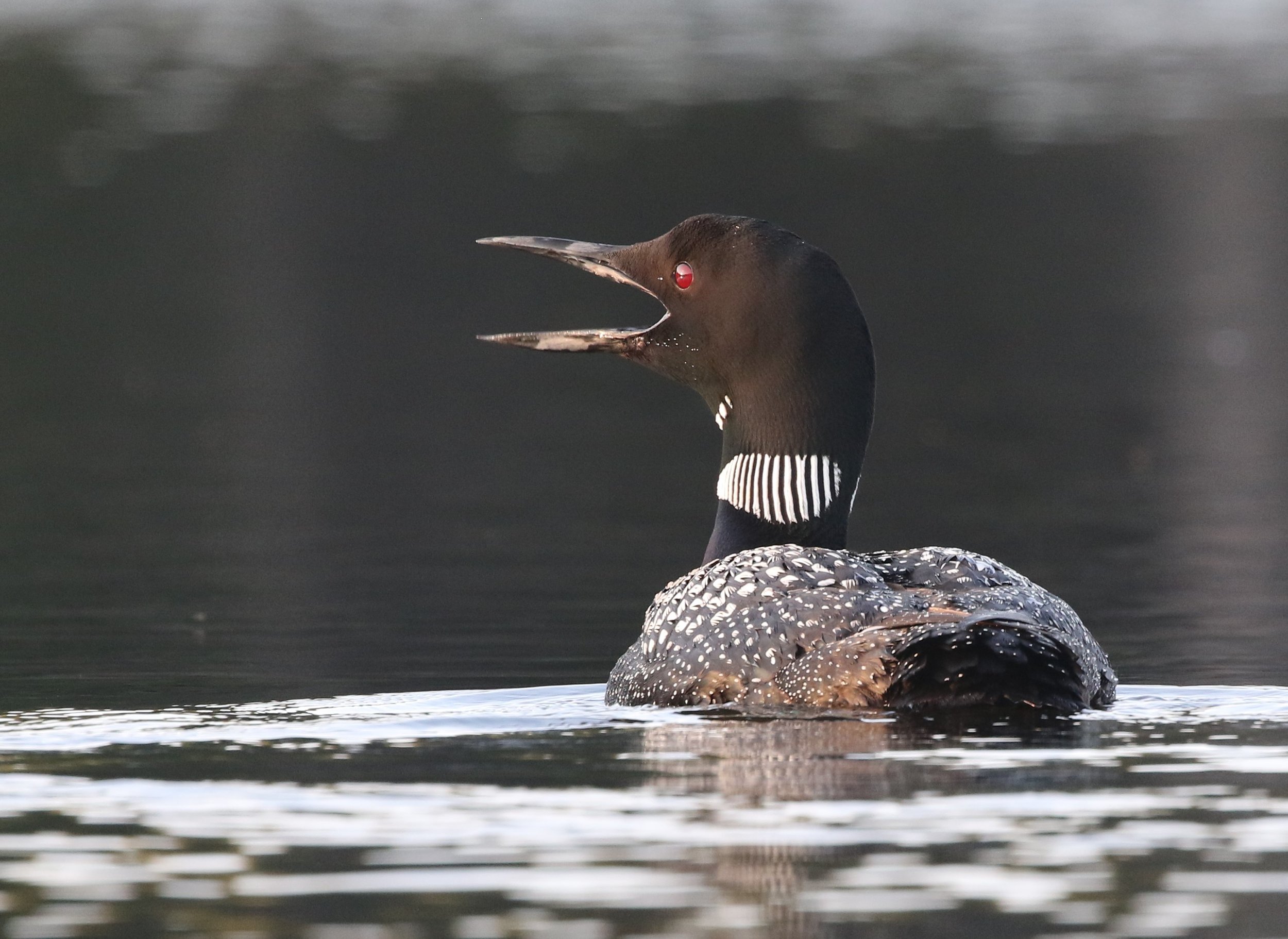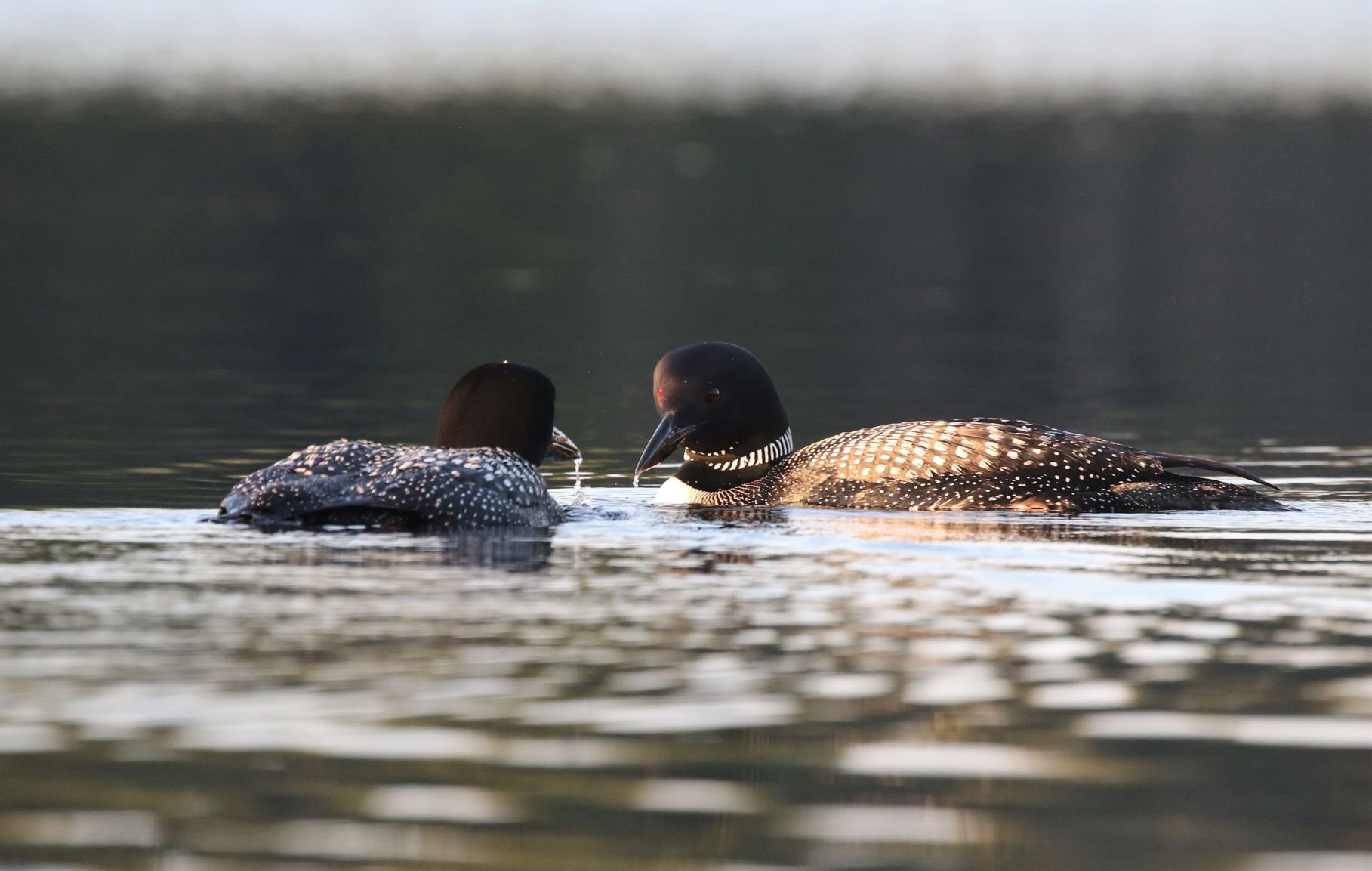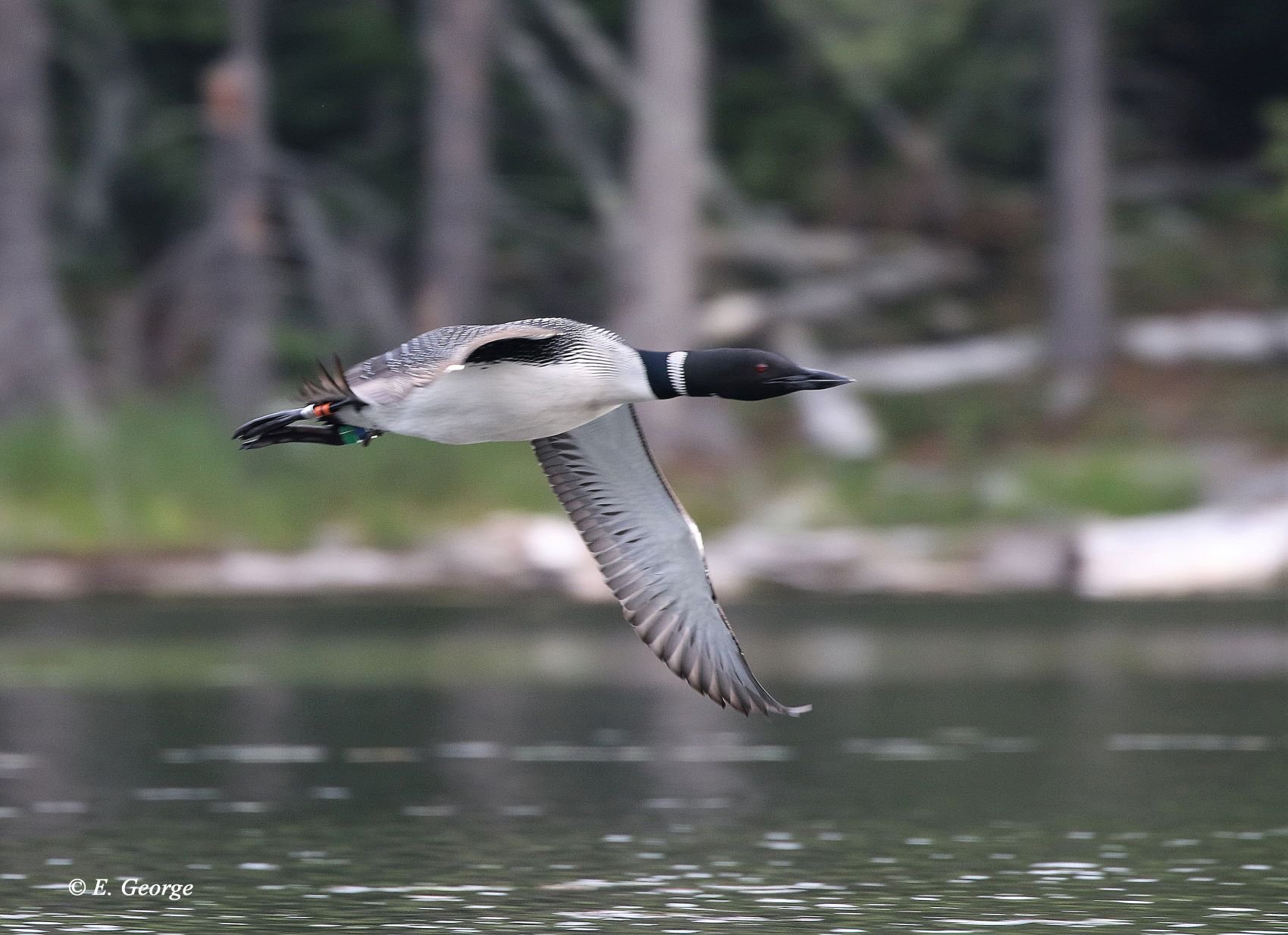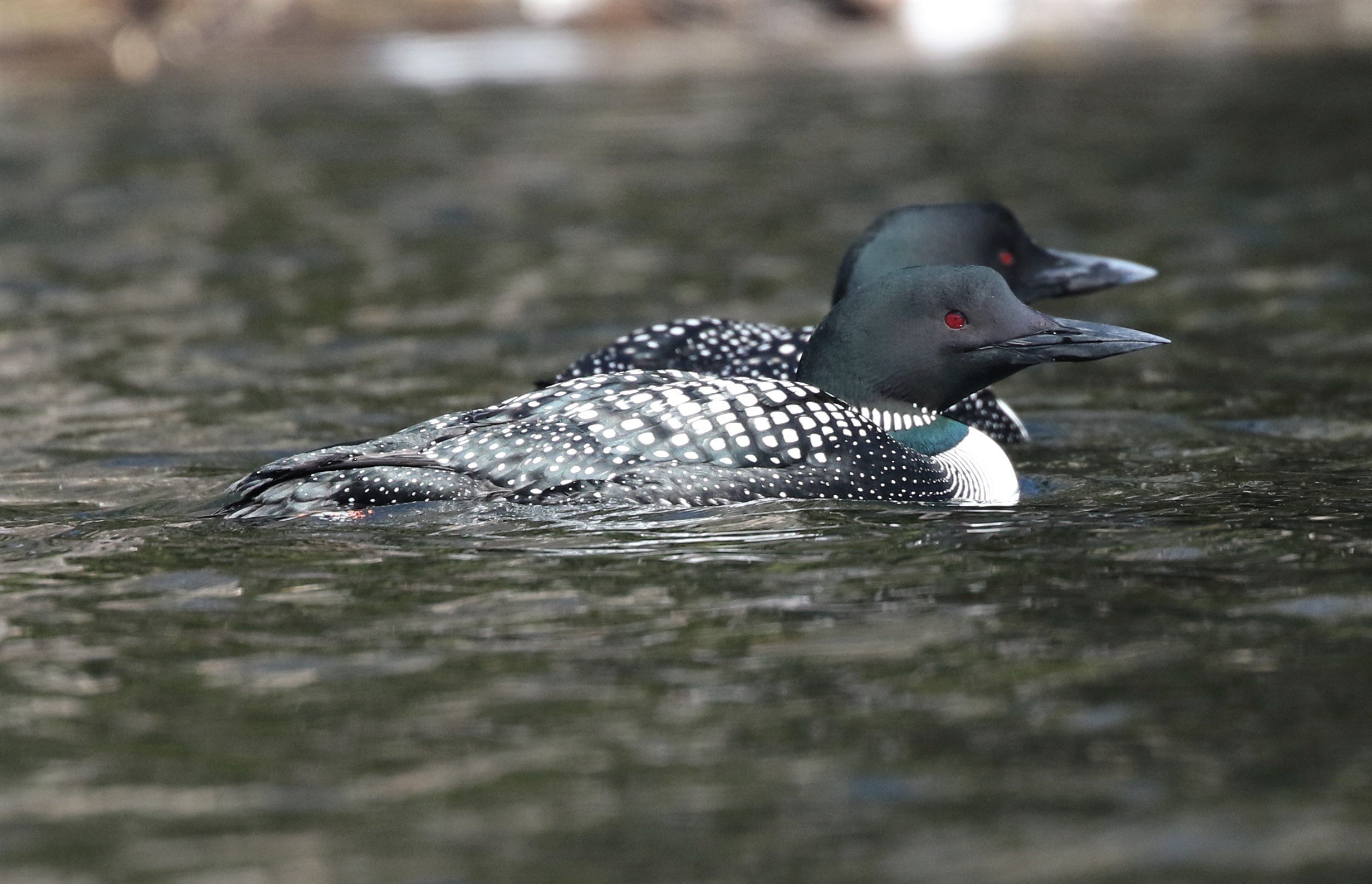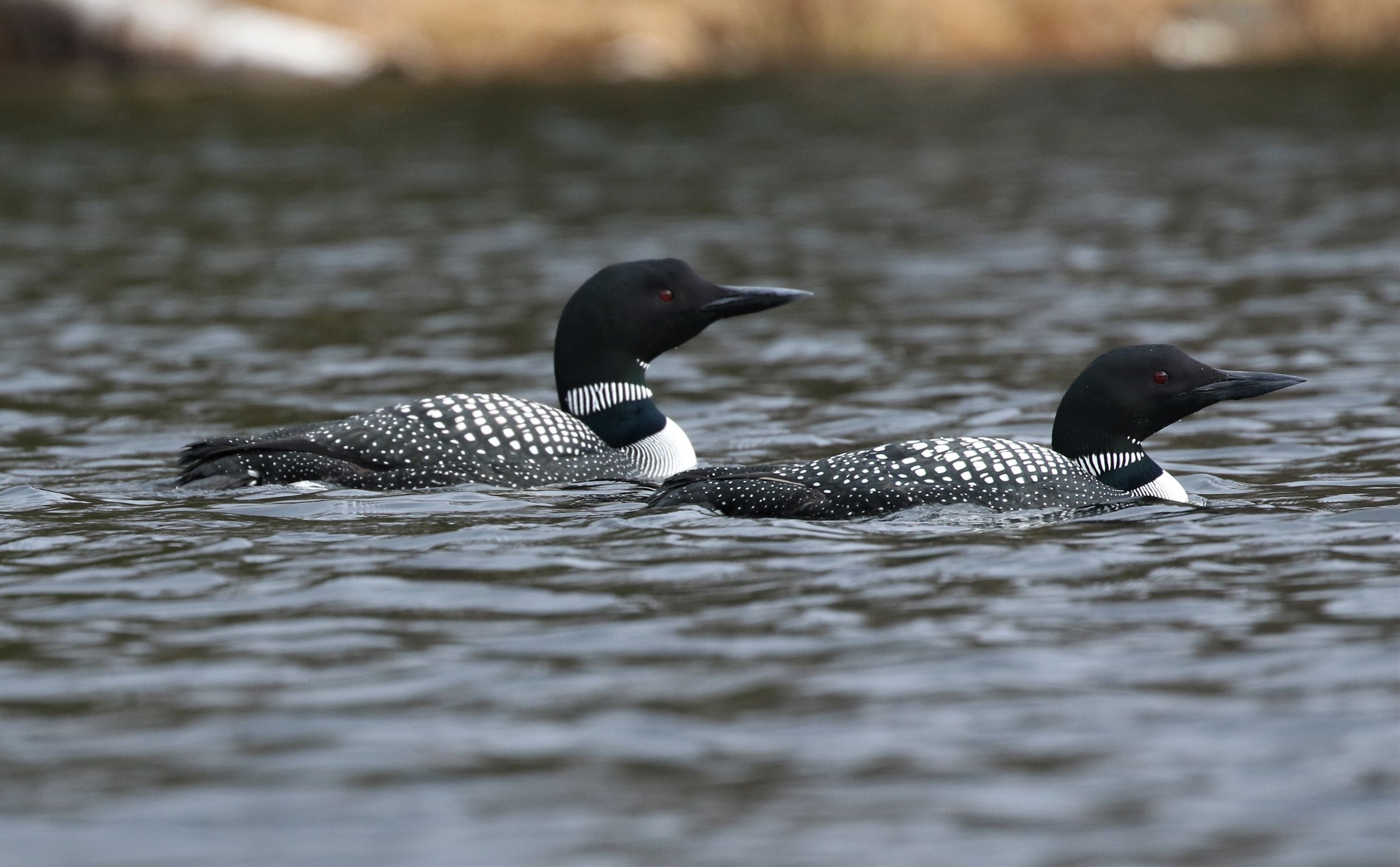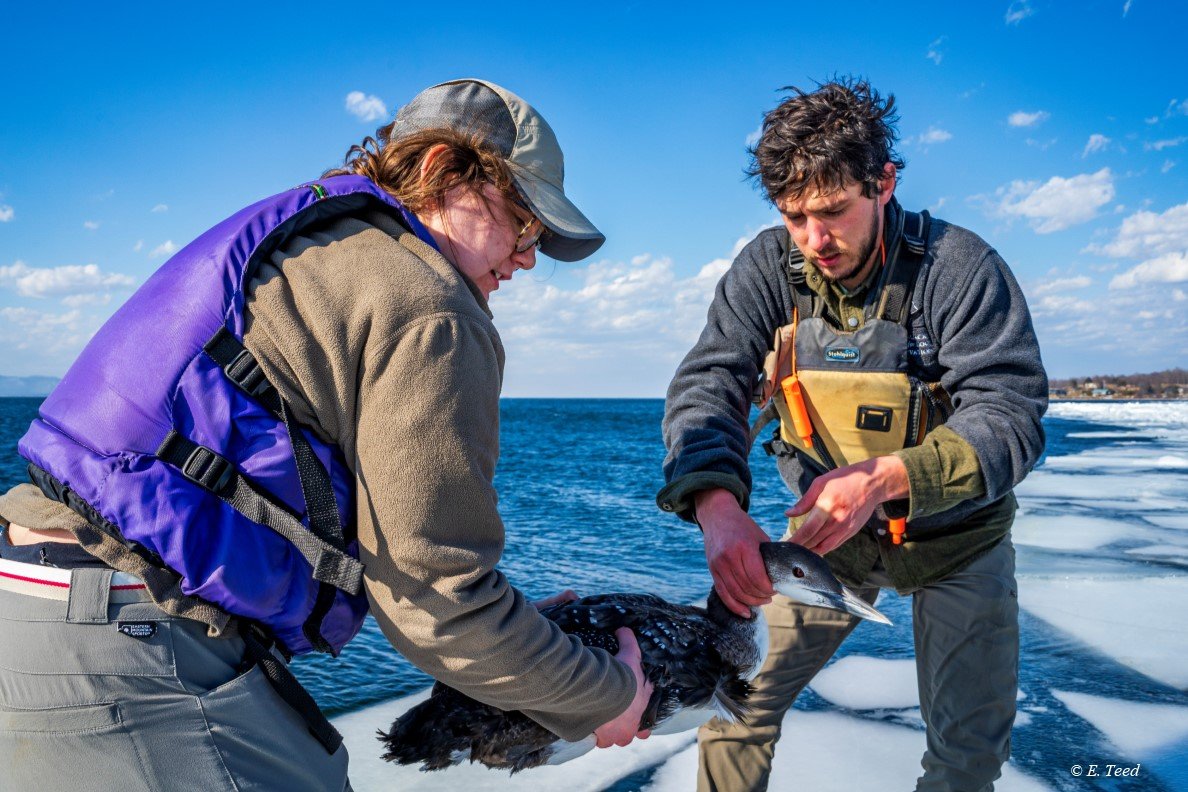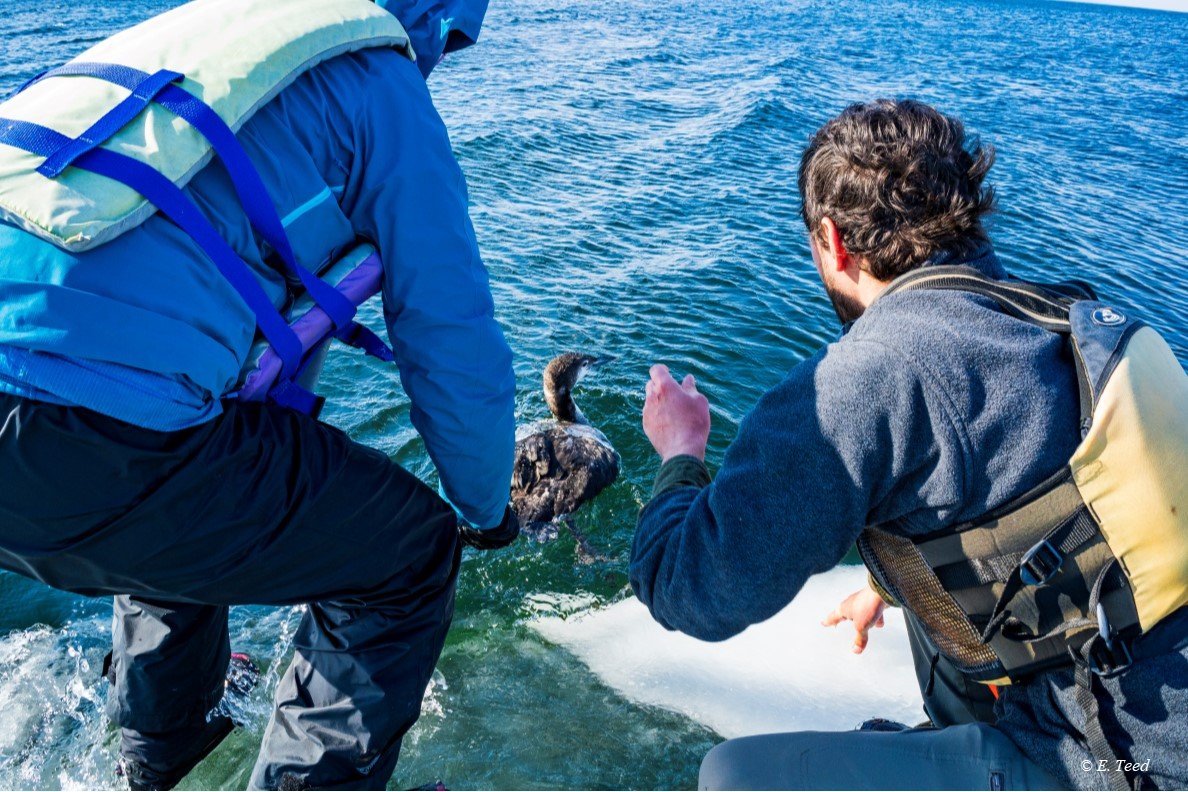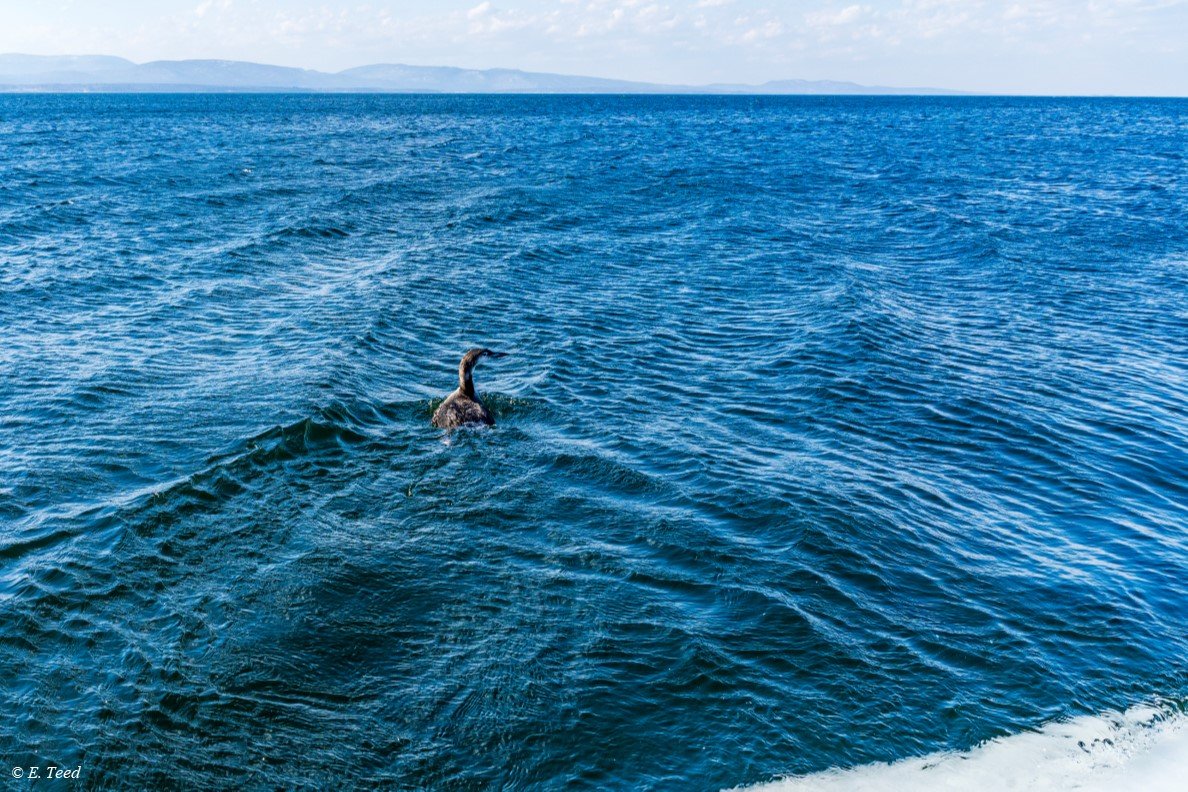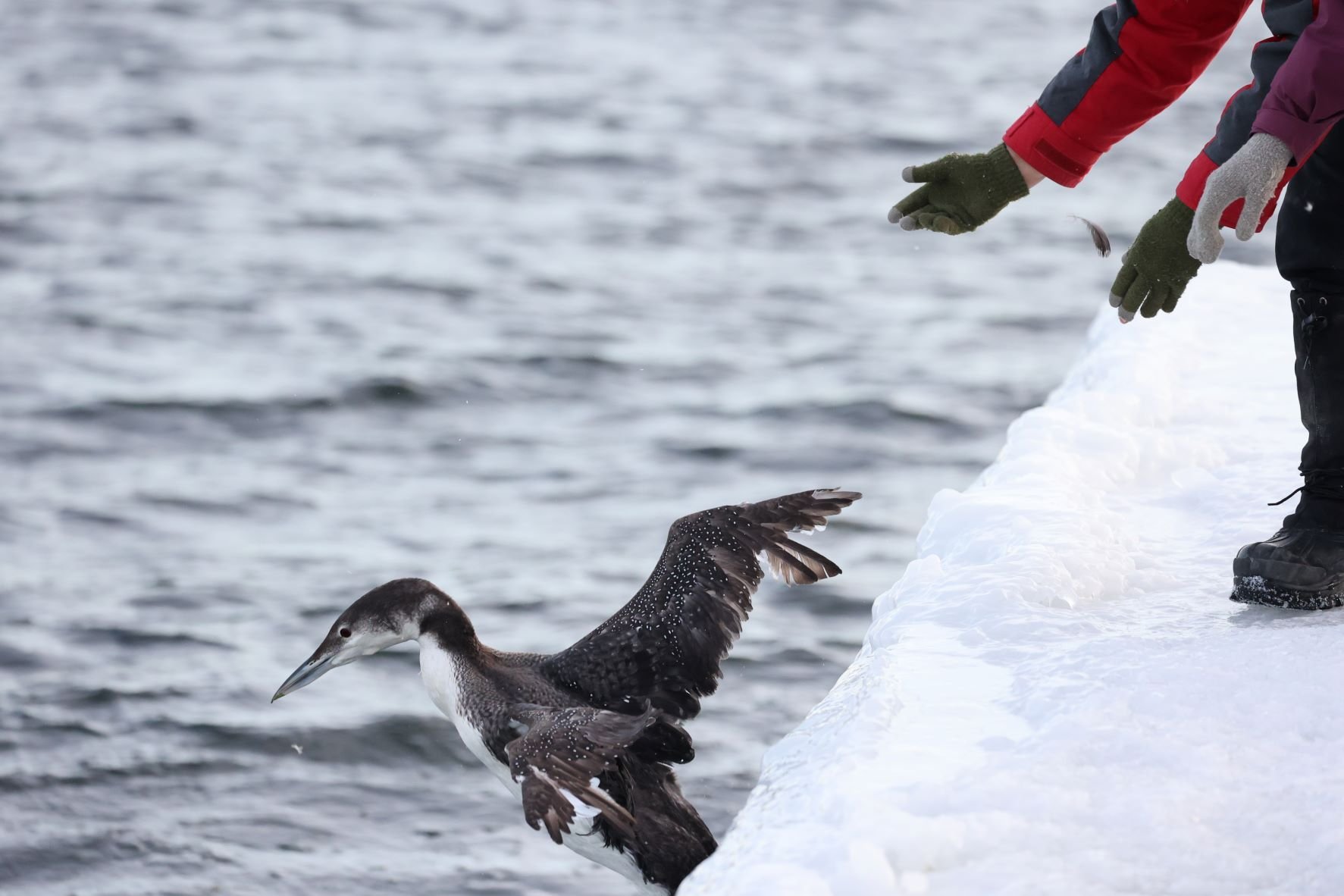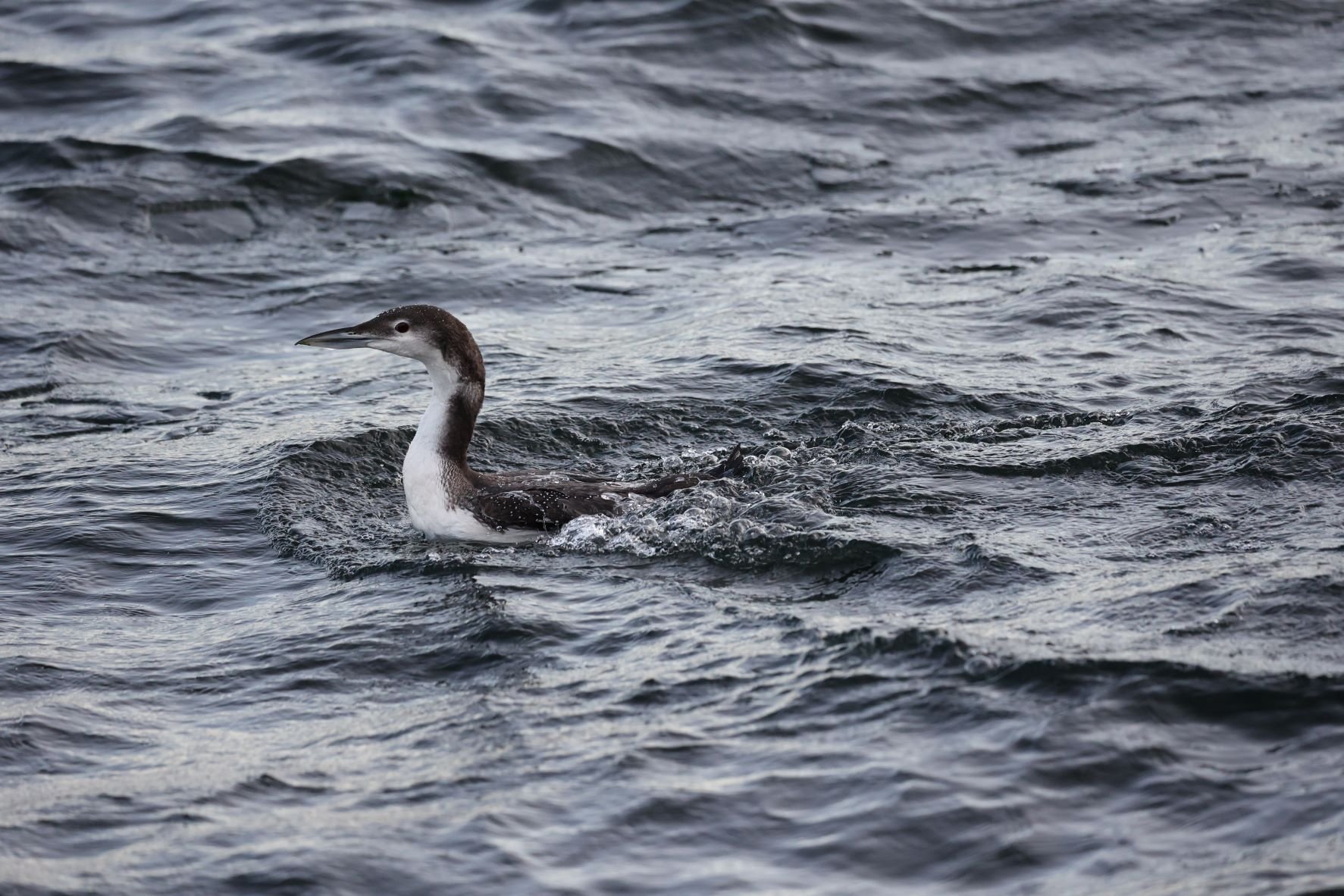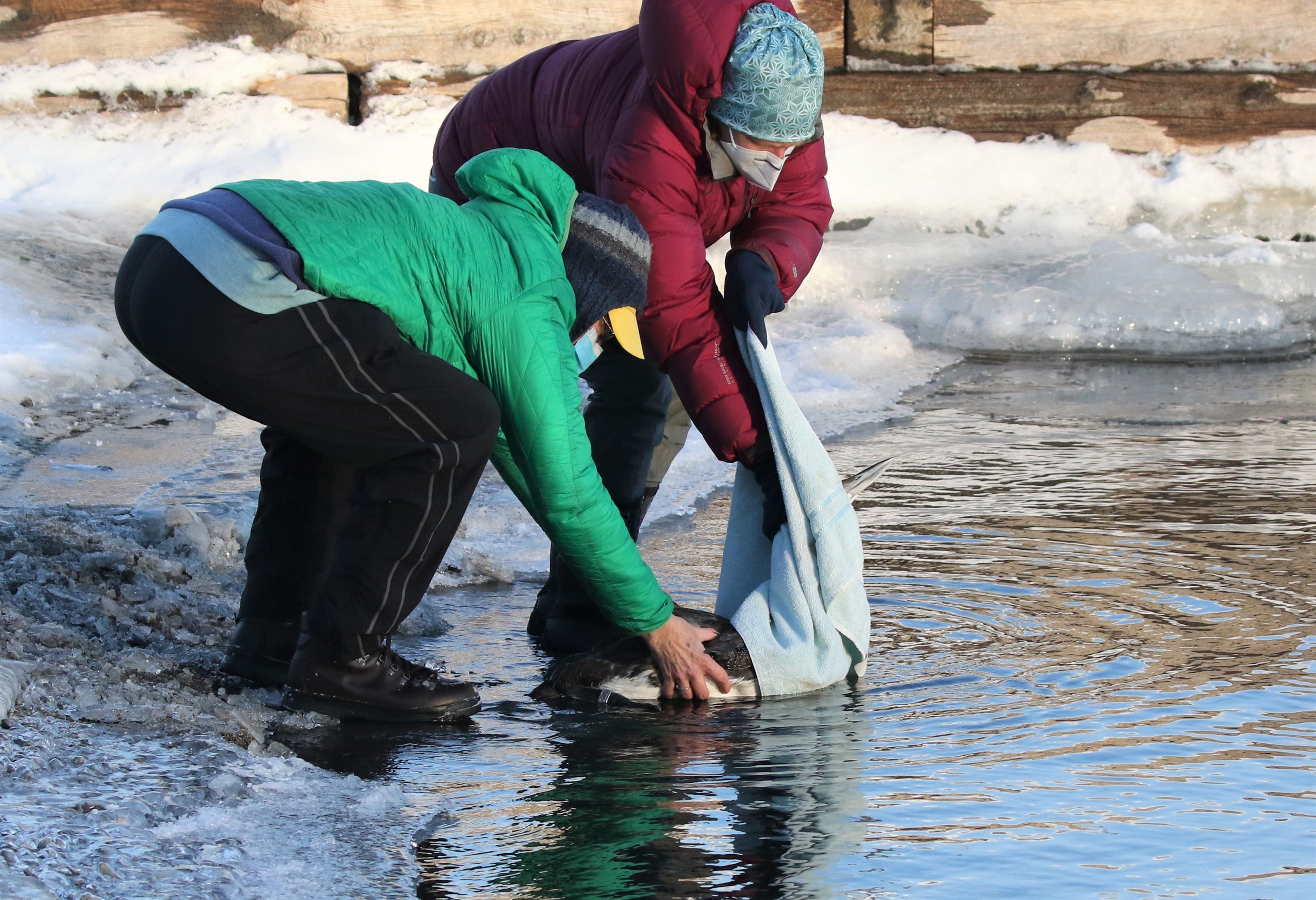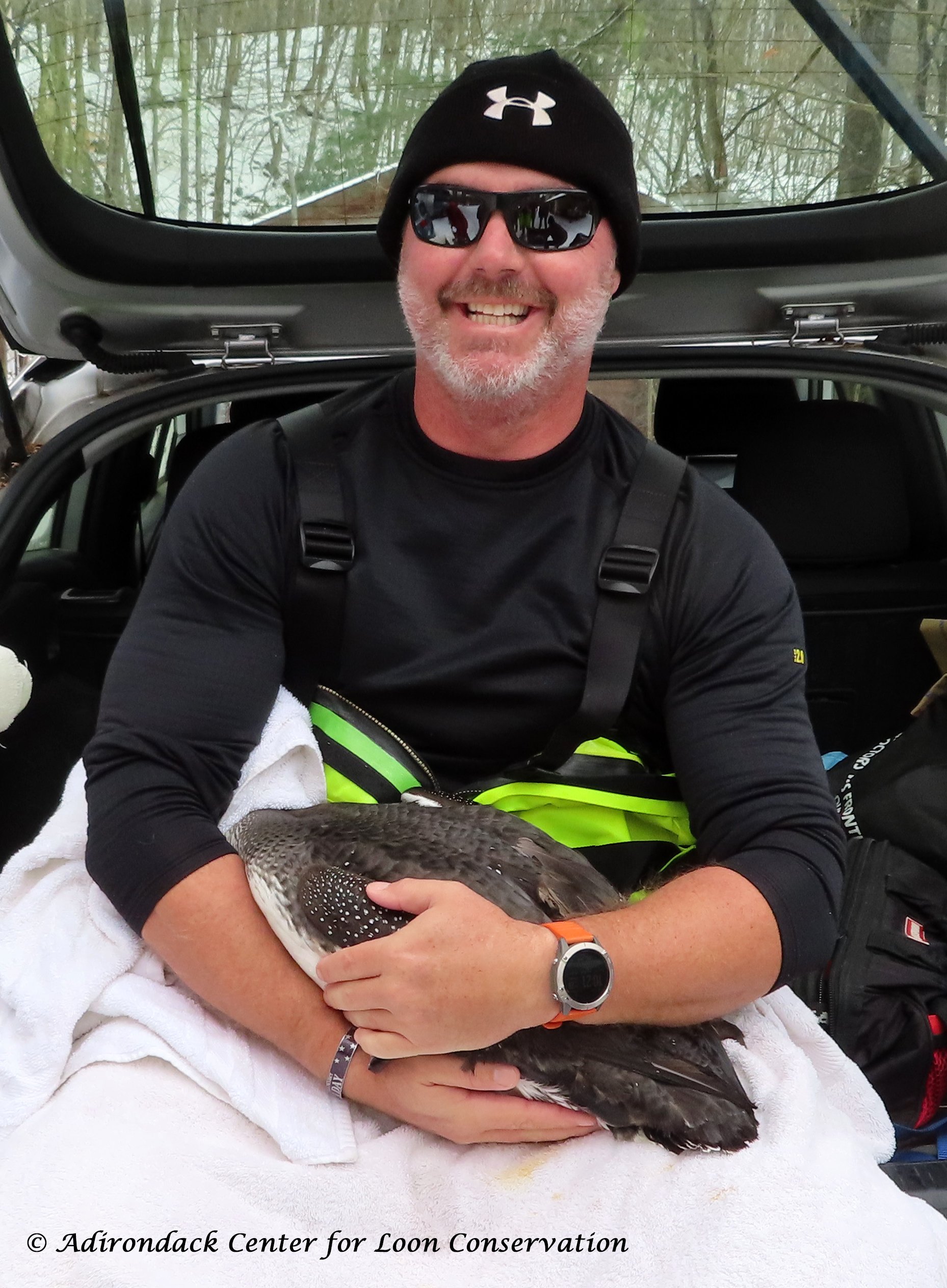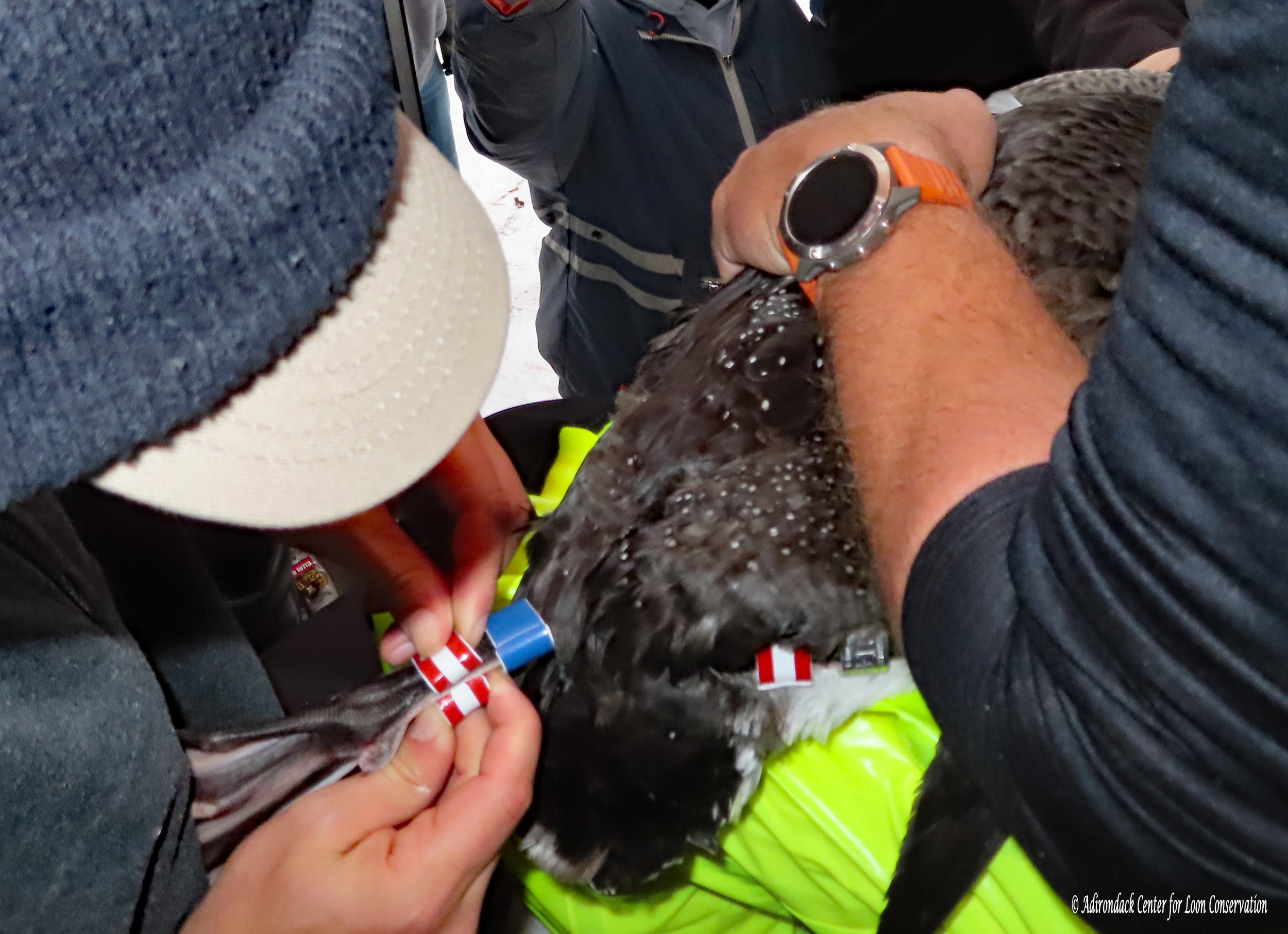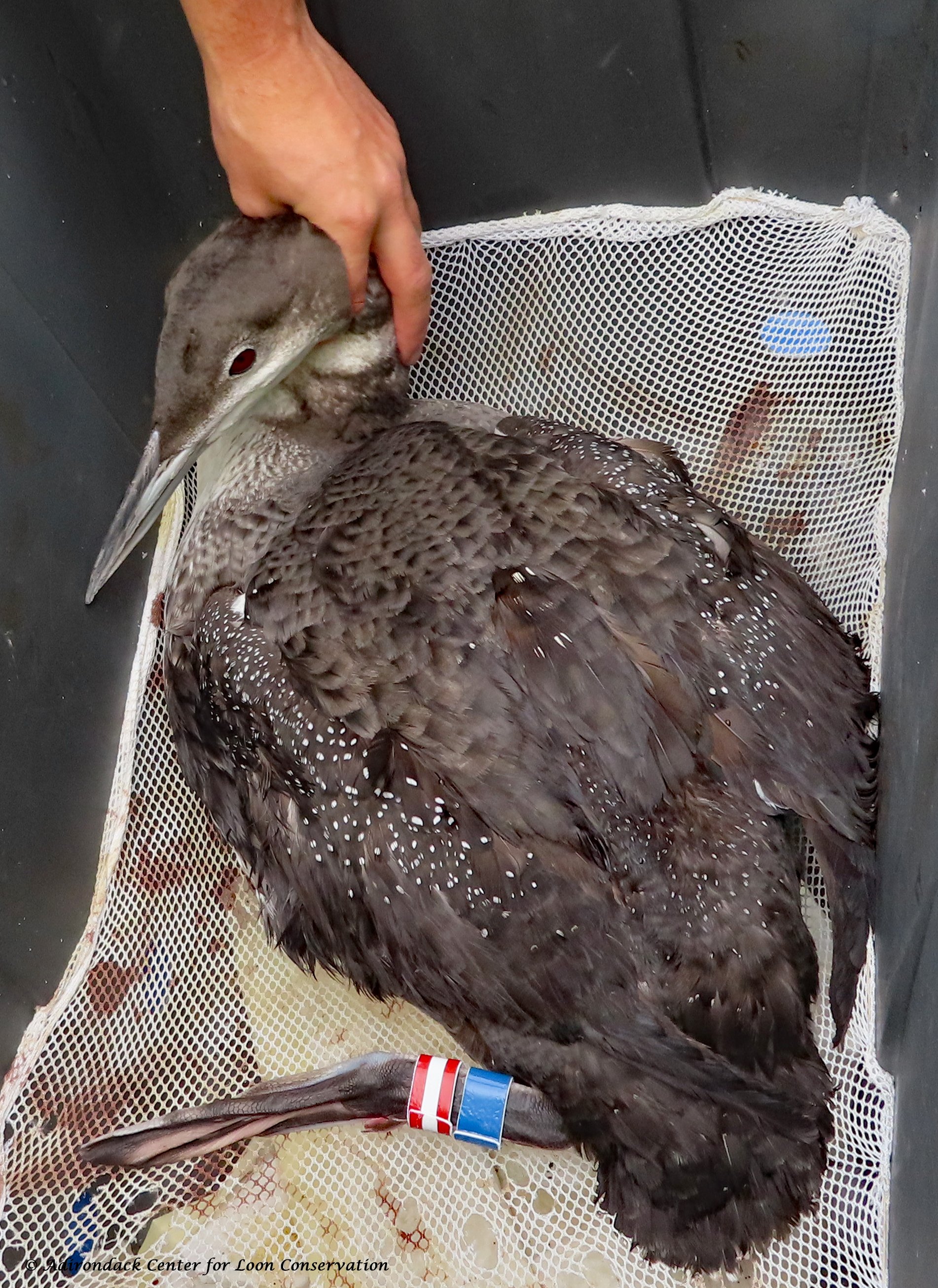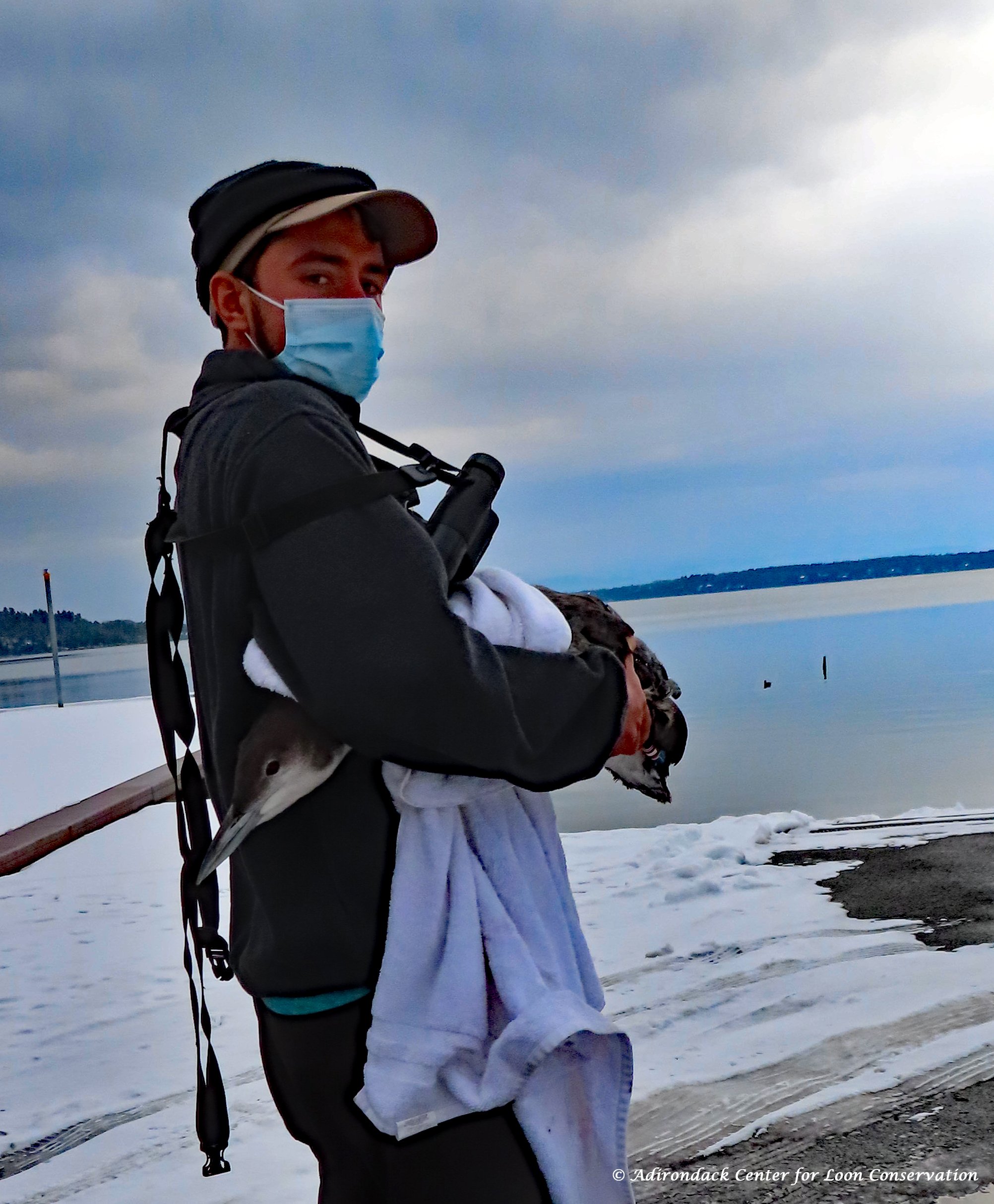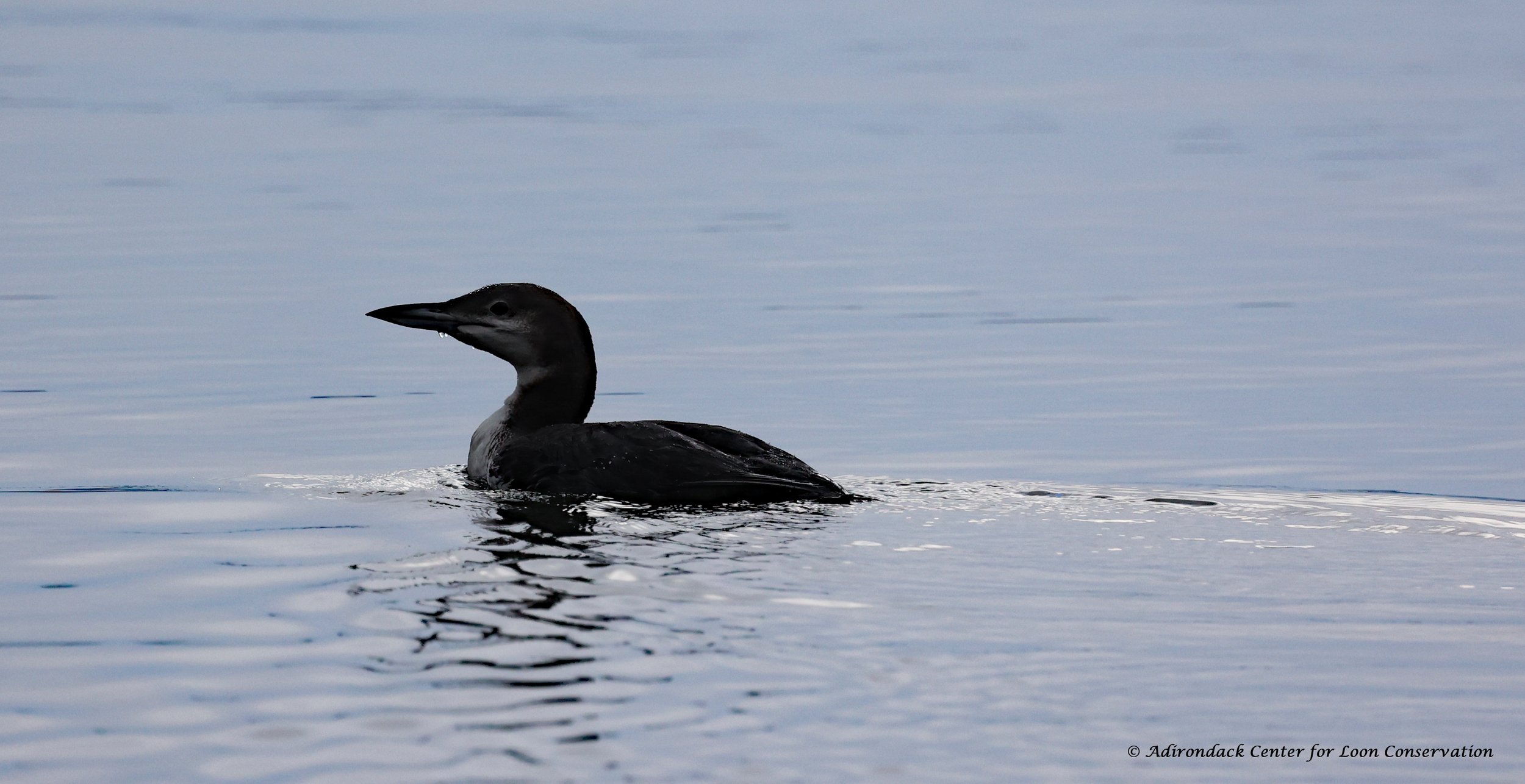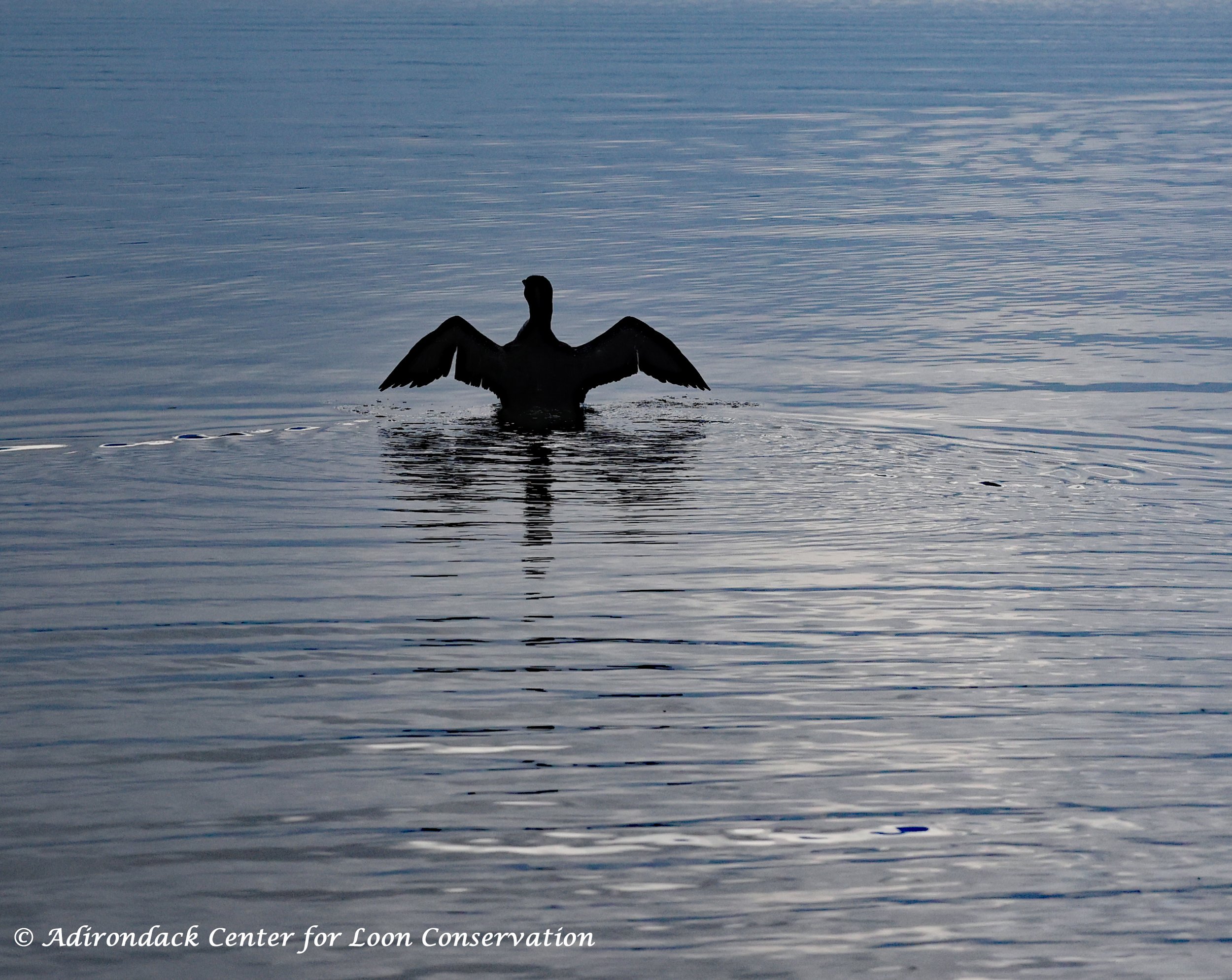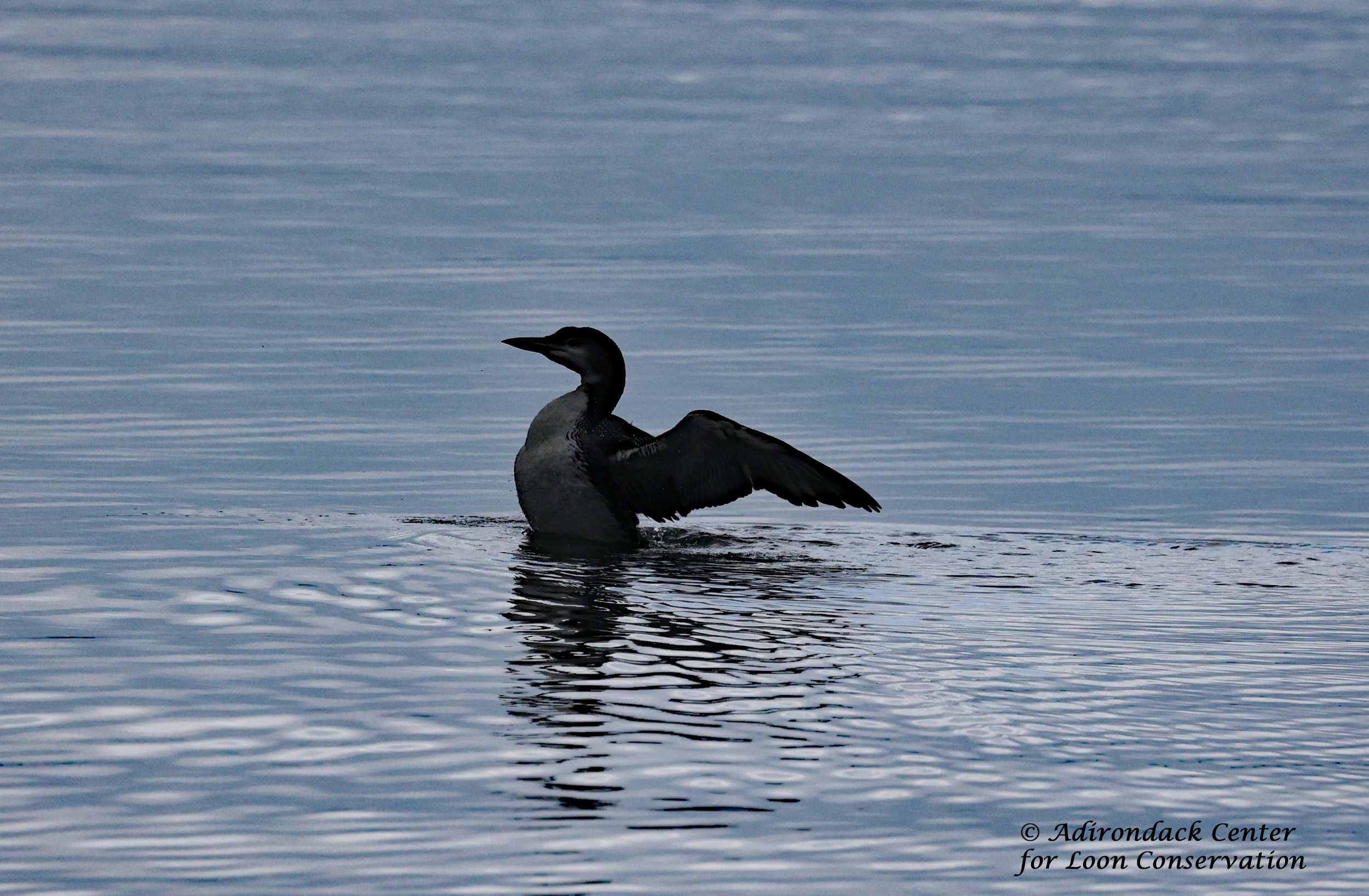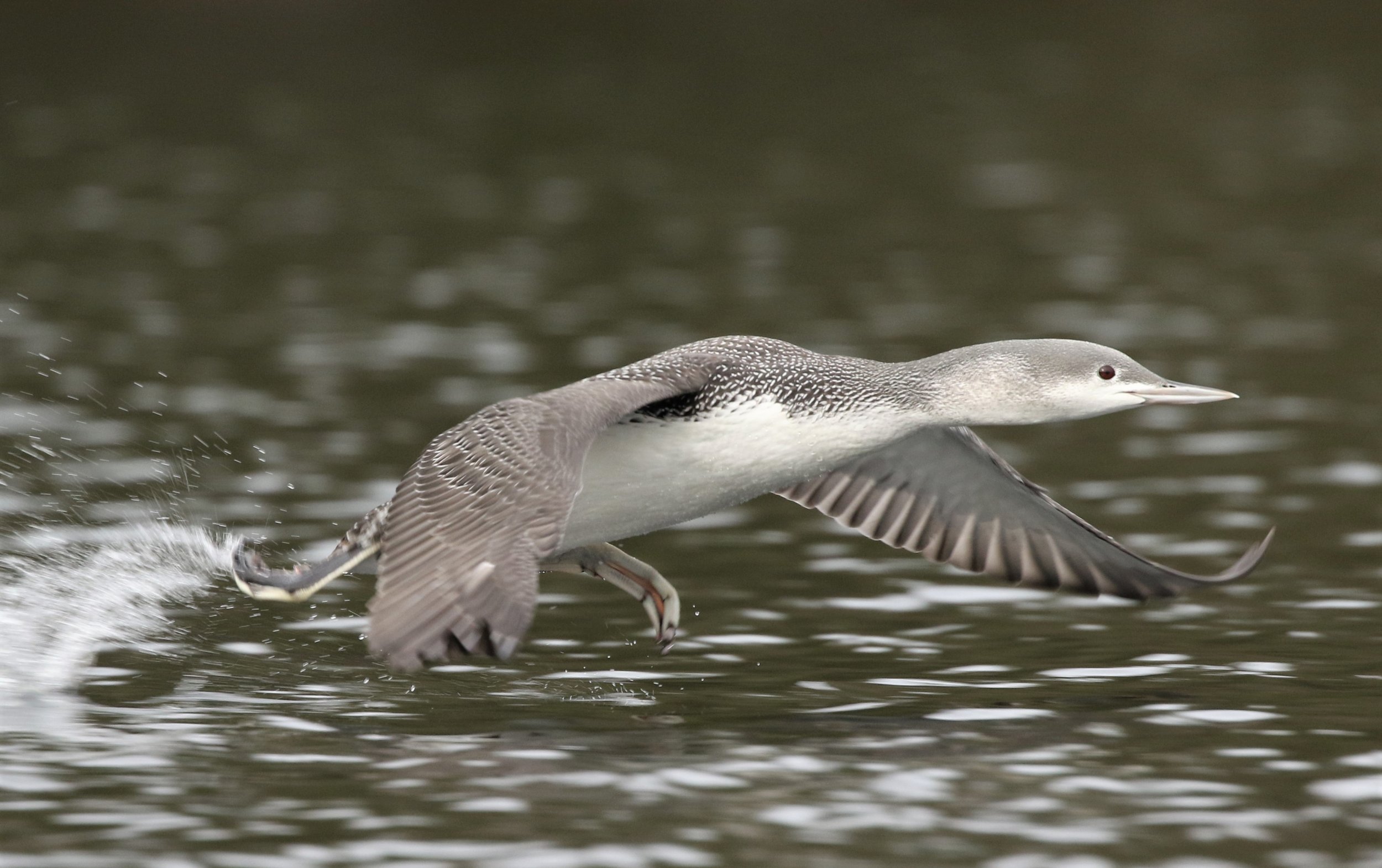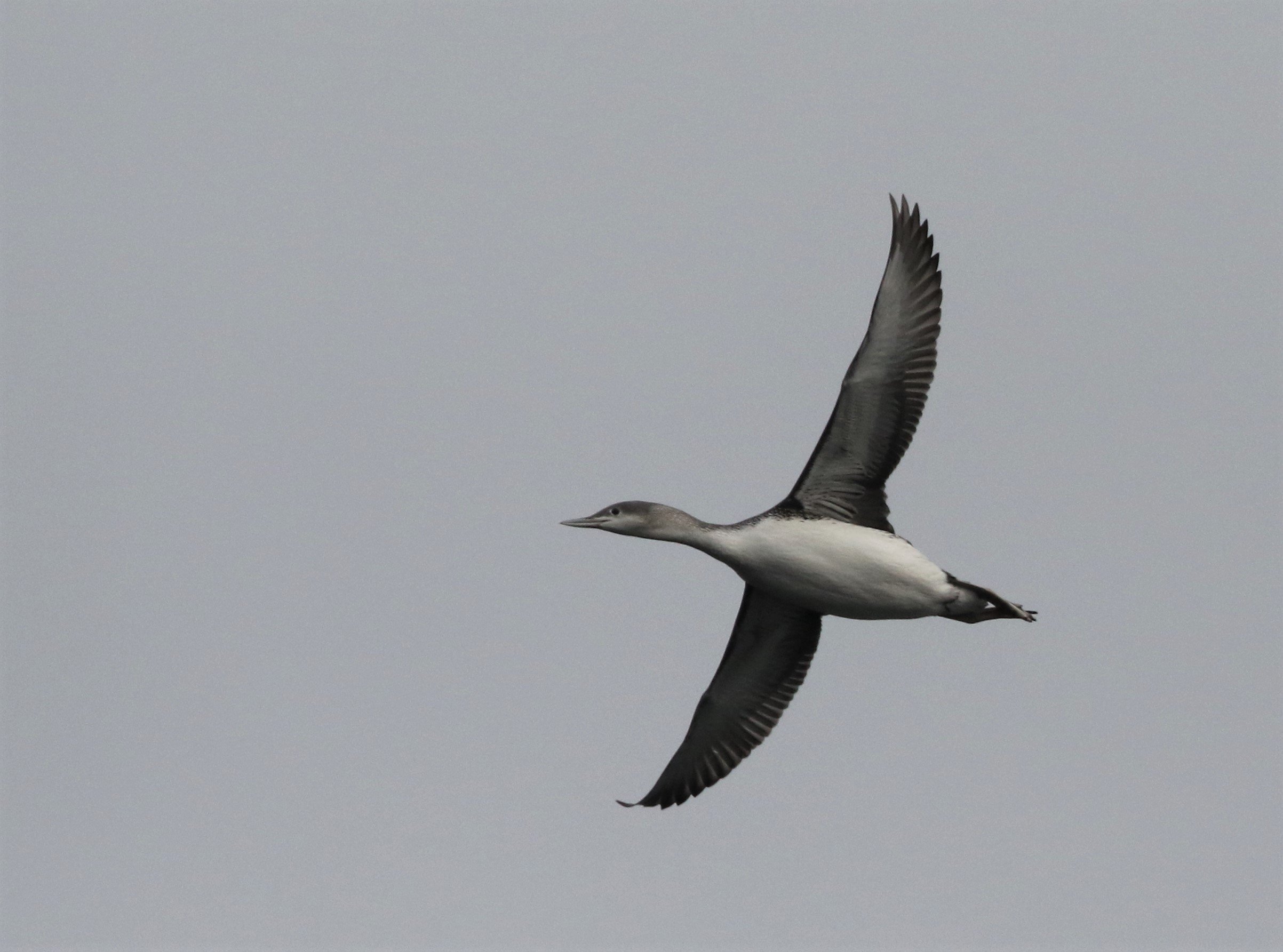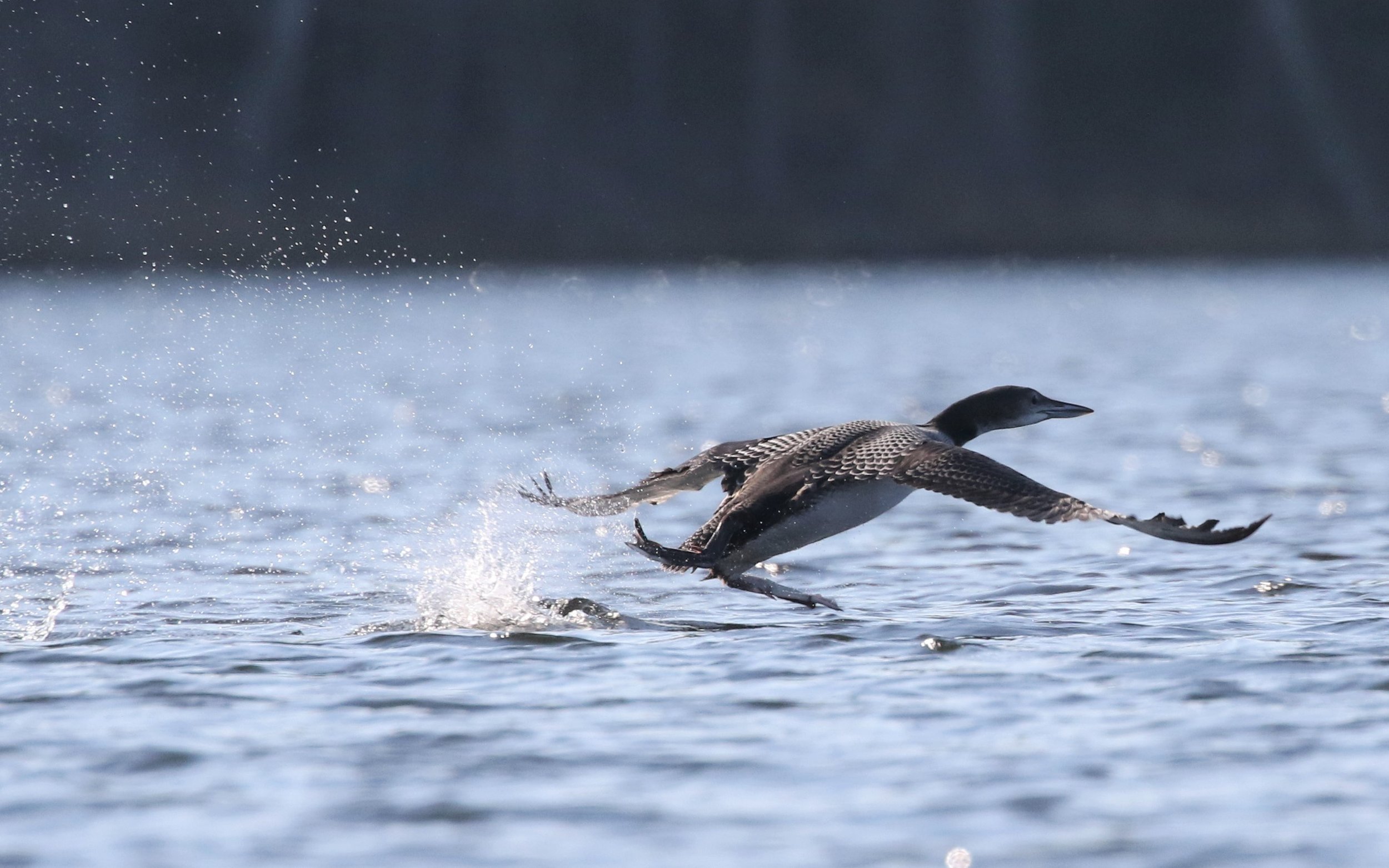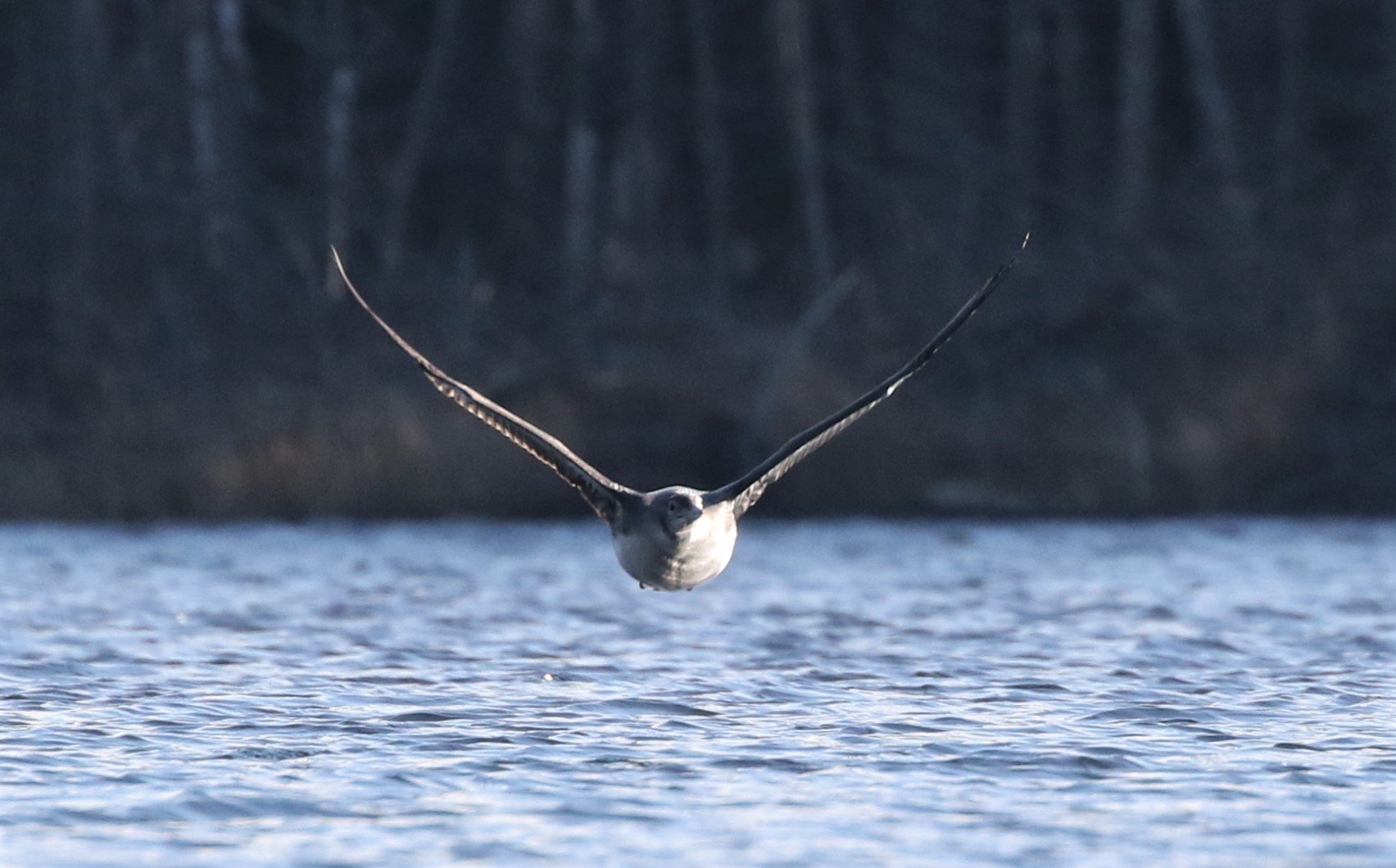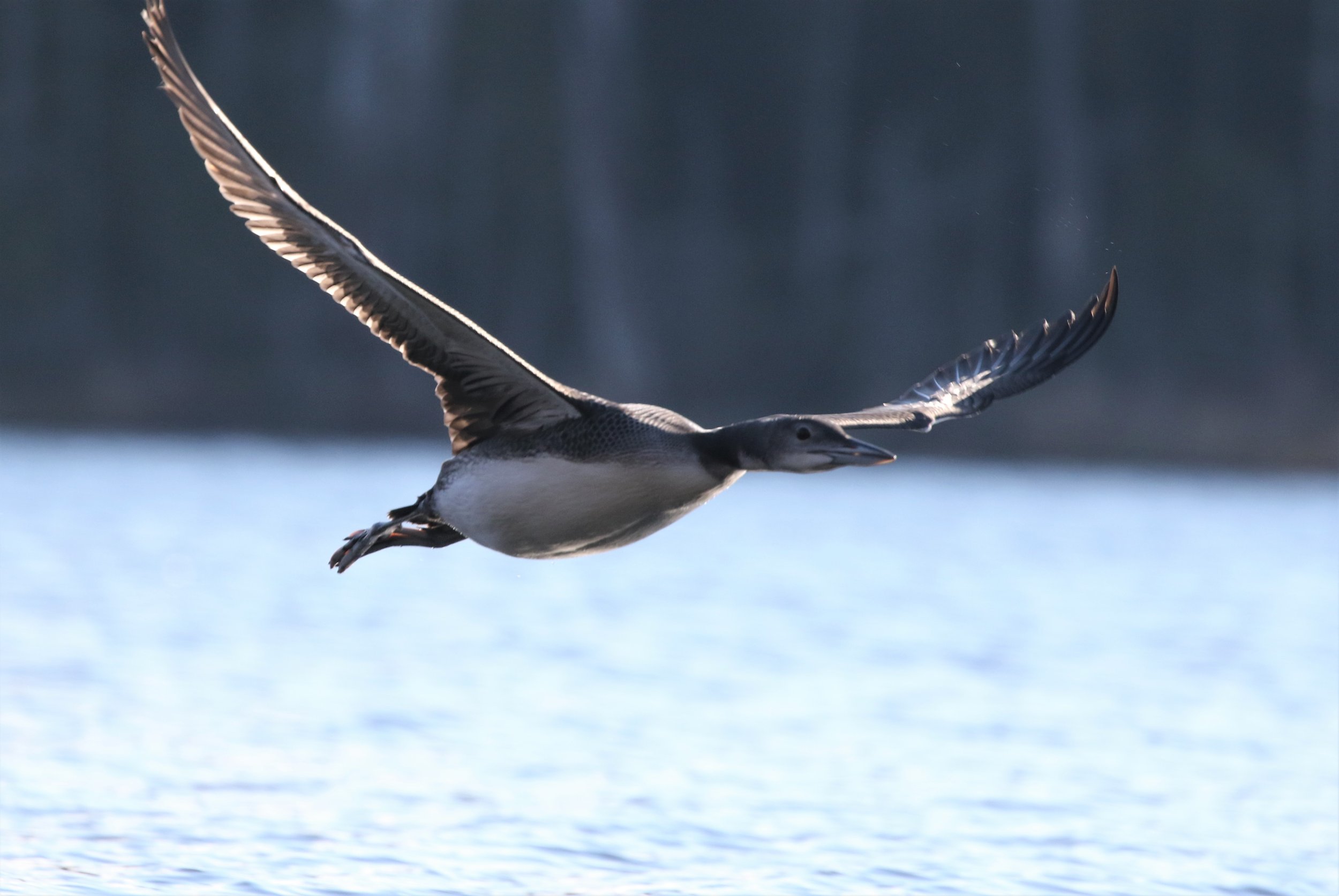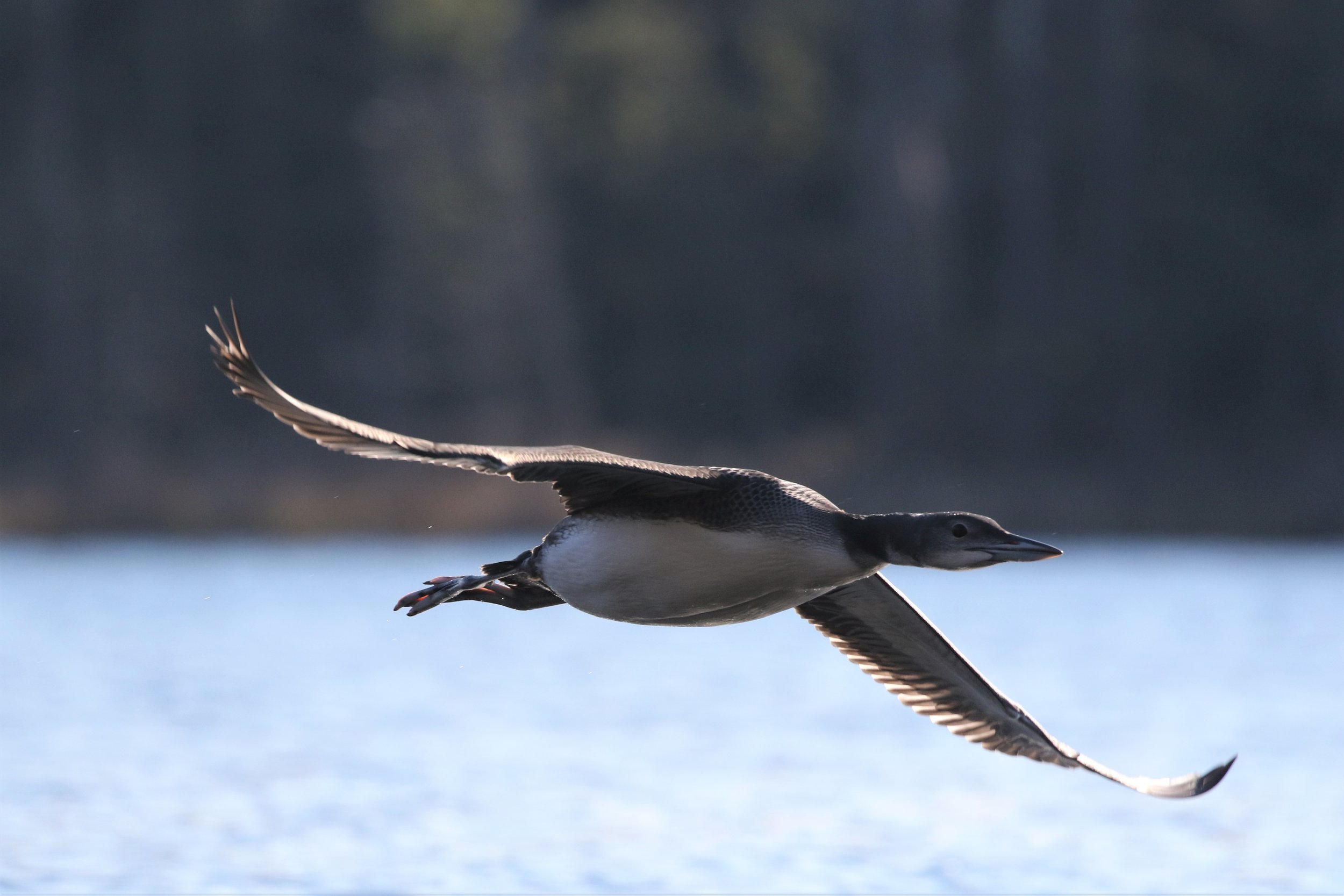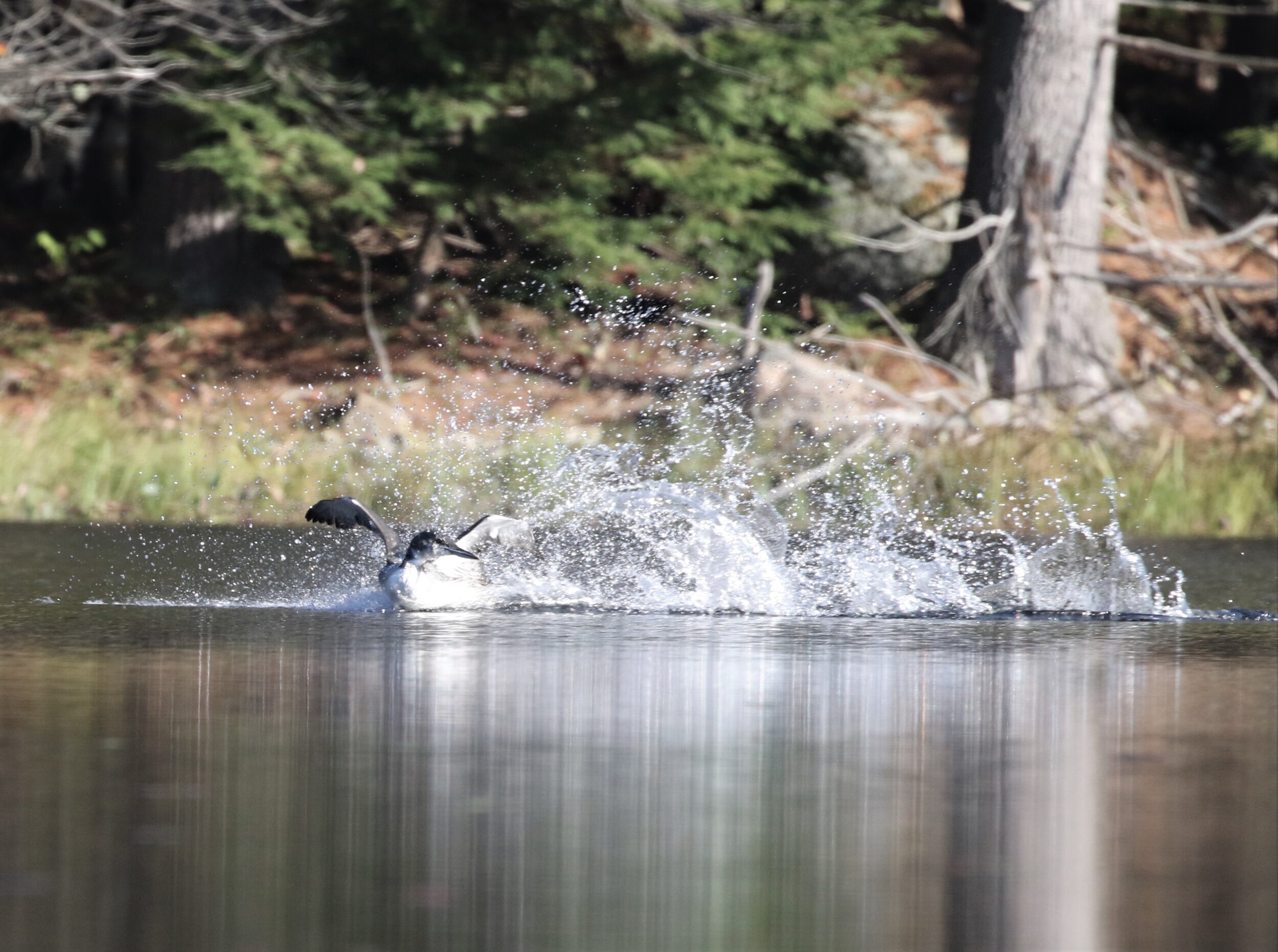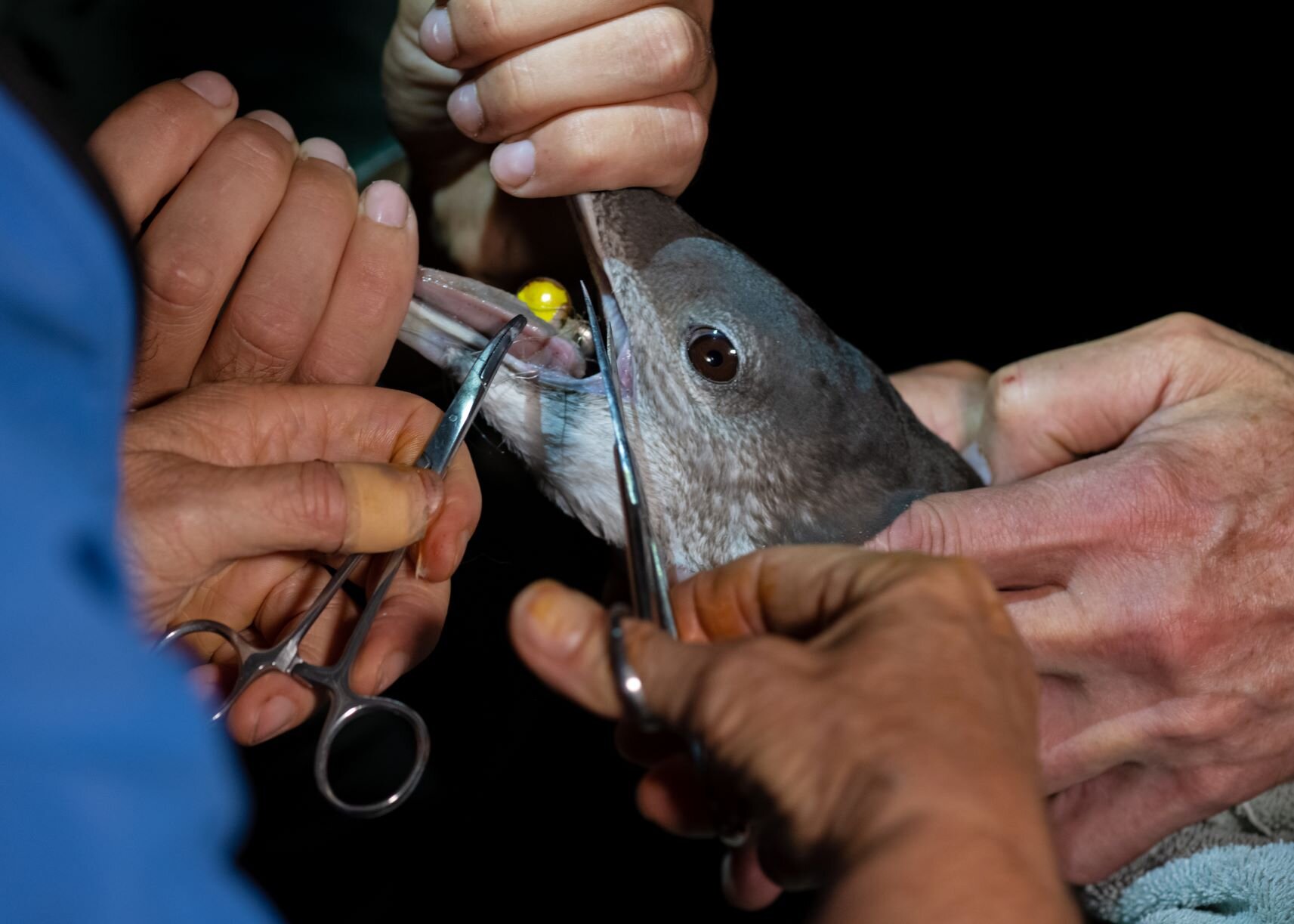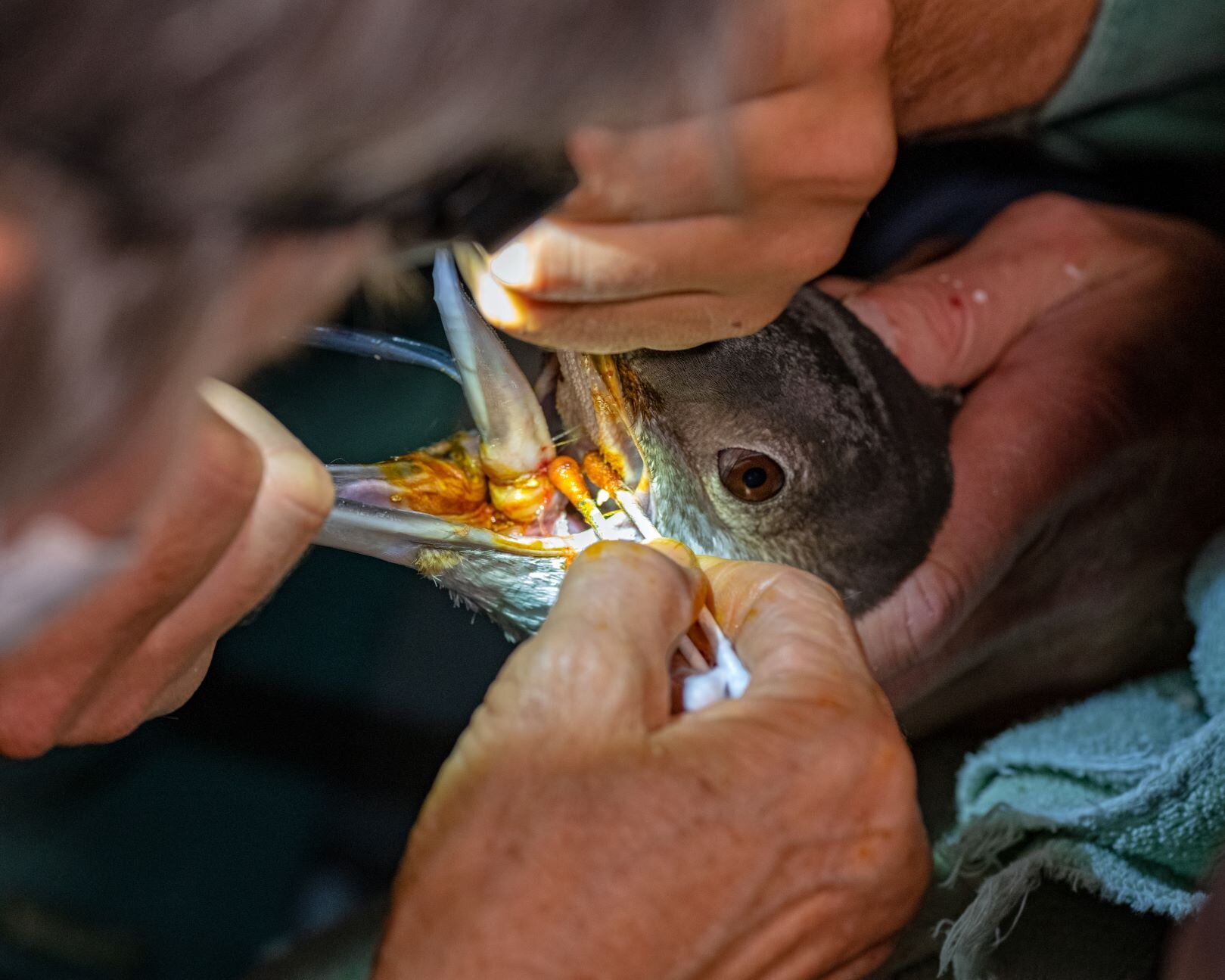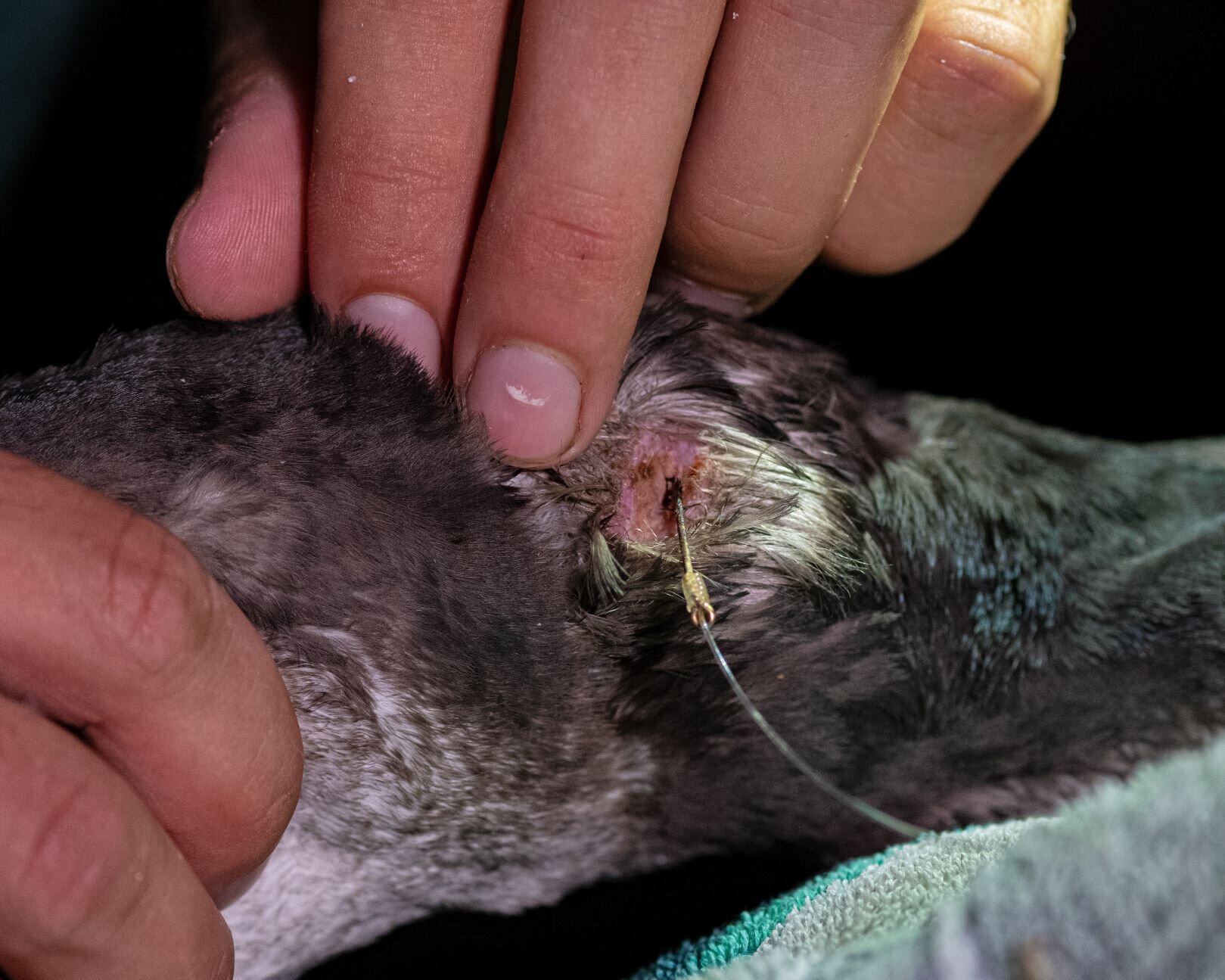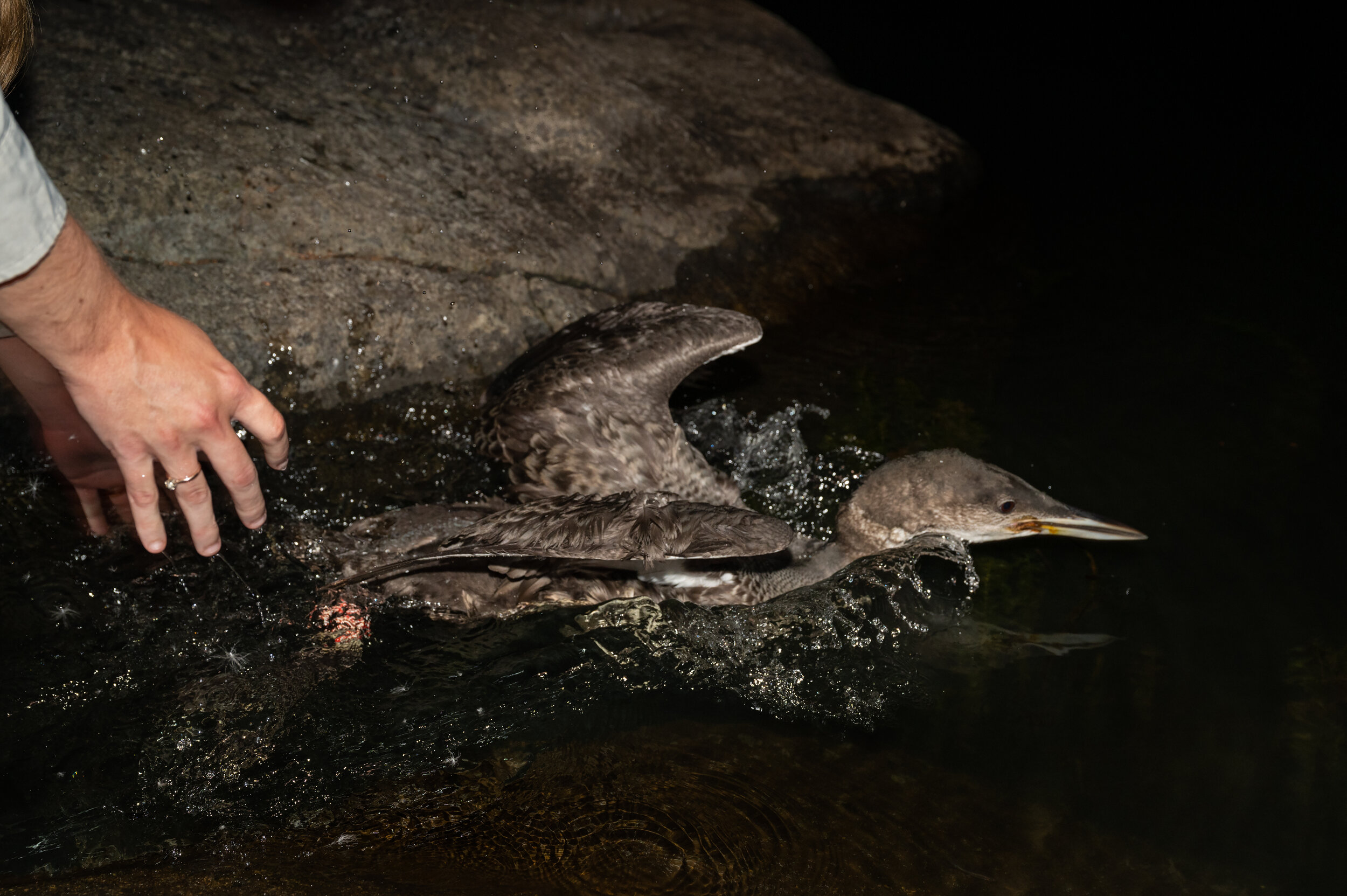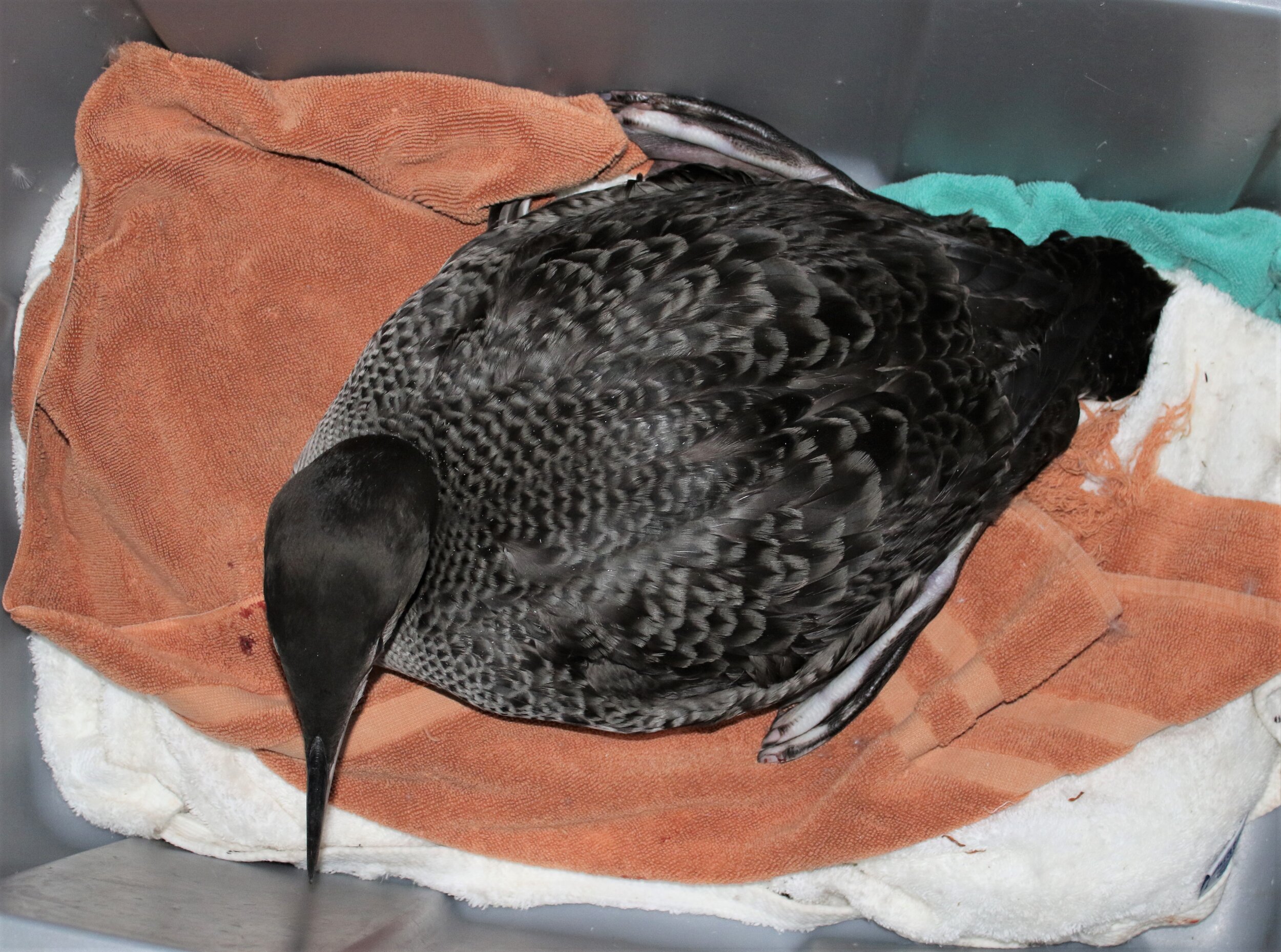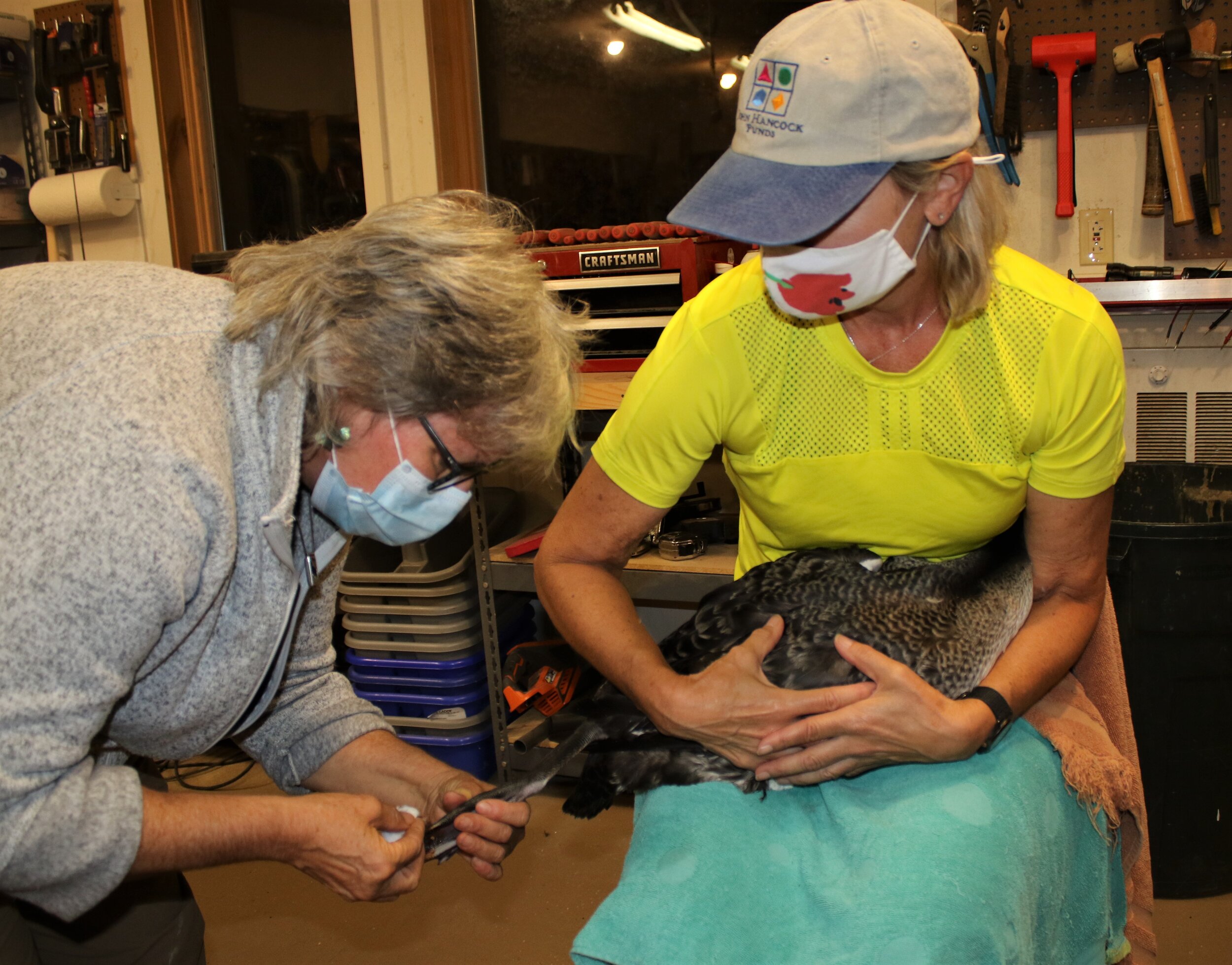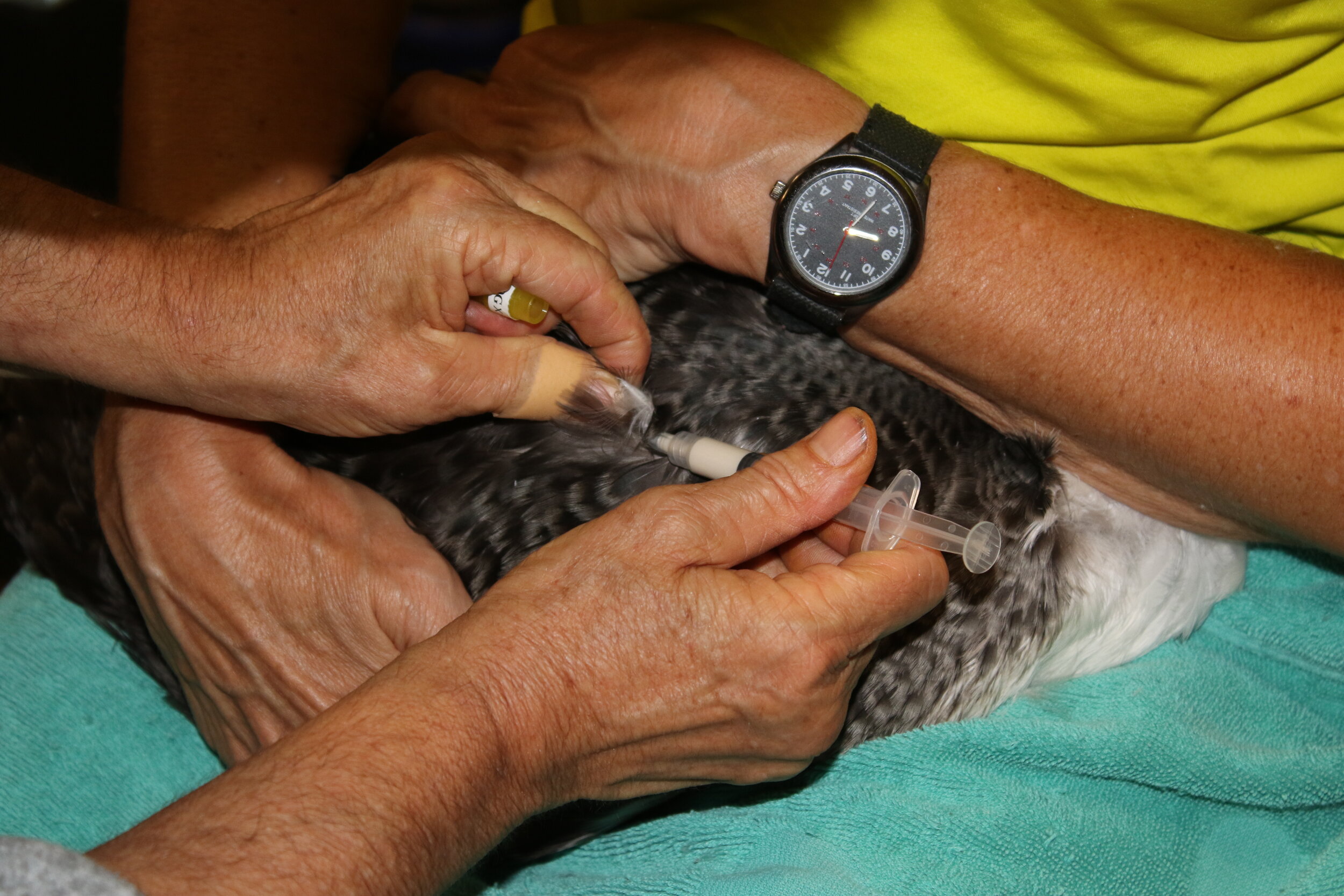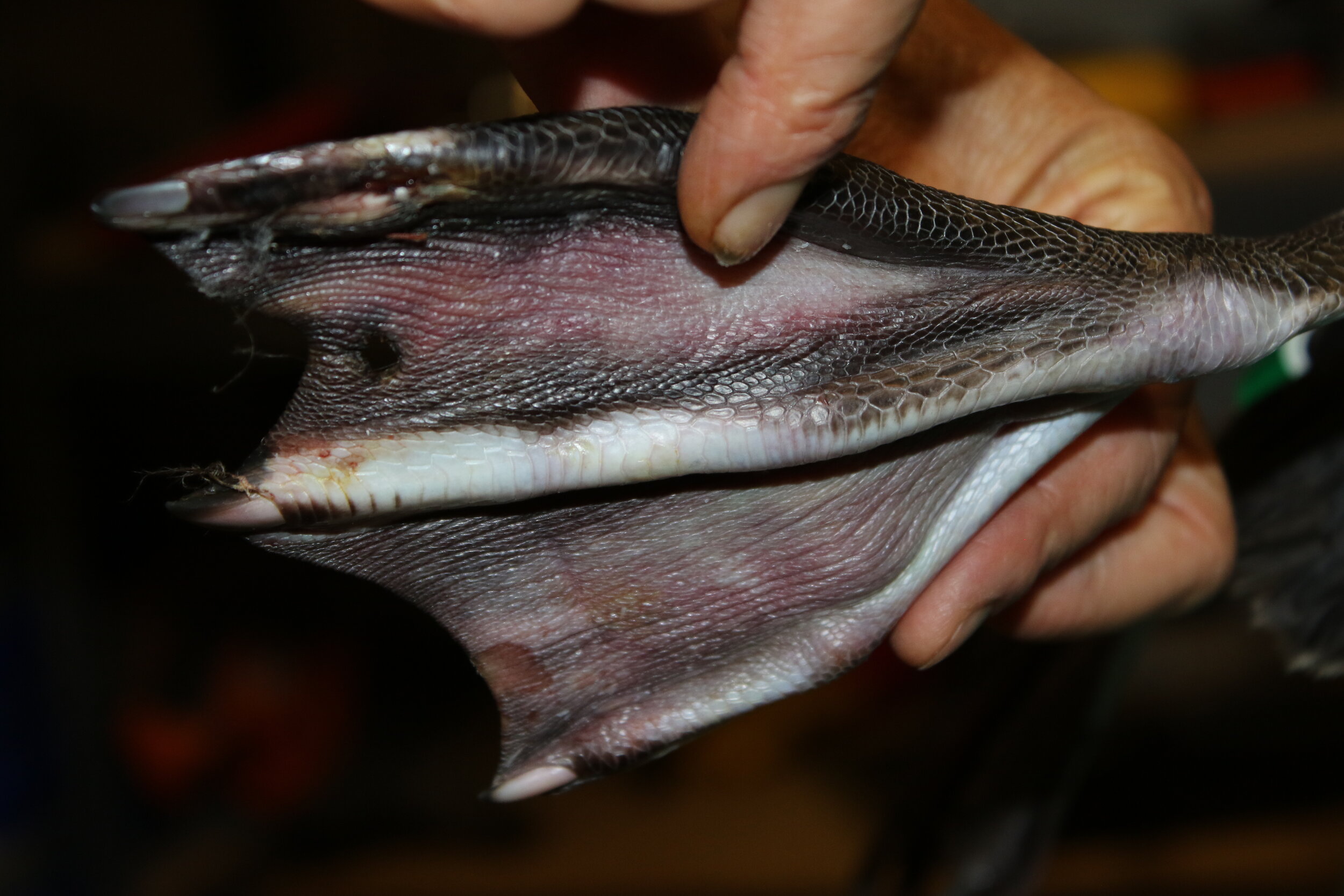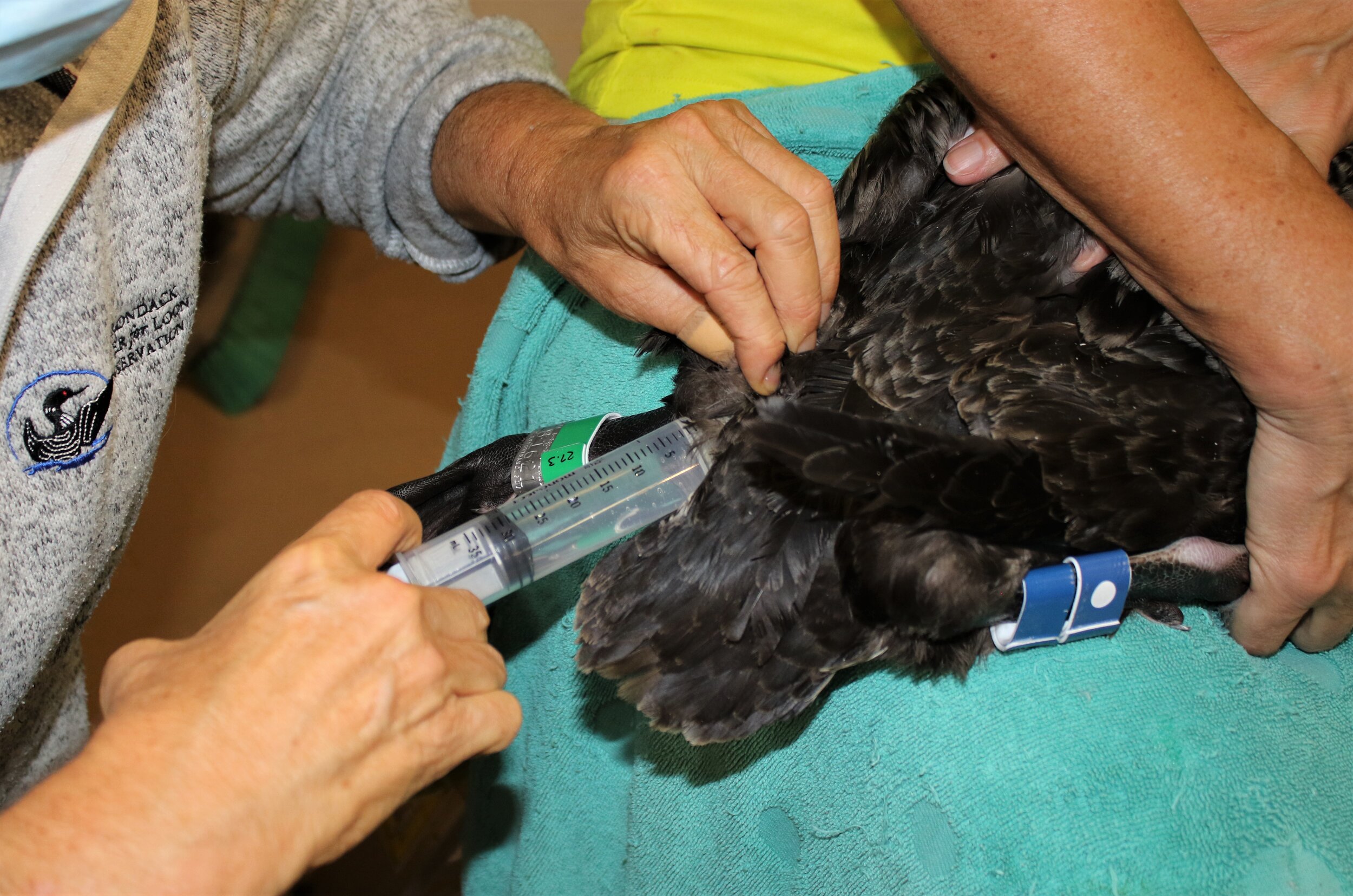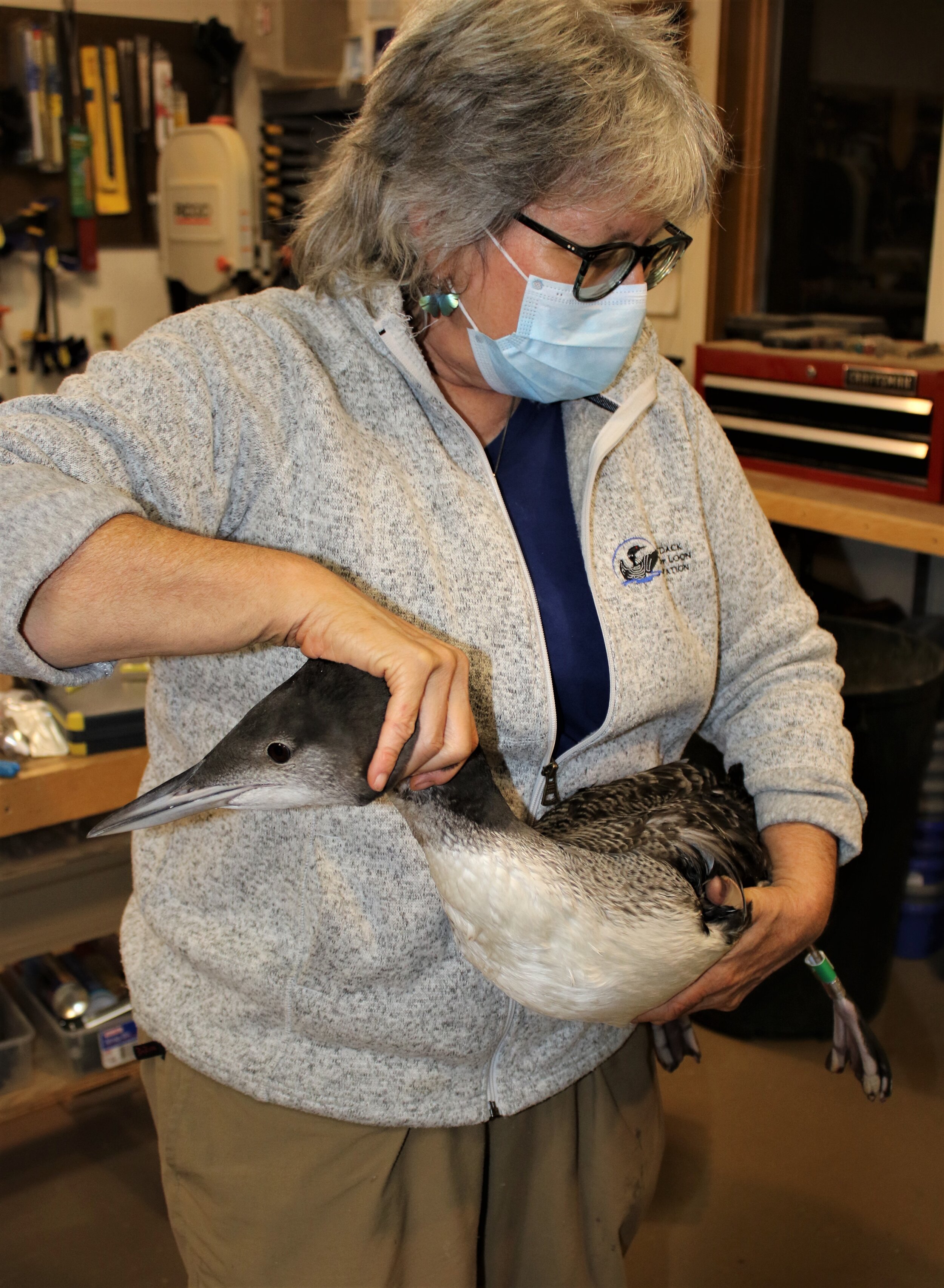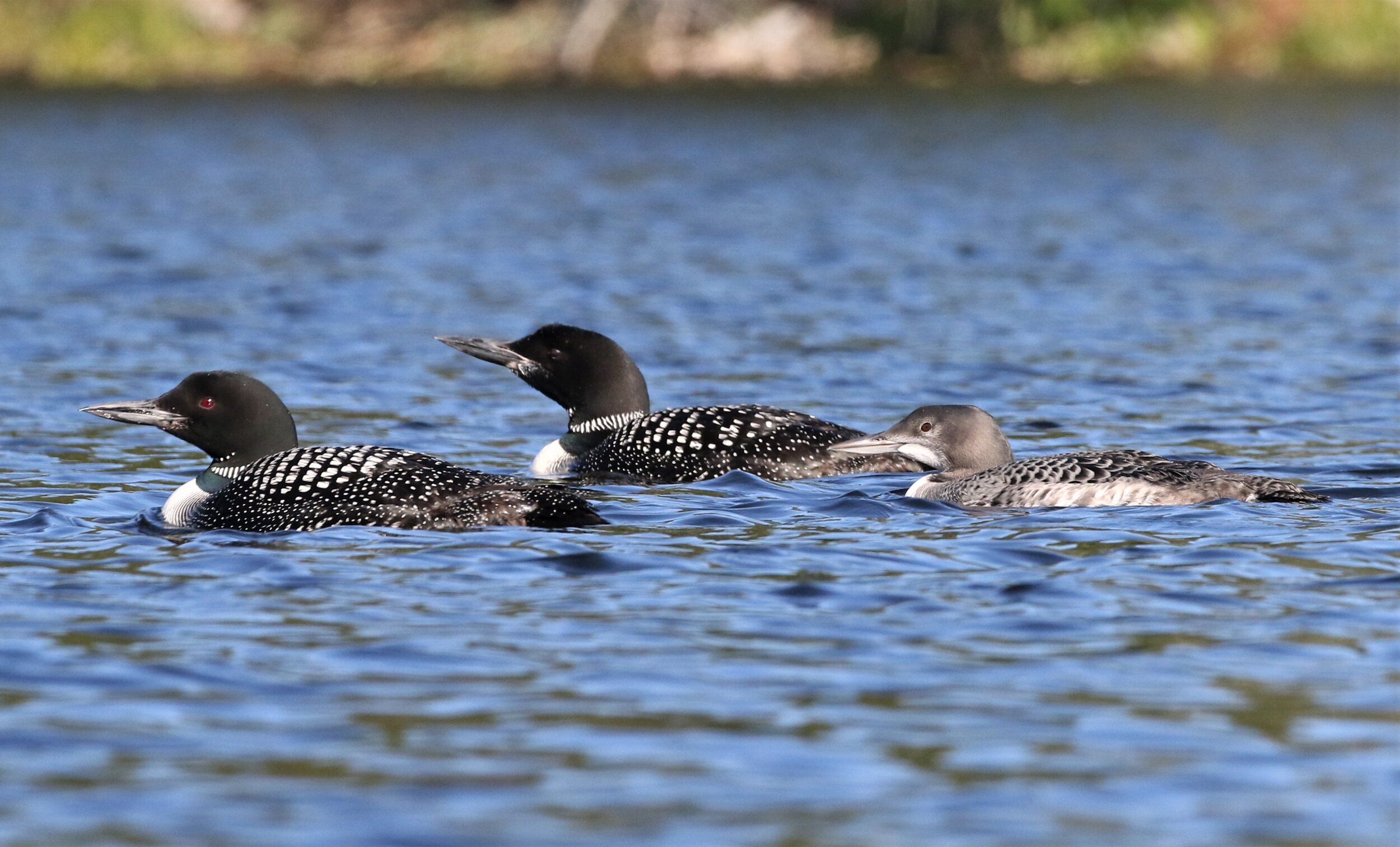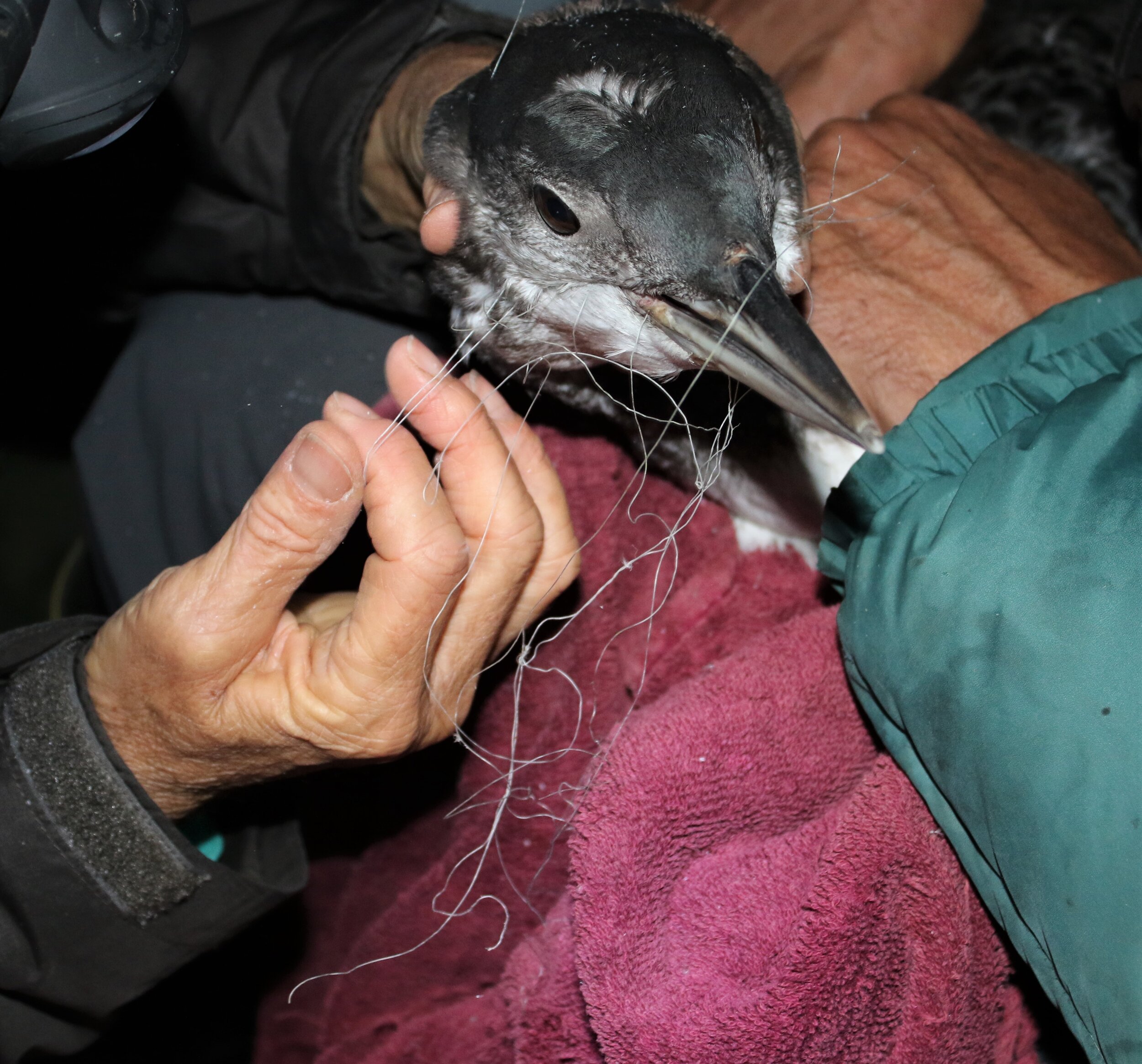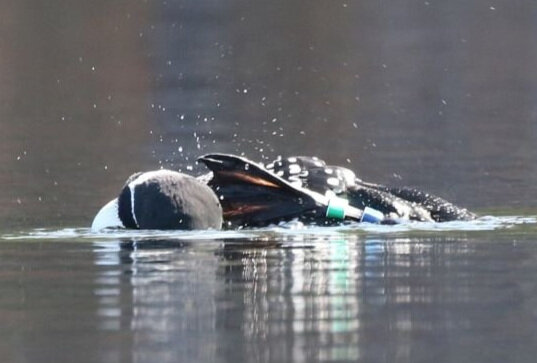Adirondack Loon Blog
Enjoy our reports of rescues, visits with loons, and other adventures in the Adirondacks!
4/8/24: Total Eclipse with a Loon
At 2:00 PM on April 8, 2024, I packed my twelve-foot canoe with gear and cameras and paddled out onto Paradox Lake to witness the total eclipse of the sun. I hoped to observe how the wildlife and especially the loons, which had just returned to the iced-out lake, would react to the sudden, premature darkening of the sky. I had a camera with a 400 mm lens equipped with a home-made solar filter to photograph the sun itself, a camera with an 18-55mm lens for scenery, my cell phone camera, and of course, eclipse glasses. I was very excited.
I took a photo of the full sun for practice, and I could see two darker spots, probably sunspots, on the surface of the sun. The high, thin clouds made the image just a little fuzzy at times but were not a major problem. I waited a few minutes and looked through the big lens again and was thrilled to see a tiny flat spot at the lower right edge of the sun. The eclipse was starting!
My neighbors were sitting on their deck overlooking the lake and we waved to each other. People were scattered around the shore at private camps, beaches, and the state campground to enjoy this rare experience. One other kayak was out near the campground, but my canoe was the only other craft on the upper lake. The winds were light, the water fairly calm, and the warm, sunny afternoon was quiet except for the call of a merlin. Now I had to find a loon.
I searched with binoculars and located Scruffy, a new male loon who was trying to establish a territory in the inlet cove. I had watched him interact with the eastern loon pair the previous day when these loons had just arrived from migration. Scruffy earned his name because he had not yet molted into full breeding plumage and had a slightly patchy appearance.
Every few minutes I looked at the sun through the camera lens and photographed. The moon seemed to be moving in front of the sun faster than I expected. I paddled down to the inlet cove to watch Scruffy, who was busy fishing. He was not nervous with my presence, and I watched him catch two small food items and then a fish that may have been a five-inch sunfish. Meanwhile, I photographed the sun and listened for birds and wildlife. It was rather quiet, and soon the moon was about halfway across the sun.
Then leopard frogs started calling from the inlet marsh. Scruffy stopped fishing and began to swim west toward the middle of the lake. I thought I could tell that daylight was diminishing ever so slightly. I followed Scruffy and when he reached the middle, he began to preen his feathers. Now I could tell that the sky was a bit darker, and apparently Scruffy could, too. He tucked his head under the feathers on his back and started to snooze. I drifted close to him, photographing with the regular lens. The south shoreline where my home is located, and the trees on Crawford Island, began to look darker.
Scruffy picked up his head, and slowly swam northwest toward Crawford Island. The sky looked strange, the blue becoming a darker dusky blue everywhere. I followed Scruffy from a distance, not wanting to influence where he went. Fish started rising and jumping. The air chilled, and I put on a hat and jacket. The wind died completely, and the lake went flat calm. The sky began to look blackish, yet there was still light around the horizon.
Scruffy let out a wail. I suddenly felt a wave of uneasiness, feeling small and vulnerable in a little canoe in the middle of a big lake that was maybe 34 degrees and about to be dark as night. I took a photo of the very thin sliver of the sun that was not yet blocked by the moon and started to paddle fast toward Crawford Island for the security of a shoreline. As I neared the northwest shore of Crawford, a chorus of cheers erupted from a group of folks watching the eclipse from Glen Reay’s Beach. I set the paddle down fast, and looked at the sun, now a small white ring of totality in a black night sky.
I tried to photograph the sun with my telephoto lens, but the solar filter blocked out what little light could edge around the moon. I picked up my regular camera and tried to capture the incredible scene: black sky with a white ring for a sun up high, then deep blue shading to medium blue with some thin clouds, with white and gold light near the horizon. It was not quite as dark as full night due to the lighter horizon sky that reflected off the water. The landscape was surreal, unlike any sunset or sunrise I had ever witnessed.
I gawked with my eyes alone and took as many photos of the sun and the landscape with my regular camera as I could. Suddenly a speck of intense light, the “diamond ring” appeared at the edge of the sun. In seconds the speck grew, light shone back down onto the earth like a spotlight, and the sun became too bright to look at without eclipse glasses. Dawn came faster than a peregrine falcon.
The birds responded immediately, just as if the sun had risen at 6:20 AM. Robins sang, and pine siskins, goldfinches, and purple finches started up their chatter. The eastern loon pair swam into view, heading east, patrolling their territory. They hooted, most likely looking for Scruffy to drive him away. Scruffy dove and swam underwater a long way and kept his distance.
I took off my hat and jacket as the air temperature warmed. The wind picked up, and a slight chop developed on the water. Paddling along the island’s shore, I continued to photograph the moon moving upward across the surface of the sun. I noticed the silhouettes of white pine and cedar branches against the orange glow of the sun and photographed them. By now the loon pair had turned back west, and I noticed Scruffy way down in the inlet cove where I had first found him when the eclipse began.
Continuing to photograph every few minutes until the moon was once again just a tiny flat spot at the top of the sun, I paddled toward our shore. What an unforgettable experience! It was surreal, moving, and profound, and I felt connected to the earth, the moon, and the sun as never before. I have always felt bonded to the animals and plants of the earth, but now I feel like a child of the universe.
~E. George, ACLC Field Staff & Loon Naturalist Extraordinaire
10/17/23: “Loon Pond,” NY - Visitors at Loon Pond
On October 17, two loons were present on Loon Pond, but only one of them was an adult. The second loon was a juvenile. But wait! The territorial loon pair nested this summer, but their nest was predated late in incubation, and they did not have any chicks this year. Where did this youngster come from? Neither of the closest ponds had nesting loons this year. This first year bird must have come from a pond or lake a few miles or more distant. It was fairly tolerant of me in my canoe, which suggests that perhaps it was raised on a lake with a strong human presence and lots of boats and was accustomed to them.
The juvenile was interested in the adult and swam toward it, but the adult dove and kept its distance, seeming to try to avoid interacting with the juvenile. The adult was probably the territorial male because it was molting heavily into winter plumage and the male usually stays on this pond longer than the female before migrating. However, I was not able to see the bands on its legs, so I do not know for sure. It is interesting that the territorial adult did not try to drive off this juvenile, who was not its own chick. The adult spent most of its time fishing and dove frequently, while the juvenile swam on the surface and watched the adult, following it from a distance.
The next time I visited Loon Pond was November 3rd, and I did not expect any loons to be left on the pond. I was right. But in November, Loon Pond becomes Merganser Pond, as numbers of migrating common and hooded mergansers stop by and feed. One male common merganser was by itself, and it took flight, circling the pond and heading west. At least 25 hooded mergansers were feeding, and they were in two groups. One group had two males and three females, and the other group had about 20 females and juveniles.
When I tried to get closer for photographs, they took flight and flew to the opposite end of the pond. Hooded mergansers can lift off with just a few running steps, unlike loons and even the common mergansers which are larger and heavier than hooded mergansers.
The other interesting observation was the absence of beavers. None of the beaver lodges showed signs of fresh mud and sticks, there were no winter food caches, and no freshly chewed sticks along the shore. In the thirteen years I have been monitoring Loon Pond, there have always been beavers living on it. I knew that there were at least two this summer in one small lodge, but they were not very active. I think they may have moved to a new pond or lake because of lack of food, since the beavers have cut down many of the shoreline deciduous trees, and also eaten a lot of the water lily roots that they need for winter forage.
If I don’t visit again soon, Loon Pond will be locked in with ice, and paddling will have to wait until next year. I hope that the banded loon pair had a safe migration to their wintering areas, and that they return again next year for a successful breeding season.
~E. George, ACLC Field Staff & Loon Naturalist Extraordinaire!
9/25/23: “Loon Pond,” NY - What’s up at loon pond?
Here is a summary of my three trips to Loon Pond. Since the nest was predated right before hatching, the loon pair is on vacation with no chicks to raise. They could visit other ponds and lakes or migrate to the ocean whenever they want, since they have no parental duties. However, staying on their territorial pond, as long as they have enough food, is not a bad plan. It is a safe place, and the loon pair can drive off any rivals who may drop in with designs of taking over this productive territory.
On August 1st, three loons were present: the loon pair and one intruder. The intruder was probably a female, since it spent more time interacting with the old territorial female than it did with the male. In the image below, you can see these three loons, and also notice that they are still in full breeding plumage of black and white.
A month later on September 8th, again an intruder was on the pond. This loon was very nervous and made frequent tremolo calls and spent most of its time avoiding the territorial pair. After a while it took flight. The female in the territorial pair, shown doing a wing flap the image on the left, has not started to molt yet.
On September 21st, only the territorial pair was present. The male made frequent low cooing calls to the female, almost like in spring before mating. The male is molting much more heavily now, and he looks ragged because he is losing his black feathers with their white spots. He will grow in a gray and white winter plumage, but he will retain his flight feathers for a few more months until January or February when he should be safely in a wintering area like the Atlantic Ocean. There he will be able to swim and dive but not need to fly for a couple of months until it is time to return to his breeding territory in the spring. The female is just starting to molt. Loons preen a lot when they are molting, and the surface of their lakes and ponds are speckled with floating loon feathers. Feathers wear out with use over time, and the tips become sparse, lacking the barbules that allow the loon to zip them back into shape and keep themselves waterproof. Also, the gray and white plumage is more camouflaged on the ocean where the loons have more predators and are no longer breeding.
Will the loon pair still be on Loon Pond the next time I visit? Will they stay as long as they did last year, when they also did not have a chick? In 2022, the female was gone by October 12, while the male stayed past October 23, but was gone by November 4. Time will tell.
~E. George, ACLC Field Staff & Loon Naturalist Extraordinaire!
7/18/23- “LooN Pond,” NY - Did the Eggs Hatch, and What Happened during the Loon Census?
The loon nest on the rock was due to hatch between July 2 and 7. I was excited to visit on July 7, hoping to see two little fuzzy dark chicks. Instead, I saw the two adults swimming together in the pond with no chicks on their backs. That was not a good sign.
I paddled toward the nest rock and could see that it was empty. Only one small piece of broken eggshell remained, and there were no eggs or eggshells in the water around the nest. Something had gotten the eggs and carried them off. Sadly, I went to retrieve the nest camera hoping that it would at least solve the mystery.
On July 15 I returned for the annual loon census. I had just a smidgeon of hope that the loons might try to renest because the female on Loon Pond has been an excellent re-nester after losing her first set of eggs. However, this year the loons had incubated almost to full term, and when that happens, they rarely renest.
Glassing the pond with binoculars, I spotted two loons in the middle. But wait, there were more! Four loons were doing a circle dance, swimming in a tight circle and looking at each other, checking one another out. I paddled out and joined the party. The banded territorial pair was there, but who were the other two? They acted like a pair, staying together when all four were not close, and both were unbanded. The loons swam together for 45 minutes, occasionally getting nervous, sinking low in the water and then splash diving and reappearing further away. But mostly they just swam around the pond together, looking at each other. The territorial male even preened and did a foot waggle, displaying his colored bands. That behavior indicates that he was relaxed and did not feel threatened by the intruding pair.
When I got home and checked the images on the camera, I was disappointed to see that the motion sensor had not been triggered by whatever got the eggs. Because I had to set the camera at some distance on a nearby island, it was only triggered by large moving objects like canoes, kayaks, and a beaver swimming past. It did tell me that the predation occurred on July 1, because the loons were photographed swimming right past the island, which they had not done during incubation, and they were not seen on the nest after that. A smaller mammal, like a mink, otter, or raccoon, must have snuck in from the far side and stolen the eggs.
At 8:30 the visiting pair took flight, circled the pond and headed in the direction of Nearby Pond. I thought they might have come from that pond and I knew that someone else was counting loons on Nearby Pond for the loon census. I would be able to contact them and determine if they saw two loons fly in and land soon after 8:30. I paddled all around the pond looking for signs of a new nest but did not find one.
A day later I contacted the Nearby Pond observer and was told that two loons had been present on the pond for the whole hour, and that no new loons had flown over or landed during that time. If the intruders were not from Nearby Pond, where did they come from? There are a few other ponds several miles away that may have loons, but no other ones in close proximity.
While it is extremely unlikely that the Loon Pond loons will re-nest, I will still hold a shard of hope for next week’s visit. If not, then they will have a summer vacation, fishing, resting, holding their territory from prospecting loons looking for a breeding pond, and getting ready for the autumn migration.
~E. George, ACLC Field Staff & Loon Naturalist Extraordinaire!
7/3/23- “Loon Pond”, NY - Visitors to the nest rock
You might think that incubation is very boring. The loon just sits on the eggs for hours on end. But the loon is usually alert, constantly monitoring the surroundings for threats, whether it be an eagle, a human, a raven, or another loon. I only visit the pond once a week for one to two hours, and yet I often witness a possible threat to the incubating loon or its eggs.
So it was these past two weeks, when I visited on 6/21 and again on 6/27. On 6/21, I found a truck already parked at the pond. As I paddled down the pond toward the nest, I encountered the female in the center of the pond. Suddenly the male pushed off the nest and wing-rowed toward the middle. He had obviously been spooked by something. Since he was off the nest, I paddled down to check to see if the eggs were still present and what had scared him. A small boat was in the far, shallow end near the nest, and when the guy in the boat saw me, he turned and rowed further away. He didn’t appear to have a fishing rod. The eggs looked okay, so I paddled back toward the middle of the pond where the loon pair was.
Then I heard a .22 gunshot, and then another, and I realized that the guy in the boat was probably hunting frogs. With binoculars I watched him reach a long-handled net and likely scoop up one of his victims. Yes, it is legal in New York State to hunt frogs so I couldn’t ask him to stop and leave the west shallow end, since that is where most of the bullfrogs and green frogs live. I just hoped that he would finish hunting and leave of his own accord, allowing the loons to get back on the nest. At least he had moved further from the nest, but the occasional gunshots with their startling noise might keep the loons off the nest.
On June 27 I visited Loon Pond again. I was happy to see several surviving bullfrogs basking on logs. I could see a loon on the nest from the opposite end of the pond, sitting upright in relaxed posture. But soon after I put my canoe in, the loon hunkered down in hangover position, indicating stress. Both loons are nervous incubators. I encountered the female fishing and preening in the middle of the pond, so the male was the one on the nest. Then I noticed a great blue heron hunting the shoreline, heading toward the loon nest. Would the heron bother the loon nest? What would the loon do when the heron got close?
I watched from a far distance, using binoculars and the telephoto lens of my camera. The heron slowly walked along the shore, once stabbing at prey in the water. It did not approach the nest rock but walked behind it, staying along the mainland shore. The loon stayed in hangover position and did not seem alarmed by the heron’s presence. The heron continued past the nest and was soon out of sight.
If all goes well, the eggs should hatch soon. Hopefully they have not been chilled or overheated from the loons being scared off the nest for too long. Who knows what other threats have occurred during all the time when I am not there to observe? The eggs will have to survive the July Fourth weekend, a time of increased human visitation and disturbance. Stay tuned to see if they do.
~E. George, ACLC Field Staff & Loon Naturalist Extraordinaire!
6/14/23- “Loon Pond”, NY - Nesting on a Rock
The banded pair of loons both returned to Loon Pond in April after the ice melted. The male arrived first, by 4/16, and the female had joined him by 4/20. She is at least 26 years old now and has been on Loon Pond every year since she was banded in 2002, and who knows how many years before that. Loons are usually five years old before they breed for the first time.
The black flies were pretty bad in many parts of the Adirondacks this spring, including Loon Pond. The loons spent much of their time diving, not just to catch fish but also to escape the biting flies. They waited to nest, possibly for the black flies to diminish. On June 8, an intruder loon was on the pond. The loon pair was searching for it, swimming around and craning their necks, and frequently peering underwater. One of the loons, probably the male, located the intruder and interacted with it, swimming close, while the two loons looked at each other and checked each other out. In the meantime, the other loon, the female, had disappeared. I spotted a black dot at the far southwest end of the pond. Could the loon be on a nest?
My binoculars revealed a loon on a nest on a large, partially vegetated rock, about the size of a bathtub. This was a new loon nest location for the Loon Pond loons, and a new one for me. I’ve seen loons nest on islands, bog mats, marshes, the mainland wooded shore, beaver lodges, and sandbars, but never a rock before now. I guess a rock is just a tiny island, after all. Meanwhile, the intruder loon ran across the water and took flight, leaving the pond and flying toward Nearby Pond.
I eased my canoe closer, knowing that I had to set up a nest camera and that I would probably flush the loon off the nest in order to do so. I approached very slowly and quietly because I didn’t want the loon to push off in a hurry and possibly kick an egg off the nest. The Loon Pond loons are average in their tolerance for humans, and do not usually allow close approach. The female eased gently into the water when I got too close for her comfort, and I could see two eggs on the nest, the usual number. I quickly set up the nest camera on a nearby island facing the nest, and paddled away fast so the loons could return to incubating. When I was far from the nest, I turned and spotted a loon climbing back on.
I returned on June 14 to monitor the pond. The female loon was fishing in the middle, diving frequently. I caught a glimpse of her orange band. The male was on the nest, but by the time I could see him, he was already in hangover position with his head and neck low, indicating stress, even though I was a third of the pond away. I took a quick distant photo with my telephoto lens, and paddled away, not wanting him to leave the nest. On my way back to shore, I noticed a snapping turtle on a beaver lodge, digging with powerful front legs trying to excavate a nest hole in the mud on the lodge.
Will the Loon Pond loons successfully incubate their two eggs and hatch two fluffy black chicks? Or will a predator find the nest and have loon eggs for lunch? If that happens, hopefully the nest camera will tell us who the predator was. Stay tuned for another update on Loon Pond. Loon eggs take 27-29 days to hatch, so there are only three weeks to go before the eggs might hatch!
~E. George, ACLC Field Staff & Loon Naturalist Extraordinaire!
5/2/23- “LOON POND”, NY - RETURN OF THE BANDED LOONS?
The first time I visit Loon Pond each spring, I am excited but apprehensive at the same time. I can’t wait to see the loons, but what if they haven’t returned? What if, instead of the two banded loons I have watched for years, there are two new, unbanded loons on the territory? Or no loons at all?
The ice was partly out by April 14, and all clear by the time I visited on April 16. I scanned with binoculars from shore and spotted one loon. Good! I paddled out and determined that it was the banded male loon, by seeing his white band on each leg. But there was no sign of the old female, who was first banded on Loon Pond in 2002 and had been breeding on it every year since then. That means that she would be at least 26 years old if she returned this year, since loons usually must be 5 years old before they breed for the first time, and she could be much older. Last year both loons were back on the pond by April 12, but the pond iced out a lot earlier in 2022.
Something about her behavior made me think it was the old female, but I couldn’t see her bands for quite a while. Both loons were fishing, and spending most of their time underwater, and in order to see leg bands you need the loon to be floating high in the water or have it lift a leg to preen or scratch or do a foot waggle. Finally, the loons paused from their diving, and I caught a flash of green from the left side of one loon. The old female has a blue band and a green band on her left leg, so I was pretty sure it was her, but I wanted a better look. I followed her longer and saw a flash of orange on the right leg. It had to be her, because she has an orange band with a black stripe plus a silver metal band on her right leg. Yay!
I watched the loons for some time and observed the female catch and eat a bullhead, a species of catfish with three sharp spines in its fins. Painted turtles were basking on logs in the shallow end of the pond, and a female common merganser shared a log as a resting place with several turtles.
From my limited observations of banded loons in my study area, it seems that more loons die over the winter or during migration, and don’t make it back to their breeding lakes, rather than dying during the time when they are back on their freshwater lakes. Adirondack loons spend 5 to 7 months in the Adirondacks, and the remainder on the ocean or on other bodies of water in between as stopovers during migration.
I visited again on April 20, figuring that if the female wasn’t back by then, she probably didn’t make it. I held my breath as I scanned the pond but couldn’t see any loons. I pushed off and paddled out where I had a better view of the pond and was thrilled to see two loons together. But was the other loon the old, banded female, or a new unbanded bird that took her place?
Returning on April 26, I found the banded loon pair fishing together in the deeper water. I caught a glimpse of the male’s two white bands, and the female even paused to preen and lifted her left leg, clearly showing me her blue and green bands. All was well. A mature great blue heron fished from a beaver lodge in the shallow end, and spring peepers sang. When and where will the loons nest this year? Will they hatch chicks? Will other loons visit and maybe fight to try to take over the territory? Stay tuned for more adventures of the loons at Loon Pond. I can’t wait to go back again.
~E. George, ACLC Field Staff & Loon Naturalist Extraordinaire!
12/15/22 - RESCUE ON FIRST LAKE, HERKIMER COUNTY, NY
On Wednesday, December 14 the Adirondack Center for Loon Conservation received a report of an iced-in Common Loon on First Lake in the Town of Webb. Overnight the water froze further and the ice surrounding the loon thickened. While these changes might seem bad for the loon, the cold night made conditions safe for a rescue effort.
On Thursday, December 15, volunteers and staff from the Adirondack Center for Loon Conservation went to rescue the loon early in the morning. The group included Cody Sears, Jay Locke, Gary Lee, Don Andrews, and Kurt Gardner.
The loon was stuck in a small patch of open water about half a football field from shore. After carefully trekking across the ice, the rescuers attempted to extract the loon using a canoe and large net. The loon stayed free by diving quickly underwater, so the team switched up their tactics. Using a gill net to cover part of the hole in the ice and the canoe in unison, the loon was finally captured!
It was a healthy juvenile that was subsequently released to a larger ice-free lake to get another chance at successful migration. The Adirondack Center for Loon Conservation is very grateful for the hard work of the rescue team. Good work guys!
If you see an iced-in loon, please report it by calling (518)354-8636 or emailing info@adkloon.org.
~Jennifer Denny, ACLC Communications Coordinator
11/23/22 - “Loon Pond”, NY - Hard Water
Surprisingly, the male loon was still on Loon Pond on October 23. He stayed later this year without a chick than he did last year when he had a chick to feed and protect. However, on November 4 there were no loons on the pond. Both common and hooded mergansers were present, migrating through the area and stopping to feed on the fish, crayfish, and other aquatic invertebrates. Every autumn, Loon Pond turns into Merganser Pond after the loons leave and the mergansers stop by. Up to 50 mergansers might be present, with each species flocking up separately. Hooded mergansers do breed on Loon Pond, and each summer there is at least one family of hoodeds growing up. But the larger common mergansers tend to be just spring and fall visitors.
On November 4 one great blue heron was fishing the shallow west end. Just before dark the beavers emerged from their lodge to feed. November 19 was much colder with snow on the ground, and the beavers were active all afternoon. One of the adults was feeding on water lily roots, while another adult carried a big mouthful of grasses in its mouth to use for bedding in the lodge. A third adult beaver was eating twigs it had cut, while a beaver kit fed on small twigs from the winter food supply that the adults were caching in front of the lodge. A flock of hooded mergansers fed together in the shallows, and one of them caught something big that might have been a frog. About 25 hoodies, mostly females and immatures, were fishing throughout the pond, while four common mergansers worked the east end.
After two very cold days on November 20 and 21 when the temperature might not have gone above freezing, the forecast was for milder weather by midweek. I had hoped to paddle the pond one more time on November 23, but on the afternoon of November 21, I received a text with a photo that said, “Change of state.” A friend who lives near Loon Pond sent a picture of the pond, completely covered with ice. Unless the wind and warmer weather break up the skim of ice, life will go on under the surface, but the ducks, loons, and canoeists will have to wait until next year.
~E. George, ACLC Field Staff & Loon Naturalist Extraordinaire!
10/17/22 - “Loon Pond”, NY - Anybody Left on Loon Pond?
On October 5th, I paddled Loon Pond to see if the territorial pair of loons were still there. They were! Both were molting into winter plumage, and the male was much whiter and grayer than the female. Even the beaks and legs of loons turn gray in autumn, and you can see the loss of black pigment at the base of the bills of both loons. The loons were still making low cooing sounds to each other.
October 12 brought silence to the pond. The female loon was gone, and only the male remained. He looked more gray and white than a week ago, and spent his time fishing, diving and swimming underwater across the pond repeatedly.
The male was still there on October 16, along with a kingfisher, drake wood duck, and female hooded merganser. When the loon pair was together on the pond, they were reasonably approachable, and used to my presence. But the last two visits with the female gone, the male kept his distance and did not allow me to approach as close as usual before diving. I did manage to see the white band on his right leg, so I know it is the territorial male, and not another loon just visiting the pond.
Last year the loons had a chick, and the male stayed on the pond with the chick until some time between October 17 and October 21. I was surprised that the male was still there on the 16th this year, since he does not have a chick to defend and feed. I thought that loons would leave their territorial ponds to begin migration or staging sooner if they did not have a chick, but this guy, with no chick this year, is right on schedule like last year. Will he be on Loon Pond the next time I visit? I am guessing that he will be gone.
The female actually stayed longer this year with no chick than she did last year when she had a chick to care for. Last year she was gone by September 26, while this year she left between October 5th and 12th. This is not a huge difference, but an interesting observation. Maybe loons leave earlier when they have chicks constantly pestering them to be fed. We would need a lot more data to determine the relationship between when adults leave their ponds and lakes in autumn and the presence or absence of chicks, but since we end our loon monitoring season in mid-August, the ACLC does not get information on this.
Loon Pond is a wild and fascinating place to visit all year, even when the loons leave. I watched a beaver feeding on roots of shoreline grasses. A barred owl hooted before dark. And just as I was tying my canoe on the car to leave, a glorious coyote chorus erupted from close by, with at least four voices, including the high howls and yips of pups.
~E. George, ACLC Field Staff & Loon Naturalist Extraordinaire!
9/15/22 - “Loon Pond”, NY - Finally, the Incubation Ends
On September 6th I visited Loon Pond to see if the loons were still incubating their overdue egg from their second nesting attempt. I scanned with binoculars to the far west end, but no loon was on the nest. Then I spotted three adult loons swimming together, so I paddled down to the nest. The egg was still there, but was it still being incubated? On September 1st, no loon had been on the nest when I arrived, but the nest and egg were much warmer than the air temperature.
I felt the nest: cold. Then I picked up the egg: also, cold. It was obvious that the loons had finally given up their marathon incubation attempt, which was good since the egg should have hatched many days ago if it was viable. The loon pair could now relax, fish, and fatten up before migration. It was also time to start molting breeding plumage and grow in gray and white winter plumage, which requires a lot of energy. I picked up the egg and sniffed it—STINKY, another sign that the egg was certainly dead. But the egg was still intact, with no cracks or chips. Think how many times the loons climbed off the egg and climbed back on, turned it with their beaks, and sat down on it to incubate. For at least 53 days they exchanged places on the nest several times a day, and never cracked the egg. Also, no predators found the egg during that long time period. I collected the egg, careful not to crack it and create a stink bomb in my canoe and took it home to freeze it and bring it to the ACLC so they can have it tested for mercury contamination.
While I was at the nest, I heard the loons hoot and saw them look up. Another loon came flying in and landed on the pond. I started to paddle toward the four loons when they hooted again, and in came a fifth loon. In late August and September, loons become more social and get together in what I call “loon parties”. They swim together, circle, dive, but do not usually penguin dance or do wing-row chases because their hormones, aggression, and territoriality are diminishing. In winter loons are quite social and swim and fish together, often in large flocks on the ocean.
The five loons got along fairly well and cruised the pond together. The banded male loon held up a leg to shake off the water before tucking it under a wing, and I was able to see the bands. Suddenly one loon got nervous and wing-rowed away from the rest, making tremolos as it sped away. Later it reunited with the group, and all five loons were still on the pond when I left.
Soon the loon pair will leave the pond, maybe just for a few hours or more, and then to start their migration. Since they have no chick this year, there is nothing to keep them on the pond any longer, should they wish to leave.
Will the loon pair still be on Loon Pond the next time I visit? And what will the nest camera show, after 53 days of spying on the nest? Stay tuned for at least one more trip to Loon Pond for 2022.
~E. George, ACLC Field Staff & Loon Naturalist Extraordinaire!
9/9/22 - Rescue at Palmer Pond Dam - Essex County, NY
Last week, two juvenile Common Loons were found below the dam at Palmer Pond in Essex County, NY. When we arrived, they were swimming calmly downstream from the whitewater coming off the high dam. Ironically, they were just above a section of the stream where we had rescued an adult loon earlier this summer. Due to the fast water, tall dam, and steep banks, the young loons were trapped and unable to get themselves back to the lake above. Since loons are very heavy and have a unique anatomy, they need long stretches of open water to get airborne. The two young siblings at Palmer Pond were new to the art of flying, and had no hope of taking off from the stream.
Our rescue team, including three staff members from the Adirondack Center for Loon Conservation and five of our volunteers, gathered along the two sides of Palmer Pond’s outlet. We used a variety of nets and techniques to capture the loons. One was quickly caught after we began our effort. However, the other bird evaded rescuers with swift dives and impressive agility, until we employed a system involving two gill nets. This worked very well, and we finally captured the loon after a couple of tries.
We took the juveniles to a different lake nearby for release, since they were old enough to feed themselves and no longer required care from their parents. If we had returned them to Palmer Pond, we feared they may go back over the dam again!
We banded, weighed, and measured the loons before releasing them at their new home. Once again free, they looked delighted to be able to swim easily on the calm, flat water. The siblings swam away from shore together to inspect their new lake. Hopefully they will soon begin fattening up to prepare for migration.
The Adirondack Center for Loon Conservation thanks Ellie George, Gary Lee, Sue and Lance Durfey, Trish Pielnik, Larry McGory, and Kevin Boyle for their excellent help with this unique multi-loon rescue.
- Jen Denny, Communications-Education Coordinator
9/7/22 - “Loon Pond”, NY - September Incubation
An evening visit to Loon Pond on August 28 found the female still on the nest, while the male was floating on the pond. After a while, the female slid off the nest for a break, and swam out to meet her mate. The loons made low cooing calls to each other, and both preened a little, showing their leg bands. The low angled evening sun made their feathers glow.
Suddenly both loons started to tremolo, the “laughing” call of the loon which actually expresses stress or alarm. I scanned the skies looking for an eagle or an airplane but saw nothing. No bear or coyote appeared on shore, either. After a few minutes they stopped calling, and they swam slowly back towards the nest. By the time I was hauling my gear up the shore, I could just see a loon back on the nest.
On September first I visited Loon Pond in the morning. Both loons were swimming together in the southwest end, so I figured they had finally stopped incubating their overdue egg. I paddled to the nest and noticed the egg still there. I unlocked the nest camera and took it down, since the loons were at the far east end by now and wouldn’t be disturbed by me near their nest. Then I approached the nest, planning on collecting the egg if it was cold and abandoned, because the ACLC tests abandoned eggs for mercury levels. I reached out, putting my hand on the nest to brace myself so I wouldn’t tip the canoe over. The nest felt warm, even though it had been in the mid-40’s that night and was still only 50 degrees F. I picked up the egg, and it felt like holding a warm coffee mug in my hand. The loons were obviously still incubating and must have left the nest just before I arrived. I set the egg down gently and paddled away.
Some sharp hoot calls attracted my attention as I paddled toward the loon pair, and I spotted a third loon flying toward them, dropping swiftly toward the pond, feet out to slow the descent. The new loon zoomed right past me and dragged its feet on the water as brakes, then its tail, then its whole belly slid along the water until it stopped, in classic loon fashion. This unbanded loon visitor swam toward the Loon Pond pair, and all three interacted, swimming in a circle, diving together, and checking each other out. I watched for a while and then left, and the loons still had not gotten back on the nest by the time I drove away, but were still swimming with the visiting loon.
However, the loons had made it to September, still incubating their egg from their second nesting. That has to be a new record for late incubation. I plan to go back soon to see if they are still incubating, and if not, to collect the egg for analysis. There are also almost 1200 photos on the nest camera to scan through to see what kinds of creatures and weather threats beset the loons on the nest. Have you ever read Dr. Seuss’s book, “Horton Hatches the Egg”? It is beginning to feel like that at Loon Pond. Just how long will these loons incubate? I just wish that their egg could have hatched like Horton’s finally does.
~E. George, ACLC Field Staff & Loon Naturalist Extraordinaire!
8/23/22 - “Loon Pond”, NY - Going for the Record at Loon Pond
I could see a black head way down at the end of Loon Pond from the put-in spot. A loon was still on the nest, and it was August 21. Their one egg was due to hatch by August 10, so I know for sure that the egg is inviable. But the loons don’t know that. They are programmed to sit on their egg until it either hatches are gets predated or flooded. This is extremely late in the summer for a loon to be incubating and might be a new record for late incubation.
The fact that the loon pair still has high enough hormone levels to incubate is a testament to their good health. Most loons by now are responding to the decreasing daylight, getting less aggressive and more social, and will soon be molting their breeding plumage to be replaced by gray and white winter plumage. Some loons have even left their territories and are visiting other lakes and ponds on a regular basis. The loon pair from Nearby Pond was not on their pond when I checked a couple of times this past week, and there were no intruder loons on Loon Pond this past week, either, which reinforces that they are probably the main intruders who visit Loon Pond.
The male loon is usually the bird on the nest when I visit in early morning. The female is often resting, preening, or fishing. On August 12 there were still 3 intruders interacting with the Loon Pond pair, but I have seen none since then. However, the other residents of the pond go about their lives. The beavers are building a new lodge in the west end, and I watched one climb on shore and groom himself. A triplet of otter pups was exploring the pond one morning. Kingfishers, great blue herons, and young hooded mergansers all fish the shallows.
The Loon Pond loons have been very successful breeders. The old female is one of the most productive loons in the Adirondack Center for Loon Conservation’s long-term study. Her current mate of the last five years has fledged two chicks in 2019, two chicks in 2020, and one in 2021. You might remember that last year only one of the two eggs hatched, so having an inviable egg is not uncommon. Sometimes the egg has a genetic defect that causes it to not develop properly, or it may die during incubation if it gets chilled, overheated, or flooded.
I will continue to visit Loon Pond, even though our official loon monitoring season has just ended. I want to know how long the loons will persevere incubating the egg, and when they will leave for migration. And those loons just might set a record for the latest date that a loon has been incubating in the Adirondacks.
~E. George, ACLC Field Staff & Loon Naturalist Extraordinaire!
8/16/22 - “Loon Pond”, NY - OverDue
I have been visiting the pond almost every day for a week, hoping to find a newly hatched chick. I first found the egg in the nest the morning of July 11, and there was no nest on July 3, so the egg had to have been laid some time in between. Loon eggs normally take 27-29 days to hatch. If the egg was laid at the latest date possible, early morning on July 11, then by August 10, thirty days have passed, and the egg should have hatched. It is remotely possible that the male was sitting with a one-day old chick under him, but he did not act like he had any life underneath, nor was the female fishing for tiny fish and insect larvae to feed a chick.
Loons will often keep incubating for days and even weeks after an egg has died. They do not know that it is nonviable, and only know to keep sitting on it until it hatches, or gets predated, flooded, or the water level drops so much that the loon cannot climb up onto the nest. I once had a loon incubate an egg for 54 days on a different pond, and finally one day I came, and the nest was empty. Either it got predated so the loons stopped incubating, or they stopped incubating and then an animal had easier access to the egg. In the case of the Loon Pond loons, since this is very late in the season, their hormone levels will change with decreasing daylength, and they may stop incubating because their bodies tell them that breeding season is over.
The most probable cause of the egg not hatching is that it has been left exposed for an hour or more at a time on a number of mornings due to intrusions by other loons. On several occasions I have found 2 and even 3 other loons on Loon Pond in the early morning, and the parent loons leave the nest to interact with them. A breeding territory is the most important thing a loon owns, and they will do almost anything to defend it, sometimes fighting to the death.
None of the interactions I observed were violent, but there was circle dancing, splash diving, and the occasional penguin dance by both the male and female Loon Pond loons. In all cases the intruders eventually flew away, but sometimes after an hour and a half. Often the female loon would take flight after the intruders left, but she would return in five minutes or so. None of the intruders were banded, but it is likely that two of them were the residents from Nearby Pond. In August it is common for loons without chicks to fly to other ponds to check out territories and also just to socialize. As hormone levels drop, loons become more social prior to migration, and they can be highly social in autumn and winter when they often fish together in large flocks.
Not having a late chick can be a benefit for the Loon Pond loons. If they had an August chick, they would be feeding and defending it for the next 10 weeks, late into October. Autumn is a time when loons need to eat a lot because they start to molt all their feathers except for their flight feathers, and that takes a lot of protein to grow in new plumage. Also, they need to store fat so they can fuel their migratory flight.
I shall continue to hold out just a smidgeon of hope that a chick is hiding under the father’s wings on the nest. But I am already feeling sad, and the song by Danny O’Keefe is running through my head:
“ Some gotta win, some gotta lose.
Good time Charlie’s got the blues.”
~E. George, ACLC Field Staff & Loon Naturalist Extraordinaire!
7/30/22 - “Loon Pond”, NY - One Week to Go, But. . .
The loons started their second nest some time between July 4 and July 10, so the chick could hatch any time from August 1 through August 9, since it takes 27 to 29 days for an egg to develop fully and hatch. The loons have endured several threats and challenges already during this second incubation.
On July 11 they had two intruder loons to chase away. On July 16, during the Annual Loon Census, a photographer was already on the pond in a kayak when I arrived, he was too close to the loons, and they were wailing and swimming away. He told me that two other loons had been on the pond earlier in the morning, and they had just flown off. The photographer left, and soon both banded loons flew off the pond, too. I figured the nest must have been predated for both loons to leave, so I paddled down and discovered that the egg was still in the nest and looked intact. The female loon soon returned, and after another 15 minutes, so did the male. Then the female slowly swam to the west end and got on the nest, but neither loon had been on the nest for over an hour, and probably longer. Hopefully the egg did not suffer, since it was a warm morning.
On July 19, the female was on the nest while the male swam in the west end of the pond. All was calm for a change. The following week was brutally hot, and I feared that the loons might abandon incubating because they are large birds with a lot of black plumage and they can overheat on land. When it is hot, they open their mouths and breath harder to cool off through evaporation, and that helps but not always enough. They can and do take breaks where they get off the nest and swim, dive, and stretch before returning.
On July 27, the female was resting and preening in the middle of the pond, while the male was on the nest. He was already in hangover position, indicating stress, when I was only halfway across the pond, so I didn’t go any closer. I paddled instead toward a beaver lodge and saw a brown body in the water. Beaver or otter? A brown head swam straight toward me, and I could see that it was an adult otter, maybe the mother otter who has raised pups the last two years, often spending a week or more at Loon Pond. The wind was in my face so she couldn’t smell me, and she swam quite close before she sensed something was amiss and rose up like a periscope in the water. She stared at me for a few seconds, then slid silently back into the water and disappeared.
I love otters, but otters sometimes prey on loon eggs and it is possible that she was the predator who found the first loon nest. Will she find the second nest and have a loon egg for lunch, or will the loon nest escape notice for another week and hatch an August chick? Cross your fingers for the loons, and check back in a few days to find out!
~E. George, ACLC Field Staff & Loon Naturalist Extraordinaire!
7/19/22 - “LOON POND”, NY - NEver Give Up
The loon pair had lost their first nest to predation by June 26. By July 3, there was still no sign of a second nest, and the season was getting late for loon nesting. I arrived at Loon Pond on July 11, still hopeful that the old female might have attempted a renest. When I looked out over the pond, I saw four loons interacting, and my heart sank. The banded loon pair was circling on the water with another unbanded pair of loons, possibly the territorial pair from Nearby Pond. Soon one of the intruders took flight, immediately followed by the other. But then I was surprised to see the Loon Pond female and then the male run across the water to fly down to the far west end of the pond.
Why would they be in such a hurry, since they had already driven off their rivals? Could they have a new nest down there? I paddled west and hung offshore some distance out, watching the loons to see if they might give me a clue. One loon disappeared, and I watched the shore for signs of a loon climbing onto a nest. Not seeing anything, I paddled a little closer, and suddenly spotted a black beak sticking out from the high marsh grass on one of the islands. Aha! A second nest!
Meanwhile, the male loon took flight and left the pond. A few minutes later the female on the nest pushed off into the water and started to tremolo, a call that means she is distressed, and that danger is probably near. Scanning the sky, I spotted an immature bald eagle, which flew close to the nest and landed in a tree along the shore. It was watching the loon and also looked toward the nest. Oh, no! What if it gets the egg? I paddled to the nest, hoping that my presence would keep the eagle away from it. I saw the one olive-brown egg speckled with black nestled in the grassy bowl the loons had built. Finally, the eagle flew across the pond and landed in a tree further away, so I paddled away and the female swam back to the nest and climbed back on.
Whew! A loon’s life is not boring but instead is filled with challenges. I returned later in the day and set up the nest camera on an uprooted tree in the water. Due to the tall grass, the nest itself is obscured from view, but if a large predator like a bear, coyote, or a human were bothering the nest, the camera should be able to photograph that. The original nest was on private land, so I did not set up the camera there because I did not have permission and the owners were not present to ask.
This second nest is a testament to the health and viability of the loon parents, especially the old female. She had to have high enough hormone levels to go through another reproductive cycle, and also had to have enough body condition and energy to produce another egg. Loon eggs are large and contain a lot of protein and fat that the female had to draw from her own body.
The Loon Pond female has been the queen of the renest, having done it many times in the 12 years I have observed the pond. About 7 years ago she had a late second nest that hatched its one egg in the first week of August, and this chick was successfully raised and fledged. If this year’s renest is fully incubated, the egg should hatch in early August, too. Let’s hope for the best, and never give up like the Loon Pond loons!
~E. George, ACLC Field Staff & Loon Naturalist Extraordinaire!
7/13/22 - “Loon Pond”, NY - Loon Pond CSI: Who Dunnit?
The loon nest on the mainland had been incubated for about two weeks when I arrived on June 26. Right away I suspected something was wrong, because both loons were in the middle of the pond together, fishing. One of them should have been on the nest. I paddled toward the nest with a sinking feeling in my stomach. No eggs were in the nest, no eggshells, nothing. Something had gotten the eggs and carried them off. I looked in the water at the edge of the nest and scanned the marshy shoreline with my eyes but couldn’t find any hint of an egg.
Common loon egg predators include ravens, eagles, raccoons, otters, mink, and even bears and coyotes. Since this nest was on the mainland and not on an island this year, it was more accessible to land predators. But it was still early enough for the loons to renest, and the Loon Pond female has a long history of renesting when she loses her first nest. However, renesting is more likely if the nest is lost after only a week or less. The longer the loons incubate, the less likely they are to make a second nest if the first one is lost.
On the third of July I returned, hopeful that I might find a second nest. But the sight of the two loons swimming together in the pond sunk my hopes. I paddled around all the islands and shoreline just in case and went back to the original nest to check it again. It was still empty and didn’t show any signs of the loons adding any new nest material. Usually when loons lose a nest, they will nest somewhere different the second time. Then I caught a glimpse of something olive-gray in the marsh grass behind the nest. Could it be one of the stolen eggs?
I got out of the canoe and spotted both eggs in the marsh grass about four to five feet behind the nest but hidden from view from the pond due to the high grasses. The eggs had one end broken open, large eggshell pieces were strewn about, and the eggs were empty. Who had eaten these eggs?
A raven or gull or eagle would have pecked a hole in the egg and eaten the contents, probably right in the nest, although an eagle could carry an egg away. A bear or coyote would have jaws large enough to crush the egg so the large half eggshells probably would have been broken up. That leaves raccoon, mink, or otter, or possibly fox, as the potential predator. The animal carried each egg back toward slightly drier land and ate them, not carrying them very far. This creature was not being bad, or a villain, but was just hunting for food for itself and maybe its young. While it is sad that the eggs were not able to hatch, it is just a natural part of the food web. I have eaten quite a few eggs in my lifetime, and I’ll bet you have, too.
While it is late in the year for a loon to nest, it is still possible. There is just enough time left for a loon to lay an egg, incubate for 27-29 days, and raise its chick to 12 weeks of age when it would be independent and could fly before the pond freezes over. Once on Loon Pond there was a second nest that hatched the first week in August, and the chick did fledge and fly off the pond. And one year, the Loon Pond female made four nests, probably a record for loons, and each time a predator, likely a mink that year, got the single egg. Loons usually wait a week or more after losing a nest before they make a second nest, and enough time has passed since the nest was predated for the loons to nest again.
I will hold my breathe the next time I visit Loon Pond and hope to find a second nest being incubated. It’s not likely, but it is possible.
~E. George, ACLC Field Staff & Loon Naturalist Extraordinaire!
6/24/22 - “Loon Pond”, NY - On the Nest
The Loon Pond loons are nesting! Weekly visits to monitor the loons started at the end of May. At first, the banded pair were avoiding the always abundant blackflies, staying low in the water, wiping their heads on their backs, and diving frequently. But the numbers of blackflies dropped as June progressed, and some time between June 8 and June 12, the loons built a nest of grasses along the mainland. This is the first time in the 12 years that I have monitored the pond that the loons have not nested on one of the islands, but instead are using the mainland. The mainland has more risks for nesting, since raccoons, bears, and other mammalian predators can find the nest more easily.
The male loon pushed gently off the nest to take a break in the water and the two eggs were visible. They have more dark markings on the shell than most loon eggs do. The male and female swam together for a few minutes, and then the female returned to the nest. She stood up and turned the eggs before settling down to incubate.
Will two chicks hatch from this nest? Stay tuned to find out.
~E. George, ACLC Field Staff & Loon Naturalist Extraordinaire!
4/20/22 - “Loon Pond”, NY - Twenty Years on Loon Pond
The ice went out on Loon Pond on April 10-11 this year, and I paddled it on April 12th. The first time I paddle one of the ponds that I monitor for loons, I am very excited and a little worried to discover if the banded loons have returned. Are they back yet? Did they survive migration and wintering on the ocean? Will there be a new mate or a new pair altogether?
I always root for the banded loons to return, because I get to know them as individuals and care about them deeply. The more years a loon returns to the same pond or lake, the more experienced it becomes at finding food, choosing nest sites, incubating, and raising chicks.
I started paddling, scanning the shoreline with binoculars. I didn’t spot any loons for several minutes, but then I saw a flash of white and found a loon pair in the far west end. I sprinted down there, slowing as I neared the loons. They acted like a bonded pair; swimming fairly close to each other. The larger loon, the male, was making a low hoot call about once every minute. I noticed a flash of white on one of the male’s legs and knew then that he was probably the returning territorial male who was banded in 2019. I later confirmed this when I saw his other bands, white over silver on the right leg and white over blue on the left.
The female of the pair was harder to see bands on because she floated a bit lower in the water. I was most interested in her, because in 2002 the territorial female was first banded on this pond, and had returned every year since then, raising chicks successfully most years. Last year she had raised one chick with the banded male. Was it the old Loon Pond female, or a new female? Finally, a flash of orange on her right leg told me it was the old gal, and as I followed and watched, I managed to see all of her bands, orange stripe over silver on the right leg, and blue over green on the left.
She is one of the older banded loons still alive in the ACLC’s study of breeding loons in the Adirondacks. Loons must be about 5 years old to breed, so the Loon Pond female had to be at least 5 when she was first banded as a breeding adult. That makes her at least 25 years old. She is also one of the most successful breeders, producing chicks during most years. I have been monitoring Loon Pond since 2010 and have watched her pair up with three different males during this time period, raising chicks with each of them.
I always get a warm feeling of gratitude when I find that a banded loon has returned to its breeding lake, especially the Loon Pond female. We humans have made many changes to the world and created a lot of challenges for the wild creatures with which we share the planet. But if a loon can fly from the Adirondacks to the ocean and back 20 times or more, finding places to land and feed and rest, then the earth still has hope.
~E. George, ACLC Field Staff & Loon Naturalist Extraordinaire!
3/6/2022 - Five Loons Rescued on Lake Champlain
Nordic ice skating at its extreme takes well equipped skaters on tours of tens of miles on variable and dangerous ice. Devotees of this sport learn to read and test ice; they wear dry suits and PFDs and carry safety equipment. On Saturday, Eric Teed, Kevin Boyle, Dan Spada and John Rosenthal were on a 20-plus-mile tour of Lake Champlain and came upon a small hole in the ice with five loons in it.
Common Loons migrate from their breeding grounds to open water for the winter. Ideally these birds go to the ocean, but sometimes they stop at Lake Champlain. In a mild winter this can be a good place for them. But in a year like this one when most of the lake freezes, it can be a loon’s demise.
In winter, loons molt their flight feathers and cannot fly. If the ice freezes suddenly they can be trapped. They can swim in circles to keep an area open, but if it is cold, the ice slowly closes in on them. Trapped, they can become easy prey for bald eagles and peregrine falcons.
Knowing this, Teed called Nina Schoch of the Adirondack Center for Loon Conservation from the ice. Schoch answered on the second ring, “Hi Eric”. Teed, “I’m on Champlain”. Schoch, “How many loons do you have?” Direct and to the point, a barrage of emails and phone calls followed, and a rescue plan was launched.
Cody Sears, the Center’s Wildlife Technician, would lead the rescue, Teed and Boyle on ice safety, and loon naturalist Ellie George handling the health check on birds once they were captured. Susan Harry and Jackie Miller, also with ACLC, rounded out a skeleton crew.
First thing Sunday morning from Fort Cassin Point at the mouth of Otter Creek, Teed was able to see through a spotting scope twelve bald eagles around the hole and only two loons. Maybe three were already gone. Boyle and Teed skated out the mile and a half for a closer look. The eagles dispersed and all five loons were still there. The other three had been diving to avoid predation.
Sears brought a canoe to be dragged across the ice, filled with nets and containers for the birds. On approach from a threat, loons will dive and resurface only for an instant to take a breath. A gill net draped over part of the hole entangles a bird that is quickly brought out on the ice, untangled, and placed in a box. Sears and Boyle got all five in short order.
Back on shore the loons were carefully inspected for any wounds or other injuries. One of the birds had been banded. It turns out that bird was twice lucky. It was rescued and banded by ACLC on Lake George last winter.
Thanks to Rosenthal of Charlotte, the team knew that open water and safety for the loons was just twelve miles north of the rescue site. The crew and canoe carrying the five loons were quickly back on the ice, this time at Charlotte Town Beach, where old ice on the inner bay was navigated to the edge and open water. The loons were released one at a time directly to the water.
The loons found each other again. They were in open water now, seen swimming together, with another chance to make it through the winter.
Boyle, who had never been closer to a loon than most people, worked ferociously with Sears, diving right in handling the birds. After the rescue, he said, “I don’t often get a chance to change the world.”
~ Eric Teed, Guest Contributor & Loon Rescuer
* A version of this article has been published in the Charlotte News.
2/12/22 - Stonington, CT - Band Resighting!
If you regularly read our Adirondack Loon Blog, this story will sound familiar to you, with an exciting new development!
To recap: On July 30, 2021, staff and volunteers from the ACLC rescued a juvenile loon from fishing line entanglement on Paradox Lake, NY. They freed the loon from the line, treated abrasions on its beak with betadine, gave it colored bands for identification, and released it back to the wild. They hoped it would successfully migrate in fall, but the young loon would likely have to overcome other potential threats in the mean-time, such as bald eagle attacks, lead fishing tackle ingestion, and of course, more discarded fishing line.
Juvenile loon on Paradox Lake, NY. Photo by E. George.
Common Loons migrate to open water and spend the winter there. We know that Adirondack loons generally travel to the Atlantic Coast, thanks to previous research and band resightings. It’s not often that we get to find out how one of our rescues has faired post-migration, but this year we did!
Juvenile loon resighted at Stonington Fishermen’s Dock. Photo by Scott Whalen.
The juvenile from Paradox Lake was was photographed on February 12, 2022 at the Stonington Fishermen’s Dock, in Stonington, CT. It was swimming with other loons, and was identified by the unique bands on its legs. When loon researchers saw the photo, they checked a database of banded loons for its unique band combination (right leg: orange stripe over red, left leg: silver over green). This combination led to just one individual, the Paradox Lake juvenile!
Juvenile loons spend a few years on the open water of the ocean after their initial migration. Since they are not yet mature enough to breed, there is no need to travel to more protected northern lakes and ponds in summer. This loon will return to the Adirondack region in a few years to start appraising territories and potential mates, but until then it will stay on the Atlantic ocean.
It was great to see you again, loon!
2/1/22 - Lake George, Warren County, NY
On Tuesday, February 1, the Adirondack Center for Loon Conservation was contacted by Jason Jordan, who was ice fishing with Tim Denno on Lake George. He reported a Common Loon on the ice near Hague Beach.
At first, the ACLC staff were surprised that another iced-in loon was being reported on the water body so soon, but considering how rapidly Lake George froze last week, it is not all that surprising! (Scroll down to see the details from the January 30 loon rescue). These loons must have missed the seasonal cues telling them to leave before they molted their flight feathers, and then got stuck as the ice rapidly closed in around them.
The anglers removed the loon from the ice to protect it from eagles and other potential dangers, then transferred it to staff from the Adirondack Center for Loon Conservation.
It is especially important to rescue adult loons when it is safe to do so. Common Loons may live 25-35 years and can return to breeding lakes many times, so each individual loon plays an important part in maintaining their population levels. It is very fortunate that fishermen noticed this loon (and the two loons on Sunday) before any harm was done.
Dr. Nina Schoch checked the loon for injuries, and again, found that the loon was healthy, and had only gotten stuck because it already molted its flight feathers. After banding and weighing it, the ACLC staff transported the loon to Lake Champlain.
Upon arrival at Lake Champlain, the loon was eager to return to open water. The staff wanted to find a better spot for the release, but the loon had other plans! It sprung from their hands and returned to the water with a splash!
If you’re ever out enjoying a frozen lake and see a loon on the ice, please give the Adirondack Center for Loon Conservation a call at (518)354-8636. The birds cannot get off on their own. The quick actions of ice anglers saved three loons this week!
1/30/22 - Lake George, Warren County, NY
On Sunday, January 30, Nick Weis and Mattie Riley went out ice fishing on Lake George near Pilot Knob. Their plans quickly changed when they heard a loon call from across the ice. While looking around for the source of the sound, Nick noticed two Common Loons sitting on the ice, being harassed by a Bald Eagle. He rushed across the ice and scared off the eagle, saving the helpless loons from certain death.
Since the loons did not even have a small pocket of water to dive, they hadn’t been able to eat. Nick kindly shared his ice fishing minnows with the hungry loons, then took them back to his shanty to keep them safe while he tried to contact someone who could help.
Nick communicated the situation to North Country Wild Care, who reached out to the Adirondack Center for Loon Conservation. Shortly after, Nick loaded the rescued loons into his car and met the ACLC staff in town.
Dr. Nina Schoch checked the rescued loons for injuries, and noticed that they were missing the feathers they would need to fly, called “flight feathers”. Among their drab brown winter plumage, their primary and secondary feathers had already molted. Dr. Schoch explained how this problem arises:
“Each year, loons need to migrate from their breeding lakes to open water prior to molting out their flight feathers, which they do in late-winter. They molt them all out at once, and so are flightless for a month or more until the flight feathers grow back.
However, if the lakes are still open in mid-winter, then they freeze suddenly after a steep drop in temperature, the loons may have missed the cue to migrate prior to molting. Thus, some loons get “iced-in” while they’re unable to fly.
We have seen an increasing trend in these cases of “molt-migration mismatch” as the climate in the Northeast warms, and the ice-in dates get later in the winter.”
The loons were adults, having either spent the summer on Lake George, or taken a break from migration there. They did not have any injuries, so after banding, weighing, rehydration and antibiotics (just in case the eagle had attempted an earlier attack), Dr. Schoch determined the loons to be fit for release.
The Adirondack Center for Loon Conservation staff took the loons to the shore of Lake Champlain, where the water is ice-free and the constant passage of ferries will keep an open lane. There, the loons will have time to regrow their flight feathers before continuing to migrate. Ellie George and Susan Harry released the birds safely into Lake Champlain. The photos below were taken by Cal George, ACLC volunteer.
Right now, the loon’s wings look particularly skinny and wispy, but soon they will bulk up with new flight feathers. Upon return to the water, the loons stretched and swam happily, seemingly relieved to have some open water and a second chance.
The Adirondack Center for Loon Conservation staff was thankful to the fishermen who acted quickly to save the loons. Reflecting on his participation in the rescue, Nick Weis said, “If anyone has ever been in the Adirondacks on the water, and had the pleasure to see or hear these birds, you’ll know how awesome they are and why they deserved a fair chance to live.”
12/31/21 - Star Lake, St. Lawrence County, NY
On Tuesday, December 28th, the Adirondack Center for Loon Conservation staff joined Star Lake Fire & Rescue in their efforts to save an iced-in loon. Star Lake residents initially noticed the loon on Christmas morning, swimming and diving in a small, open hole of water.
Common Loons are heavy birds that may need as much as 400 meters of open water to use as a runway to take off. The Star Lake loon became trapped as the area of open water got smaller. It would soon become vulnerable to predators, such as eagles, if not rescued.
The rescuers wore dry suits to protect them against the chilly water. Winter rescues must be carefully coordinated, since a risk is always present.
Loons can dive under the surface quickly, so it takes both skill and luck to get them in a net. Cody Sears, the ACLC’s Wildlife Technician, went out on the ice with these members of Star Lake Fire & Rescue: Mike Sovay, Chief Rick Rusaw, 1st Asst Chief Cory Daniels, 2nd Asst Chief Logan Hayes, Rescue Capt. Lynne Backus, and Ben Wood.
Using a large net, they were able to successfully capture the loon without incident and bring it to shore. After banding the loon, it was successfully released to the open water at Lake Champlain, where it will have ample “runway” to take off, fly, and continue its migration.
11/19/21 - “Loon Pond”, NY - Goodbye, Chick! Hello, Red-Throated Loon!
Juvenile Common Loon on Loon Pond.
November 12th was the last day I observed the Common Loon chick on the pond. It was at the end of the day after a rain, and the chick was quiet, just floating on the pond. It hooted to me softly and I returned the calls. I left after the sun set, and the chick, now considered to be a juvenile, was still on the pond.
On November 14th, the pond appeared to be loon-less. Then I caught a glimpse of a large gray and white bird on the water in the far west end, so I paddled down there fast hoping to see the chick one last time. But no, the bird was a juvenile Common Merganser, another species of fish-eating waterfowl that was passing through on migration. Both juvenile and female Common Mergansers have gray backs and white breasts like Common Loon juveniles and adults in winter plumage, but their heads are rusty red and the feathers on top stick out jaggedly like the bird is having a bad hair day. I was glad that the chick had probably migrated, but sad at the same time because I missed watching it.
Juvenile Common Merganser on Loon Pond.
I hiked into Nearby Pond and another pond close to Loon Pond to see if maybe the chick had flown there, but I did not see any loons on either pond, just a few Hooded Mergansers.
The next time I visited Loon Pond was November 17th. It was possible that the chick might have visited another local pond and returned to Loon Pond. I stood by the shore ice and scanned with binoculars. Aha! There was a bird way down in the west end, and it looked like a loon! But it didn’t look quite like the chick. It was smaller and had more white on it. It dove like a loon and resurfaced, and I knew I would be breaking the ice to put my canoe in and battle the waves to get a better look at this bird.
I had an exciting thought that the bird might be a Red-throated Loon, the smallest species of loon which breeds in the Arctic on small, shallow tundra ponds, bogs, and marshes. I had only seen a few of these over the years on Lake Champlain during spring or fall migration. I had never seen one on an Adirondack pond or lake, and I knew this would be a rare sighting if it really was one.
I broke the ice along the shore by cracking it with my boots, and made a slot for my canoe to slip in. Most of the pond was ice-free. I could see a beaver swimming along shore with a mouthful of saplings to carry to its food cache by the lodge. I decided to watch and photograph the beaver first before checking out the mystery bird, which by now I had decided was probably the juvenile Common Merganser that I had seen three days ago. It just couldn’t be a Red-throated Loon. Or could it?
The mystery bird was swimming my way, and after photographing the beaver I headed toward it. I looked with binoculars and my eyes got big and my mouth dropped open. It WAS a Red-throated Loon!! I started taking photos and gradually drifted closer to the loon. It swam at an angle toward me, maybe trying to check me out, too. I had never seen one up close, and the pattern of white markings on the gray feathers of its back was strikingly beautiful. I watched the loon dive several times, but I did not see it come up with a fish. Perhaps it ate them underwater if it caught any.
Suddenly the loon started to run across the water, and was flying very quickly, getting off the water with much less effort than a larger, heavier common loon would. It flew to the east end and glided down to the water, sliding on its belly like a Common Loon. The loon stayed in the east end for a while, diving and probably fishing. Then I saw it take flight again, heading west toward where I was. The loon turned when it got over me and circled back east. It flew eight laps above the pond, each time turning above me, getting higher and higher in the sky with each lap. I figured it was going to head south and continue its long journey, but after it reached the east end for the eighth time, it half folded its wings and dove steeply downward, leveling out before it got to the water and sliding on its belly for a landing. Maybe it was just checking out its surroundings way up there in the sky, or maybe it was getting ready to leave.
I paddled toward the loon again, and it swam past me, even closer than before. The Red-throated Loon has a very thin bill which it often holds tilted upward. It is a much more delicate-looking bird than a common loon, and this particular one was more active, swimming with faster leg strokes. I finally decided to leave the pond, with the loon still there, heading to the west end again.
This loon was an adult in winter plumage, and it had already migrated many miles from its breeding grounds in the Arctic. Red-throated Loons breed across northern Canada and Alaska. Their smaller size allows them to utilize smaller ponds and wetlands for nesting, since they can take flight from a much smaller body of water than other, larger species of loons. These loons have a red throat in breeding plumage with the rest of the head and neck solid gray, except that the back of the neck has vertical gray and white stripes.
Adult Red-throated Loon taking a break on Loon Pond during migration.
I hope that this loon stops on Loon Pond during its migration north next spring and that I may be privileged to see it in breeding plumage. Perhaps it will stop again next November when it heads to the ocean to spend the winter, as the Common Loon chick that hatched on Loon Pond is doing now.
Safe travels, all you migrating loons! The loon juveniles will stay on the ocean for three years or so before returning to their natal ponds as adults. But the adults that survive will head back north next April when they feel the urge, when they know deep inside that the ponds and lakes are thawing out, and it is time to breed again.
~E. George, ACLC Field Staff & Loon Naturalist Extraordinaire!
11/14/21 - “Loon Pond”, NY - Practicing for the Big Flight
The loon chick was still on Loon Pond on the morning of November 9, and when I paddled down to visit, the chick hooted quietly to me, and I hooted back. Then we exchanged hoots for a couple of minutes, like we have done since the father loon left at the end of October. The west wind started to pick up, and the chick became restless. It did a wing flap, and then dove. It surfaced and did some preening, which ended with another wing flap. It wailed for no apparent reason and started to swim toward the east end. I suspected that the chick was going to fly, because I have witnessed this restless behavior from other chicks in the past. Chicks often wail several times before finally taking off, although adults rarely do. I think perhaps they are nervous and excited, and they vocalize to express this.
The chick reached the east end and wailed a couple more times. It preened a little and did another wing flap. The wind was getting stronger, and wind stimulates chicks to fly. Suddenly the chick started to run across the water’s surface, flapping its wings. It didn’t go far before it scooted back down onto the water on its belly. It did another wing flap and some more preening and short dives, heading toward the middle of the pond. Then it started wailing again, and I paddled closer to it, anticipating another take-off attempt. The chick sprang from the surface and started running across it, flapping fast. I was right near it when it started and got some good photos as it headed to the west end, into the wind. It became airborne and rose about 2 meters above the water before it had to turn south at the west end of the pond to avoid hitting trees along shore. The chick glided back down to the surface and slid on its belly in a decent landing.
I didn’t hear any more wails, and I paddled to watch beavers and eventually left, figuring that the chick might leave the pond for good tomorrow.
I arrived early on the morning of November 10 and located the chick in the west end where it likes to fish. It was diving and paused to watch me approach. Then it hooted and we had our usual hoot conversation. A hoot is a short distance contact call which loons make to each other to tell them where they are and sometimes to call them to come over.
The northwest wind had been light, but it started to increase, and the chick began to swim to the east end. It started the preening, wing flap, dive, wail routine that it had performed the previous day, but it was wailing more frequently and making a number of different wails. The chick made one note, two note, and three note wails, and even threw in a couple of tremolos. I could not see anything like an eagle that might make the chick nervous, so I figured that a flight attempt was imminent. The chick made several different vocalizations, but never any part of a yodel, which is a call that only male loons make. I have heard some other chicks make yodels or parts of yodels, so I am guessing that the Loon Pond chick might be a female, since it made a significant repertoire of adult loon calls without making any part of a yodel.
The chick reached the far east end while the wind grew stronger and gusty. I was struggling to maintain my position in the waves in my little canoe, so I paddled toward the north side of the pond and tied myself to a log along shore so I could watch and photograph the chick without being tossed around by the waves. The chick had learned to use the entire length of the pond in order to take flight and was facing into the northwest wind. Suddenly it started running and flapping, but only went a short distance before it settled back into the water, like it did the previous day. It seems like the chick needs a short practice run before going for real flight.
After a few more wing flaps, short dives, and minor preening, the chick began to wail again. I was ready with the camera, although the chick was a third of the pond distant from me. Then it started running and flapping, and in the blowing wind which provided a lot of lift, it was airborne quickly. And it was flying straight toward me! I clicked the camera shutter and watched it grow larger and larger in my viewfinder, until the chick had to veer to avoid the trees on shore behind me, and it turned west, flying right past me! I thought this was it, when the chick would really leave the pond and start migrating.
The chick flew to the far west end and banked south to avoid hitting the trees on the island. I thought it would continue to circle the pond like an adult loon, which must circle Loon Pond twice and sometimes three times in order to gain enough altitude to get over the tall white pines along the shore. But instead, the chick stopped flapping and glided back down to the water’s surface, dragging its feet and tail in the water and then sliding on its belly until it stopped. It reared up in a wing flap and settled back into the water.
Swimming back toward the east end, the chick wailed again, and I thought it was going to make another flight attempt. I waited for a long time while the chick dove and perhaps fished in the extreme east end where it had taken off before, but this time it was quiet. I finally gave up and paddled carefully back to the put-in, taking the waves at the correct angle to avoid water splashing over the sides of my canoe.
It rained almost all day on November 12, but finally the clouds dispersed, and the sun broke through just before sunset. I paddled the pond for the last hour of the day and discovered the chick in the west end where it often is. We hooted to each other, and I went to watch beavers, figuring that the chick was not going to fly at the end of the day. That proved true, and I left just after sunset with the chick still on Loon Pond and the beavers actively cutting saplings and swimming along shore to their food cache.
Will the chick still be on the pond the next time I visit? At least it is doing daily flight practice and getting stronger and better at take-offs and landings. I wonder if it has ever left the pond to visit Nearby Pond and then returned. The chick has always been on Loon Pond every time I have come. Measurable snowfall is predicted for November 14, so will this be the cue that urges the chick to migrate? Some day soon I will arrive at Loon Pond and the chick will be gone, and I will feel both relieved and sad at the same time.
~E. George, ACLC Field Staff & Loon Naturalist Extraordinaire!
11/6/21 - “Loon Pond”, NY - Chick Elects To Stay
The loon chick was still present on Loon Pond on October 27 and 28, but after the heavy rainstorm on Halloween night I expected the chick to be gone by November. However, after voting on November 2, I paddled Loon Pond and was surprised to find the chick still there. It hooted several times, seemingly to me, so I responded by hooting back. I paddled to the far west boggy end of the pond and was surprised once again to find that the chick had followed me and was fishing back there in the shallows. The chick did a lot of diving and fishing and was using other parts of the pond for its hunting, too.
I returned on November 4 and 5 and found the chick still on the pond. I watched it bathe, splashing water everywhere, lying on its side and even on its back while it flapped its wings. Adult loons do exactly the same thing, and they look like they are struggling or fighting with something, even though they are just cleaning their feathers. We sometimes get calls from concerned people who think the bathing loon is entangled in fishing line because of its violent and strange contortions, but this is a daily event for loons, just a normal part of grooming. The chick also preened its feathers, spreading the oil from the preen gland at the base of its tail onto all of its feathers to keep them waterproof. When it finished preening, it did a wing flap to realign its feathers.
Although the parent loons have migrated, Loon Pond still has a lot of wildlife activity. The beavers, at least 4 and maybe 6 of them, are busy feeding on aquatic plants and cutting saplings for their winter food supply. A mink has been hunting the shoreline, and an otter has been fishing along shore and around the beaver lodges. Several hooded mergansers, a species of fish-eating duck, have been using Loon Pond as a migration stopover.
Last year the two loon chicks migrated from the pond near the end of October. One was gone by October 28, and the second one was gone by Halloween. This year’s chick hatched 2 weeks later than the chicks of 2020, so perhaps it needs more time to hone its fishing and flight skills before departing on its first migration to the ocean. Loon Pond is small, shallow, and has some elevation, so it freezes over early, sometimes in November. On November 5, I had to break the ice from the first meter of the surface in order to put my canoe in, and the shallow west end also was rimmed with shore ice. The chick had better leave soon, before too much ice forms and it doesn’t have enough open water to run on in order to take flight. Loons need about 400 meters or more of open water to take flight, and chicks are less skilled than adults and might need even more.
The Loon Pond chick is not the only late chick still on its natal lake. On November 5 a loon chick and one of its parents were observed on Schroon Lake, but Schroon is a large, deep lake so it will not freeze until later in December. When will the Loon Pond chick depart on its first migration? Will it leave before the pond freezes over too much, or possibly get iced in? Stay tuned for the exciting final chapter of the 2021 Loon Pond chronicles.
~E. George, ACLC Field Staff & Loon Naturalist Extraordinaire!
10/21/21 - “Loon Pond”, NY - All Alone
The father loon and the chick were still together on Loon Pond on October 17. The father was more patchy-looking and molted than before, and at a distance it was getting harder to determine which loon was the chick and which was the adult. The chick was still following Dad, and begging even harder and louder than usual, but there was a reason for this. Dad had stopped feeding the chick, and although he dove occasionally, it looked like he was fishing for himself. The chick was diving much more than usual in between bouts of begging, since it now had to feed itself. The last parent loon on the pond often stops feeding the persistent chick before it migrates, and I suspected that Dad would be gone soon.
On October 21, Loon Pond was very quiet. There were no incessant chick begging calls. The chick floated on the surface in the late day light in the east end, all by itself. When I put my canoe in and paddled out, the chick actually swam slowly toward me. Perhaps it was lonely. The chick did a wing stretch and after a while resumed fishing, diving frequently. I did not see it surface with a fish, but loons usually only bring large prey to the surface, while small fish and crayfish are swallowed underwater.
In 2020, the father loon was still present with one of the two chicks by October 24. But by the next day, Dad was gone. Thus, he stayed a few days longer last year, but in 2021 both the mother and father loons left within a few days of when they did in 2020. It must be somewhat scary or stressful to be a chick in mid to late autumn. Left alone without the protection and guidance of its parents, hopefully it has learned its natal pond well, knows where and how to catch fish, which predators are to be avoided, and how to fly.
The chick’s natal pond is all it has known since it hatched in mid-July. Soon it should feel urgings to fly south, programmed into its DNA and triggered by daylength changes. The chick will embark on a journey out into the world beyond the scope of the pond, beyond the Adirondacks, and into a different ecosystem, the Atlantic Ocean. Huge challenges await the chick and all loon chicks about to migrate. When will the chick start on its epic journey to the sea?
~E. George, ACLC Field Staff & Loon Naturalist Extraordinaire!
10/7/21 - “Loon Pond”, NY - The Chick Can Fly!
On October 7, I visited Loon Pond and watched the chick begging from the father, who was still on the pond and molting heavily. Later I paddled to the west end looking for beavers when I heard the splash, splash, splash of a loon take-off. From the far east end, a loon was running across the water. Was it the father or the chick?
Through my telephoto lens I could tell that it was the chick doing a practice run. He/she was headed straight toward me, so I started taking photos. Suddenly he was off the water, with only his wingtips touching with each flap, and then he was completely airborne and climbing higher over the water! After he was about four feet above the surface of the pond, he started to coast back down.
Loons land on water by dragging their outstretched feet behind them on the water’s surface and by sliding on their bellies, rather like a seaplane on its pontoons. Loon chicks are not very adept at turning in flight or landing, and sometimes bad things happen. The chick tipped one wing downward and caught the wingtip in the water. This created a crash landing where the chick came down at an angle and hit the water with a great splash. I held my breath, hoping the chick was okay.
When the chick finally came to a stop, he reared up in a wing flap to shake excess water off his wings and realign his feathers. This is a common loon behavior after a normal landing, and I was relieved to see that the chick was not injured. When you watch a loon chick learn to fly, it is like watching your child learn to ride a bike. You want them to become independent and learn new skills, but you are so worried that they will get hurt. Then when they master the skill, you feel relief and pride.
The chick is now 12 weeks old. At this age most loon chicks can fly and should be able to feed themselves and live independently. The father loon will be leaving on migration any day now, and his patchy plumage of old black and white feathers and new gray and white winter ones is a sign of this coming departure. Even the father’s eyes are a dull red brown, not the bright red of the breeding season. His beak is turning gray, as are his legs and feet.
When will the father loon leave Loon Pond on his annual journey south to the ocean? A quick visit on October 9 found both the father and chick still on the pond, and the chick was still begging, and the father was still fishing to feed him. The next strong north wind may bring a big change to the life of the chick.
~E. George, ACLC Field Staff & Loon Naturalist Extraordinaire!
10/1/2021 - “Loon Pond”, NY - Mom has migrated!
The mother loon has been gone as of September 26, probably starting her migration to the ocean for the winter. Only the heavily molting father loon and their chick, now 10 weeks old, remain on the pond. In 2020, the mother loon had left the pond by September 25, almost the same date. Will the old gal, at least 24 years old, return next year to breed again? She has been a remarkably successful loon, having produced one or two chicks for most of the years that she has nested on Loon Pond. This female was banded on Loon Pond as an adult with a chick in 2002 and has returned every year since then. We don’t know how old she was when she was first banded, but a loon must be about five years old to be mature enough to breed. She has had at least 3 different mates from 2011 until now and may have had a few more before that. Some of the keys to her success are the characteristics of the pond itself: islands to nest on, a good population of forage fish, a pond small enough to defend from other loons, but big enough for take-offs, and not too much human activity. Other reasons for her success come from her own characteristics: she is a good incubator, cares for, feeds, and defends her chicks, successfully defends her territory from other female loons when necessary (remember last year’s frequent interactions with the female intruder?), and will renest multiple times if she loses her eggs to predation or flooding. In fact, she is an outstanding re-nester, once having nested four times after each nest lost its eggs to predation. Long-term monitoring studies give us a treasure trove of information that a short-term study could not.
The father loon continues to molt his breeding plumage, leaving black and white spotted feathers blowing across the surface of the pond like the red maple leaves that fall. You can tell where he has been preening on the lake by the concentration of feathers on the surface. Loons have many all-white feathers, too, especially on their breasts and bellies, and these are floating on the water. Most loon body feathers have a lot of curvature to them, which may enable the loon to press out the air before it dives and then keep out the water to help the bird stay dry.
The chick is now 11 weeks old. Most chicks learn to fly at around 10 weeks and can be completely independent at 12 weeks. The Loon Pond chick is still begging for food from its father by making wheezy begging calls and rubbing or poking its bill against the father’s neck or nibbling on his feathers. The father is still fishing for the chick, but the chick often dives right after the father dives, and hopefully is learning how to catch its own fish.
It was a windy morning on October 1, and just before I left the pond I heard the splash, splash, splash sound of a loon running across the water. I turned to look back toward the far end of the pond where the loons had been and caught sight of the chick practicing its take-off. The chick did not get airborne, but it did get its whole body out of the water and made a good run. Windy days stimulate chicks to try flight, and they face into the wind and start to run on the surface. Often, they wail just before they try, and seem restless and excited.
When will the father loon start his migration? Will the chick successfully learn to fly and migrate before the pond freezes over? Stay tuned for the final chapters of the 2021 loon breeding season!
~E. George, ACLC Field Staff & Loon Naturalist Extraordinaire!
Photo by Mark Epstein
September 20, 2021 – Lake Colby, Franklin County, NY
Last week, Mark Epstein contacted Adirondack Center for Loon Conservation to report a juvenile loon in need of rescue on Lake Colby, on the edge of the Village of Saranac Lake. Mark suspected the loon had an injury and took photos that revealed the loon had a lure wedged in its mouth, and fishing line tightly wrapped around its lower beak and neck.
On Friday, September 17th, the ACLC staff set out on Lake Colby at dusk to rescue the injured loon with the assistance of Mark and local residents Debbie and Dr. Roger Neill. They used a technique called “night-lighting” that involves shining a bright light into the loon’s eyes so that it cannot see the approaching boat. Nina nimbly maneuvered a small jon boat toward the loon, so that Cody Sears, the Loon Center’s Wildlife Technician, could scoop up the loon with a large net. They caught it on their first try and quickly transferred the loon from the net to a towel on Cody’s lap.
Photo above and series below by John DiGiacomo
The ACLC staff brought the loon back to shore as darkness set in. Sadly, it was found that the loon’s injuries were more severe than the photos had indicated, as it had an older wound around the fish hook that was deeply embedded in the side of its neck, two lures caught in its mouth, and fishing line wrapped many times around its tongue, causing deep wounds. Nina worked methodically to remove the fish hooks and fishing line, while staff and volunteers held the loon steady. After a few minutes, she was able to successfully remove all the line and the hook. Nina then cleaned its wounds and treated it with antibiotics and fluids prior to its release.
The juvenile loon was spotted on Lake Colby the day after the rescue. It was swimming, peering underwater, and diving as it should. Thanks to the observations of the local residents and quick action by the Adirondack Center for Loon Conservation, the loon’s chances of making a successful first migration this fall have been greatly improved!
9/14/21: Trout Lake, Warren County, NY - The “Handcuffed” Loon
Photo by Lynn Butterworth
The chick wasn’t swimming right, not diving and not moving very far, with strange leg movements. Trout Lake residents Lynn Butterworth and John Rendinaro were kayaking on the evening of September 13 when they noticed the loon acting strangely. They contacted the Adirondack Center for Loon Conservation, reported their finding, and Nina Schoch asked them to try to get photos to determine what the problem was.
The next afternoon, Lynn was able to relocate the chick on the opposite side of Trout Lake. It had beached itself on a low swim platform. When a loon beaches itself at any time other than nesting season, it means that something is wrong. As Lynn approached, she discovered the problem. Both of the chick’s feet were hooked to the same fishing lure, a deep diving plug, and the chick was unable to move its legs independently. In effect, it was painfully handcuffed by the lure!
Photo by Lynn Butterworth
Lynn photographed the loon and sent the images to Nina and Ellie George, a loon monitor living on Paradox Lake. With a few quick phone calls, a plan was made. Lynn and John would go out and try to catch the chick and bring it to their house. Ellie and her husband Cal would drive to Trout Lake to attempt to remove the hooks from the loon’s feet, and then they would take the chick back to their house where Nina would meet them to treat the chick’s wounds. There wasn’t much time to lose, since the sun would set in less than two hours.
Lynn paddled across the lake, hoping to be able to just pick up the chick off the swim platform and carry it to shore, where John had driven around to meet her. But the chick had other ideas. It pushed itself off the platform and struggled to swim away. John borrowed a kayak from someone on the opposite shore, and with a net was able to scoop up the chick. They drove it back to their house, and soon Ellie and Cal arrived, armed with cutting pliers, towels, and big bin for chick transport. In the meantime, Nina loaded her car with veterinary supplies, and headed toward Ellie’s house at Paradox, which was closer than making the long trip all the way to Trout Lake.
Photo by Lynn Butterworth
The chick was feisty, trying to bite any hands that got near its head. At least it was still healthy enough to be active. John held the chick behind its head, Ellie lifted and held the heavy chick, and Cal worked on hook removal. First he cut the two treble hooks off the lure, thus freeing the bird’s feet from each other. The treble hook in the right foot was only hooked in one spot, and it fell out on its own. Now there was just the left foot still to free, but that was a tangled mess. All three hooks were embedded in the foot, and one of them was twisted. Cal carefully clipped the barbed tips off the hooks, and this freed two of them. The third hook in the twisted flesh was a much trickier removal, but finally the chick was completely free of hooks. Ellie and John gently placed the loon in the bigger bin for its trip to meet Nina.
The chick was quiet on its car ride to Paradox, moving around a little in the bin, but not vocalizing. John and Lynn followed so they could watch, help, and bring the chick back to Trout Lake to release it if the medical care went well. The chick looked a lot more comfortable resting in the bin with its legs on either side of its body instead of stuck out behind it, hooked together. Nina arrived and we carried the chick and gear up to Cal’s workshop where there was good lighting and a table to work on.
Lynn held the chick while Nina swabbed the chick’s wounds with antiseptic. There were holes in the webbing of the foot where the hooks had been, and one toe was broken near the tip. Nina took measurements, collected feather samples for analysis, gave the chick an injection of long-lasting antibiotics and injected fluids to help combat dehydration since the chick had been unable to feed for a few days. She banded the loon with a metal numbered USFWS band and a combination of colored bands so it could be recognized in the future. Then Nina weighed the chick and placed it in a bin for its trip back to Trout Lake.
John and Lynn drove back home and released the chick off their shore at Trout Lake. The chick swam a short way out, then turned and came right back to their feet. It did a couple of wing flaps and headed out toward deeper water, giving a wail call as it swam away, then disappeared into the night.
A couple of days later, Lynn and John spotted the chick out on the lake. The chick did a foot waggle and tucked its right foot under its wing, swimming along with its left foot, a common loon behavior. The young loon appears to be healing, and hopefully will be well enough to fly off the lake and migrate to the ocean before winter arrives.
~E. George, ACLC Field Staff & Loon Naturalist Extraordinaire!
9/11/2021: “Loon Pond”, NY
The loon family at Loon Pond is still all together as of September 11. Our official loon monitoring season ended on August 21, but I have been visiting regularly anyway, because I love the pond and all of its wildlife. There have been occasional visitors early in the mornings, like on September 1st when another loon dropped in. All three adults circled and checked each other out, but there was no aggression and they seemed to get along reasonably well. The chick hid along shore and eventually the visitor flew off on its own toward “Nearby” Pond. Another time a pair of loons flew over, making flight calls, but the Loon Pond male did not yodel back to them.
The chick is now 8 weeks old and is in its gray and white juvenile plumage with no fluffy brown down left. In two weeks it will start learning to fly, and by the time it is 12 weeks old, it should be able to be independent. The chick is still begging for food, and the parents are still feeding it plentifully. I have not seen the chick dive and catch food for itself, but that can be hard to observe. The chick is almost as big as its parents now.
In the photo of the whole family together, the male loon is in the background. He is molting into his gray and white winter plumage, so he looks grizzled around the base of the beak and his back looks like a patchwork quilt as his black and white spotted feathers fall out. A few of his feathers were blowing around on the surface of the pond, a sure sign of September, autumn, and migration soon to come. Loons do not molt their flight feathers until after they reach the ocean. This molt usually occurs around February, so they will have new, strong flight feathers for their migration back north in the spring. If a loon stays too long on its breeding grounds, like a few loons did on Lake George this past winter, they may start to molt their flight feathers and then are unable to leave if the lake freezes over. Most northern lakes freeze over by mid-November, December, or early January, but a few of the larger ones like Lake George and Lake Champlain may have open water into February or not freeze completely at all.
When will the Loon Pond loons migrate this year? The parents might stay a little later than last year, because they nested late and their chick hatched about two weeks later than last year. Loon Pond is a small, shallow pond, and it freezes early, but the chick should have time to learn to fly and be able to leave the pond before it turns to ice. Stay tuned to find out what happens.
~E. George, ACLC Field Staff & Loon Naturalist Extraordinaire!
8/19/2021: “Loon Pond”, NY
On August 9th, the loon family was swimming in the west end of the pond. The chick was all in brown down, and growing well. Suddenly an unbanded male loon flew in and landed on the pond. The father loon left the family and approached the intruder. He reared up in a magnificent penguin dance, rising completely out of the water except for his feet. This is the most aggressive display that loons make. If you look at the photo of the male, you will see what looks like either a scar or a healing wound on the right side of his neck. It is possible that this is from fighting with another loon, since loons stab at each other with their pointy bills.
After penguin dancing, the father loon stretched his neck out over the water and gave repeated yodel calls. This call means "This territory is MINE!! Stay away!"
Fortunately the intruding male got the message and soon ran across the water and took flight. Peace returned to Loon Pond.
On August 17, it was raining lightly at Loon Pond in the early evening. The water was flat calm and the air held the rich scent of wet earth. The loon parents were busy fishing to feed their chick along the north shore. The chick, now a month old, is just starting to grow in its gray and white juvenile plumage, which can be seen at the base of the bill and in the lighter ring around the eye. Soon the fuzzy brown down will be shed as smooth gray feathers replace it, capable of sustaining flight.
~E. George, ACLC Field Staff & Loon Naturalist Extraordinaire!
8/8/2021: Paradox Lake, NY - Close Call
On August 4th I was paddling through the Paradox narrows, coming back from checking on the fishing line rescue chick in the lower lake. The chick was doing well and seemed fully healthy again. I spotted the pair of loons that uses the narrows as their territory and watched them fish.
The male loon surfaced with a large fish, and I paddled closer to observe. The fish was a northern pike about 12-14 inches long and seemed to have some yellow aquatic vegetation stuck to its head. When a loon catches a big fish, it must “tenderize” it before it can swallow it. The loon repeatedly bites the fish, drops it, dives and grabs it again. In this manner the loon can break sharp fin spines and kill or disable the fish so that it won’t be too active when the loon swallows it. Imagine swallowing a live 12-inch fish whole!
I watched and photographed this series of events, but this time things went differently. Loons usually concentrate their tenderizing on the head end of the fish, but this loon was working on the tail half more than normal. The yellow vegetation was still stuck to the head of the fish, and I saw the loon grab the head and just hold it. After about ten minutes, it seemed to be time for the loon to attempt to swallow its large meal. I have seen loons, including this same male, swallow a pickerel as large as this pike, so I didn’t think it would have any trouble. Pike are long and skinny and do not have prickly fins, and a long fish can slip more easily down a loon’s throat than a large bass or sunfish.
Then the loon did something strange. It appeared to drop the fish and the loon swam away. Did the fish actually escape or did the loon drop it? If the pike had escaped, the loon could have easily dived and grabbed it again, since this fish had been bitten many times and was very weak by now.
Suddenly I had a thought. What if there was something wrong with the fish? What if the yellow vegetation was actually a fishing lure? I started looking at the photos I had just taken, enlarging views of the head of the fish with the camera. Bingo! A large yellow Mepps number 5 bucktail spinner was hooked inside the pike’s mouth, with most of the lure hanging out. If the loon had swallowed the fish with the lure in its mouth, it could easily have died due to injuries from the large treble hook.
Thank heavens the loon knew something was amiss and dropped the fish. Did the metal of the lure feel bad or taste bad? No line was attached to the spinner, so either the line broke at the knot or the knot failed. I have never seen a loon just drop a fish that it had caught and leave it, unless it had been startled by something.
I hope that the pike died and sunk to the bottom, taking the lure with it. If it is still swimming weakly out in the lake, the loon’s mate or an eagle or other creature might try to eat it. How often do events like this happen? In less than a week, the lower lake loon chick got entangled in fishing line, and the narrows adult male almost ate a large lure. We human lake users sure do present the wildlife with a lot of dangers. If you fish, use a steel leader in pike waters so your lure doesn’t get cut off. Check your knots for strength and your line for abrasion. You don’t want to lose your expensive tackle, and the loons and other birds don’t want to lose their lives. Please don’t use lead jigs or sinkers, which are toxic if ingested by a bird. Let’s make our lakes safer for wildlife.
~E. George, ACLC Field Staff & Loon Naturalist Extraordinaire!
8/7/2021: “Loon Pond”, NY
The loon chick on Loon Pond is thriving. A visit on July 27 and again on August 2 showed the chick diving, swimming, and being fed minnows and crayfish by its parents. The chick is now all in brown down and over two weeks old, so it has survived the most vulnerable stage. Usually the chick stays with the father, while the mother fishes for it. If a canoe or kayak gets too close, the mother loon swims toward it and tremolos (the "laughing" call) to tell the person to back off. For some reason the loons seem less tolerant of canoes and humans this year than in past years, so I have not been able to get very good photographs even with a long telephoto lens.
The nest camera took over 33,000 photos! All were taken in the first 10 days, and then the memory card was filled. A couple of photos from the nest camera are included here. They show turning the eggs and also a nest exchange. When a loon climbs up on the nest, the first thing it does is to roll the eggs with its bill. This aids in exchanges of gases like oxygen, and also helps keep the egg from sticking to one side of the eggshell. Loons also turn and roll the eggs to position them under their bodies for incubation. The loon pushes the eggs to its rear underside near the tail and hind legs. There is a special incubation patch there to help keep the eggs warm, and the loon has better control of its hind end when it lowers its body. If the loon tried to sit with the eggs right under its breast, it might crack the eggs when it lowered itself, and it would be very uncomfortable to have those two large eggs under its breast bone.
Both male and female loons take turns incubating the eggs. When a loon wants a break from incubation it might wail to call in its mate, or sometimes it just shoves off and takes a swim and returns. At other times, the mate just swims up to the nest and the loon on duty pushes off while the mate climbs up. It's a long 27-30 days on that nest out in the sun, rain, and bugs!
~E. George, ACLC Field Staff & Loon Naturalist Extraordinaire!
7/30/2021: Paradox Lake, NY - Loon chick rescue
On July 29 we got a call about a loon chick on Paradox Lake in the eastern Adirondacks that was entangled in fishing line. A family from Texas and Virginia was vacationing at a cabin on the lake when they noticed the chick in trouble and took photos which they sent to us. That afternoon Ellie George, an ACLC loon monitor, and her husband Cal went out in their boat in the rain to check on the chick. They found the chick with its parents in a bay in the lower lake, definitely tangled with line that appeared to go around its right leg and was also wrapped around the head and through the bill several times. The chick could dive and swim on the surface but needed help soon.
The next evening, July 30, Nina Schoch and Cody Sears met Ellie and Cal at the boat launch, and they headed out to find and hopefully catch the chick. Loons are captured at night by using a spotlight, boating up close to the loon and scooping it into a net. Ellie panned the shoreline with the spotlight while Cody scanned with binoculars. “Right there!” he said as he found one loon parent with the chick at the far end of the bay. Nina took over driving and piloted the boat quietly toward the loons, while Ellie kept the spotlight on the loon pair. The light makes it hard for the loons to see the boat, so they often do not try to get away.
As we approached closer, the parent loon swam off slowly away from the boat while the chick headed toward the side. It tried to dive a couple of times but couldn’t get fully underwater due to the line entanglement. Then when we were almost in net range, the chick put in a big effort and dove underwater, disappearing. We scanned the area with the spotlight anxiously, and soon the chick surfaced. Turning the boat toward it, we tried again. Nina made a hoot call like a parent loon would make to call its chick to it, and the chick turned toward the boat. She sidled the boat alongside the chick, while Cody stood motionless with the net. We eased within range, Cody plunged the net into the water, scooped and swung the struggling chick up into the boat!
Cal held the loon chick in his lap while Nina got out her equipment to remove the line and treat the chick’s injuries. Cody recorded the data, while Ellie photographed the operation. The line was now wrapped around the right wing and had several wraps through the beak and around the back of the head. The chick’s tongue was displaced to the right side, sticking out of its bill, held by the line. Nina gently pulled the line off the wing, and by picking it off and cutting some of it, removed multiple wraps of monofilament fishing line. No lure or hook was found, just line.
After all the line was removed, Nina treated the corners of the chick’s bill where the line had cut into its flesh with betadine. The chick received an injection of antibiotics to help prevent any infection. Measurements of the beak, legs, wings, and body weight were taken, and a blood sample was drawn to test for mercury levels. The chick’s legs were banded with a combination of colored bands, plus a USGS metal band with an identification number so that it can be recognized in the future.
Finally, free of fishing line and treated so it can regain its full health, we lowered the chick into the water and released it. The chick paused for a moment by the boat and then swiftly dove underwater and away, almost too fast for the camera.
This is not the first loon on Paradox Lake to be impacted by fishing tackle. A couple of years ago, a loon chick in the upper lake had a fishhook embedded just above its foot with a trailing piece of line. The ACLC’s first fishing line rescued adult loon was on the Paradox lower lake a number of years ago. Loons are not the only birds impacted by fishing gear. A young Canada goose was seen with a hook in its leg and a length of line trailing four years ago in the upper lake.
Fishing tackle and line entanglement is an increasing problem for loons. As the number of lake users increases, and the number of loons increases, more loons are being impacted. If you fish, please dispose of any discarded fishing line appropriately. While you are fishing, if you see a loon or other waterfowl swimming nearby, stop fishing and wait for the bird to move out of your range. Or relocate to a different fishing spot. If you accidentally hook a loon, you will probably lose your tackle and the loon might lose its life.
If you are out on the water and you see a loon in trouble, please contact the ACLC at 518-354-8636. Let’s make our lakes and ponds safe places for loons and other wildlife!
7/21/2021: “Loon Pond, NY”
It feels like it has rained for 40 days and 40 nights, but instead we have gotten 6 inches of rain in the past 5 days. All of the ponds, lakes, streams, and rivers are very high, way beyond normal July levels. I feared for the loon nest on Loon Pond when I went to visit on July 16, thinking that it might have flooded. I knew that an egg should have hatched or be in the process of hatching, based on when I saw the first egg in the nest, on June 17.
The male was on the nest, but was he alone? A small movement near his tail caught my eye, and a soggy dark gray head popped up. A chick had hatched! The tiny chick was not dry and fluffy yet, so it had probably just hatched in the past hour. It was partly dry, but wetter than any chick I had ever seen. After a chick hatches and dries out, even when it goes swimming, its down feathers keep it dry, and water beads up on it. This chick looked bedraggled, and slowly pushed its way to the front of the nest. The father loon raised his wing, and the chick struggled to crawl under it. I looked hard for signs of another chick that might have hatched, but did not see any.
I was so excited that I returned late in the day, hoping to find two chicks. Instead, I saw the loon family going for a swim together, and the chick looked dry and fluffy and was a capable swimmer already. The other egg was still in the nest, and it was obvious that the parent loons had been adding material to the nest over the past few days so that it stayed above the rising water.
July 17 was the annual loon census, so I was back at Loon Pond before 8:00 AM to do the count. The male was still on the nest, and his now dry and fluffy chick was partly under his wing. I hoped that the other egg was hatching beneath him, but I didn't get to find out because he stayed on the nest the whole time. It was another wet day with intermittent rain and then some heavier rain.
I returned on July 18, and found the loon family out for a swim together and the other egg still on the nest. The chick was riding on one parent's back. The water was quite high, and the nest was only 2 inches above the surface. I figured the egg must have drowned by now. I photographed it, and could see some cracks in it but couldn't tell if they went all the way through. It also had a couple of flies on it, which suggested that it was rotten and smelly.
On July 20 I visited again, and the loon chick was doing well, riding on Mom's back while Dad dove to catch fish and aquatic insects for it. The other egg was still on the nest and the loons were no longer incubating it. I checked the egg and it was indeed stinky and rotten, and I collected it so that the ACLC can have it tested for mercury levels. Perhaps the cracks that I saw had allowed some bacteria to get inside and kill the developing embryo. There was no sign of pipping, where the chick would have started to break its way out of the egg by making a small hole. I also collected the nest camera that had been aimed at the nest for over a month during all of incubation.
Even though the loons only have one chick to raise, it is still a daunting task to catch enough food to keep the growing youngster full, and to protect it from eagles, snapping turtles, big fish, and other loons. The first week of life is the time when chicks are at greatest risk, since they are so small and not yet able to dive for very long or swim away from danger very fast. I heard a barred owl hoot while I was there, and barred owls have been known to catch loon chicks. Will the chick still be there when I visit next time?
~E. George, ACLC Field Staff & Loon Naturalist Extraordinaire!
7/5/2021: “Loon Pond”, NY
The male was yodeling and the female was wailing and both loons were off the nest when I arrived on the evening of July 5. A stand-up paddleboarder was near the nest, and the loons were upset. After a couple of minutes, the paddler left, and the loons moved back closer to the nest. Finally the female climbed back on, turned the eggs, and settled down. But she hunched low in hangover position, a defensive posture that makes it harder for predators to see her, and easier for her to push off into the water if necessary.
What should you do if you accidentally paddle too near a loon nest and the loon leaves the nest? Sometimes it is unavoidable, if you didn't notice the nest or the nest is well hidden. Just leave the area as quickly as possible, and if you have to paddle back that way on your return trip, plan on how you can avoid the nest area. The loons will return to the nest, but some loons may take as long as an hour to get back on after a disturbance, while others may return in five minutes. During this time period, the eggs might get chilled or overheated, and a predator might find them.
On Thursday evening, July 8, over 2 1/2 inches of rain fell in this part of the Adirondacks. Stream and lake levels have risen, and it is possible that some loon nests may have flooded. The Loon Pond nest is not very high above the water, and it could have met with disaster. Check back in a few days to see what happened to the nest, because I am headed out there soon to monitor it.
~E. George, ACLC Field Staff & Loon Naturalist Extraordinaire!
6/29/21: “LOON POND”, NY
On June 17 the loons had laid one egg in their nest on the island. Both loons were off the nest interacting with an intruder, which later flew away. I visited again on June 20 to set up the nest camera, which is part of the ACLC's study to determine threats to nesting loons. The female loon was on the nest in hangover position, meaning that she was stressed and ready to push off the nest if I approached closer. Since I had to land on the island to set up the camera, I approached slowly and she pushed off gently into the water, revealing two eggs on the nest. Most loons lay two eggs in their first breeding effort of the year. If the nest is lost to predation or flooding early during incubation, many loons will re-nest, but often only lay one egg the second time.
I set up the camera on a nearby tree, aimed at the nest. It is tricky to get the camera aimed well, and often hard to find a tree or stump in the right place to set the camera. You can see the camera in the left side of one of the photos, and the nest in the lower right. Although I only check Loon Pond once a week, the nest camera is busy 24/7, recording what moves on or near the nest, and can tell us what happened if we return and find a nest with no eggs in it.
On June 27, the female was again incubating, while the male was fishing and preening in the middle of the pond. By this date the loons had successfully accomplished 11 days of incubation, with 17-19 more hot, buggy, possibly stormy days to sit on those lumpy eggs before they are developed enough to hatch. It takes 27-30 days for a loon egg to hatch, and since the eggs are laid one to two days apart, incubation can be a couple of days longer. The male and female take turns incubating, and it's a good thing since they need breaks to cool off, fish, preen, and rest. I have never seen a loon dozing when it is on the nest. Incubating loons are always alert, looking around and listening for potential threats to their eggs and to themselves.
Will they hatch chicks again this year? Stay tuned to find out!
~E. George, ACLC Field Staff & Loon Naturalist Extraordinaire!
6/13/21: “Loon Pond”, NY
The banded pair of loons returned to Loon Pond by April 10. Since then, they have been busy fishing; catching sunfish, bullheads, and minnows. An intruder loon was present on June 6, and the three loons circle-danced and splash-dived. Eventually the intruder flew off. The black flies were bad in late May and early June and would land on the loons’ heads and necks as soon as they surfaced. The loons spent a lot of time diving and staying low in the water to reduce black fly bites. Probably because of the bugs, the loons at Loon Pond nest later than many other loons. They have not nested yet as of June 13, and the black flies have dropped in numbers while mosquitoes and deer flies are taking their place.
Beavers and even a muskrat are active at Loon Pond, but they don’t bother the loons. When the intruder loon was on the pond and the territorial loons were seeking it to drive it off, a beaver swam by. One of the loons dove and surfaced near the beaver, and perhaps it mistook the beaver’s head for the intruder it was seeking.
The loons should nest soon, since many other loon pairs on other lakes are already on nests, and some have even hatched chicks already.
4/10/21: Return to “Loon Pond”, NY
~E. George, ACLC Field Staff & Loon Naturalist Extraordinaire!
The ice went out on Loon Pond around April 5, and I paddled it that same afternoon. No loons were back, but I watched the beavers feeding on yellow water lily roots. I returned on April 10 and watched hooded mergansers, a pair of common mergansers, and a couple of beavers. Painted turtles were sunning on logs, and I searched for loons.
Finally, after a half hour, a pair of loons surfaced! Were they the same banded loons that we have monitored for years?
Patiently I watched them, following them when they made frequent dives to fish, and observed the female catch and eat what looked like a bullhead. After her meal, she started to preen, and with great joy I spotted an orange band on her right leg. It was the old territorial female banded on Loon Pond in 2002, who has returned every year since. Eventually I was able to see all her leg bands, positively identifying her since each loon has a unique combination of band colors. Since a loon is usually five years old before it breeds, this makes this old female at least 24 years old, and she has been a remarkably successful breeder, producing many chicks with at least 3 different mates.
The male loon also started to preen, and I was able to see his band colors, and to positively identify him as the same male who has been on the pond for the past 3 years. He has also been a successful breeder and is a fine father and territorial defender.
In this uncertain world, full of troubles both man-made and natural, the moment that I discover the old Loon Pond female back on her pond, is a moment of peace and gratitude. Knowing that a bird can fly hundreds of miles to the ocean, spend the winter there, and fly back for many years means that the world still has wild places, and habitat suitable for amazing creatures like loons. It makes me want to do more to save as much of the earth as possible for all the wild creatures to share with us. Perhaps a level of harmony between humans and wildlife is possible?
2/15/21: Lake George, NY - A Triple Loon Rescue!
The afternoon of Valentine’s Day, we received a report of 3 loons iced-in a small puddle near the west shore of Lake George, with an eagle sitting on the edge of the ice. Apparently a 4th loon had already met its demise, so it was important to rescue these trapped birds as soon as possible. Being late in the day, it was decided to attempt the rescue the following morning.
A hungry bald eagle waiting for the right moment. Photo courtesy of Malinda and Glen Chapman.
That area of the lake had just frozen in the previous week with a couple of days of below-zero temps, so the loons were trapped by quickly forming ice. We’ve had a relatively mild winter, thus some loons had wintered over on Lakes Champlain and George.
At this time of year, loons are molting out of their winter plumage and into their black and white breeding plumage. They also completely lose their flight feathers, so they are flightless for about a month until the new ones grow in. Thus, they can easily become trapped in a small pool of water if the ice forms quickly.
An ice rescue is potentially very dangerous for the humans involved. Sometimes conditions are not safe enough to attempt a rescue, so each situation is carefully evaluated and numerous safety precautions are taken. In this case, the thickness of the ice was checked at several locations and found to be 2”-6” or more, which is safe for humans to walk on.
The loons and their rescuers check each other out. Photo by Roger Saks.
The Loon Center has coordinated several such rescues in the past; its experience with the equipment and techniques to conduct a rescue of an iced-in loon enabled this rescue to be conducted safely and efficiently. The rescuers wear safety gear and attempt to net the birds from a canoe. For this rescue we had assistance from NYS DEC Forest Ranger Matt Savarie, who caught onto handling loons pretty quickly!
At first the loons evaded capture, diving quickly and repeatedly to avoid the nets. The hole was also larger than we’ve previously encountered, probably because three loons were keeping it open instead of one.
The loons were very fast & dove quickly away from the nets at first. Photo by Ellie George.
Then either the loons began to tire or their rescuers, Ranger Savarie and Lance Durfey, one of our summer field staff (who got usurped into this adventure), figured out the technique of catching a loon. The spectators heard Lance (a former fisheries biologist for NYS DEC) saying “You have to net it head first, kind of like a fish, or they jump out of the net.”
The first loon was finally caught, which was a bit heavier than Lance had expected, based on how the canoe rocked & the bend in the net! Good thing Lance has very good balance, been lifting weights, and years of experience netting big fish. To make matters worse, the loon wasn’t very happy about being caught, as it tried to attack Lance through the net!
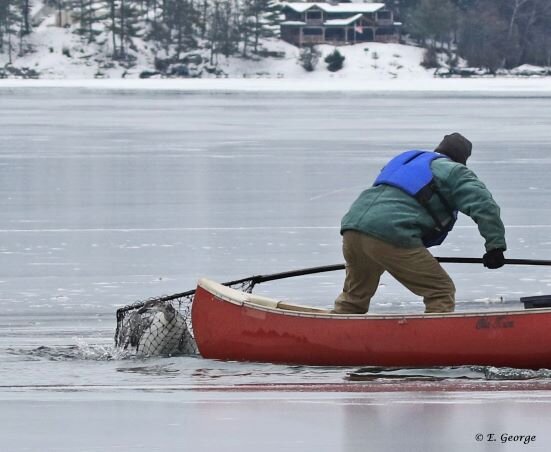

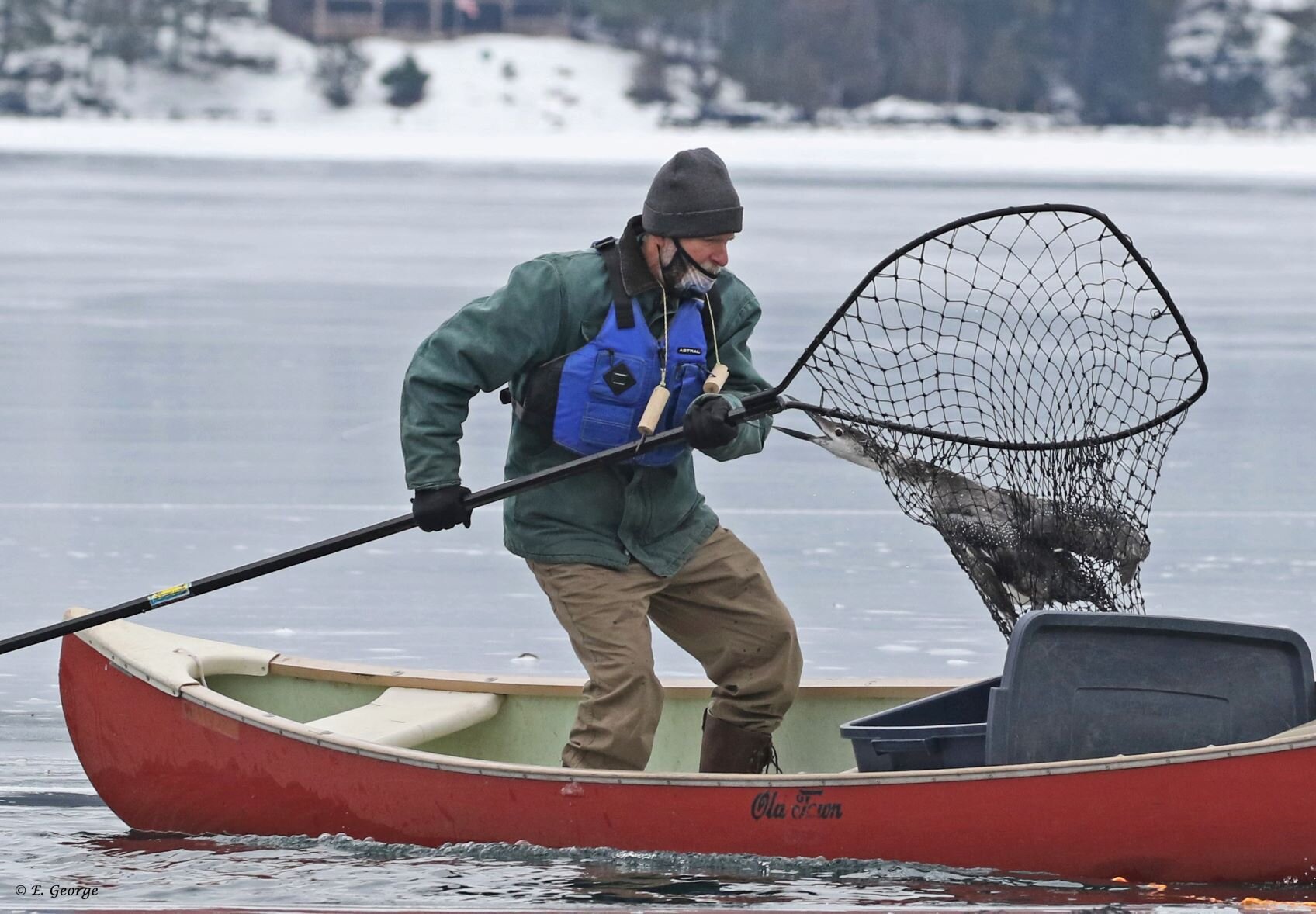
Matt quickly ran over (he was on the edge of the puddle with microspikes so he wouldn’t slip on the ice), pulled Lance to shore, and helped get the loon in the bin. After bringing the first loon to us waiting at the snow-ice edge, Matt returned to the puddle to try for loon #2.
After several attempts, Lance netted the second loon into its bin and it was soon next to the first. From his slightly higher vantage point, Lance let Matt know that the third loon was headed towards him, who quickly netted it from the edge of the puddle and carried it to Lance to place in the bin.

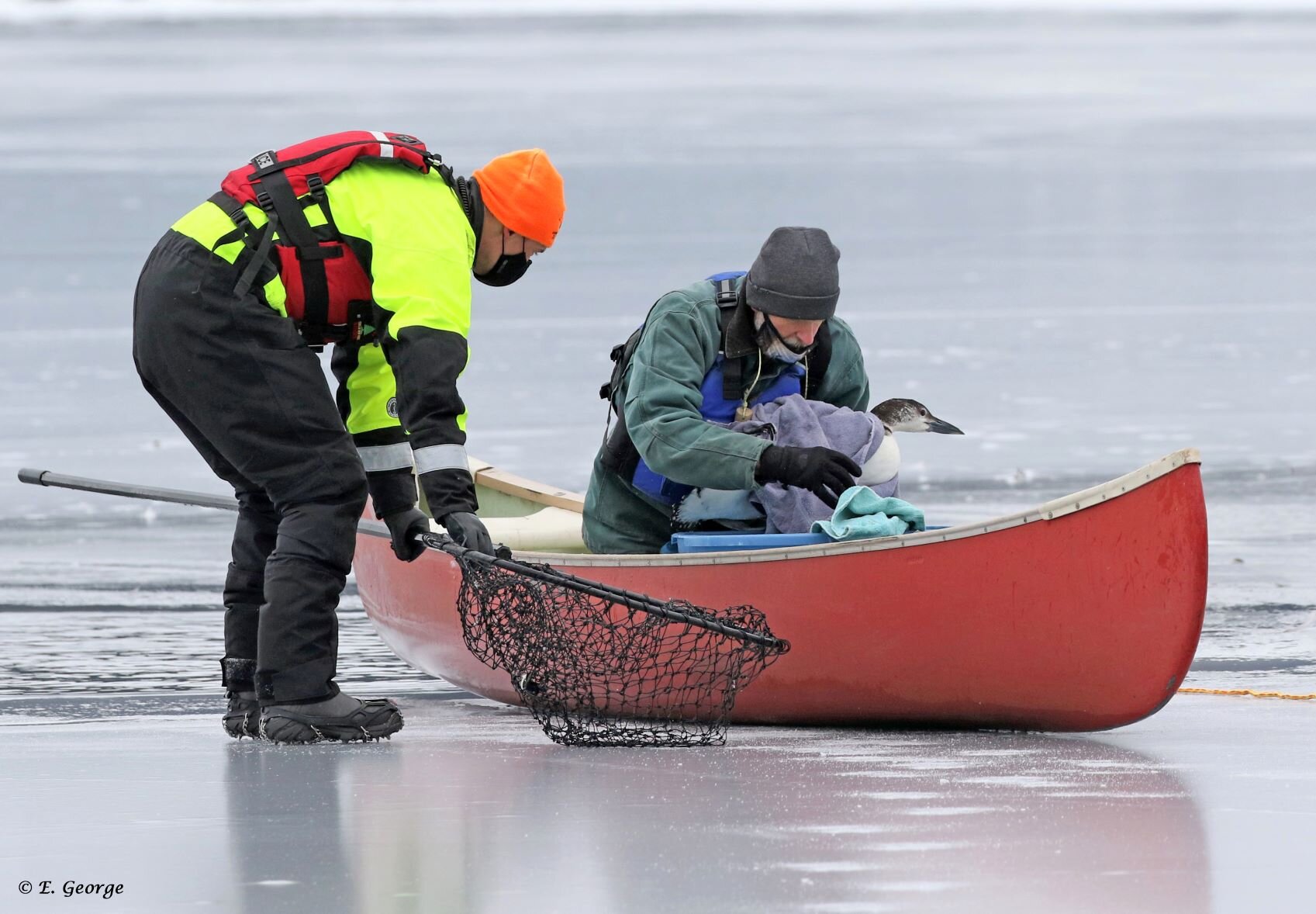

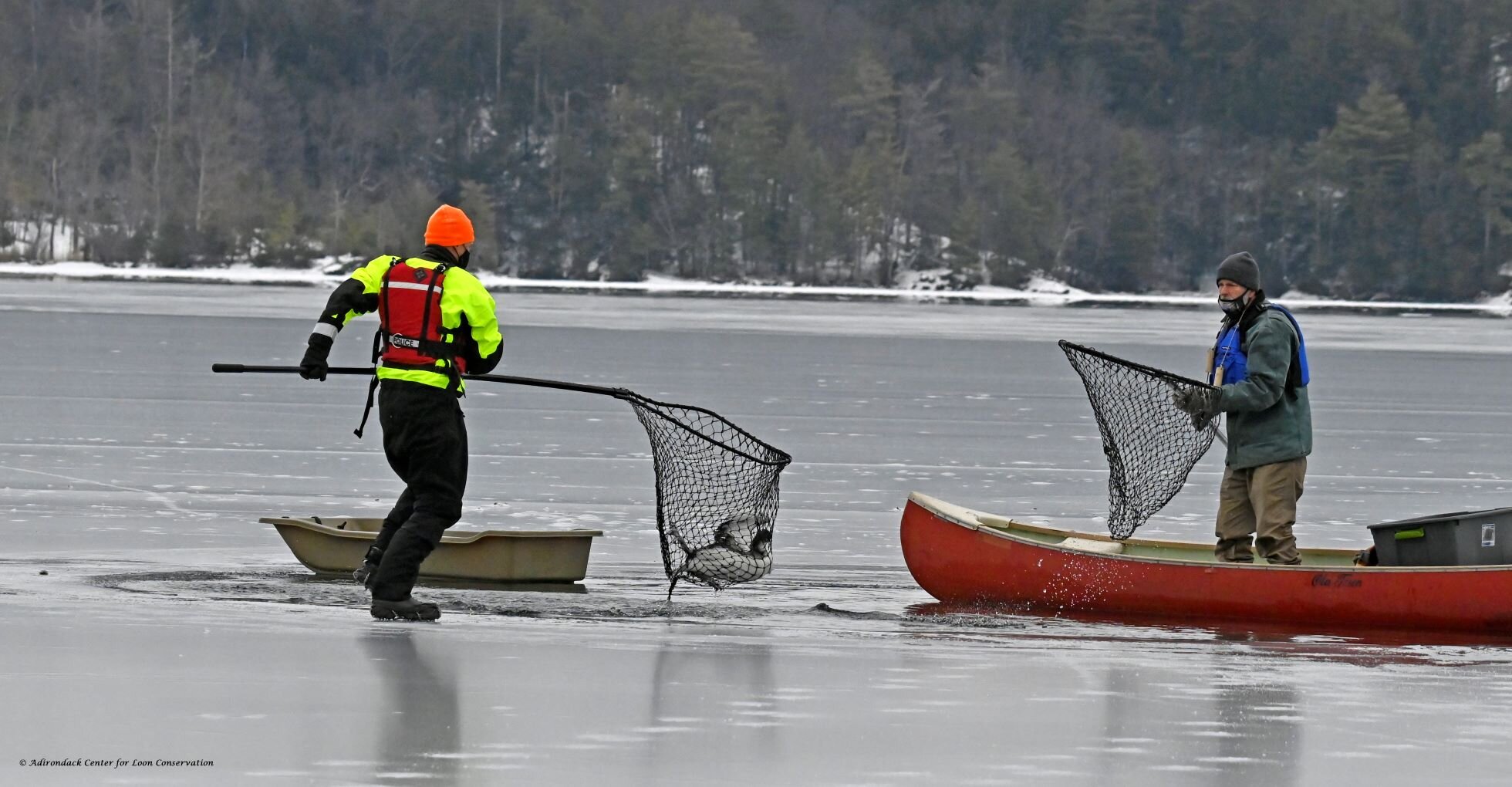
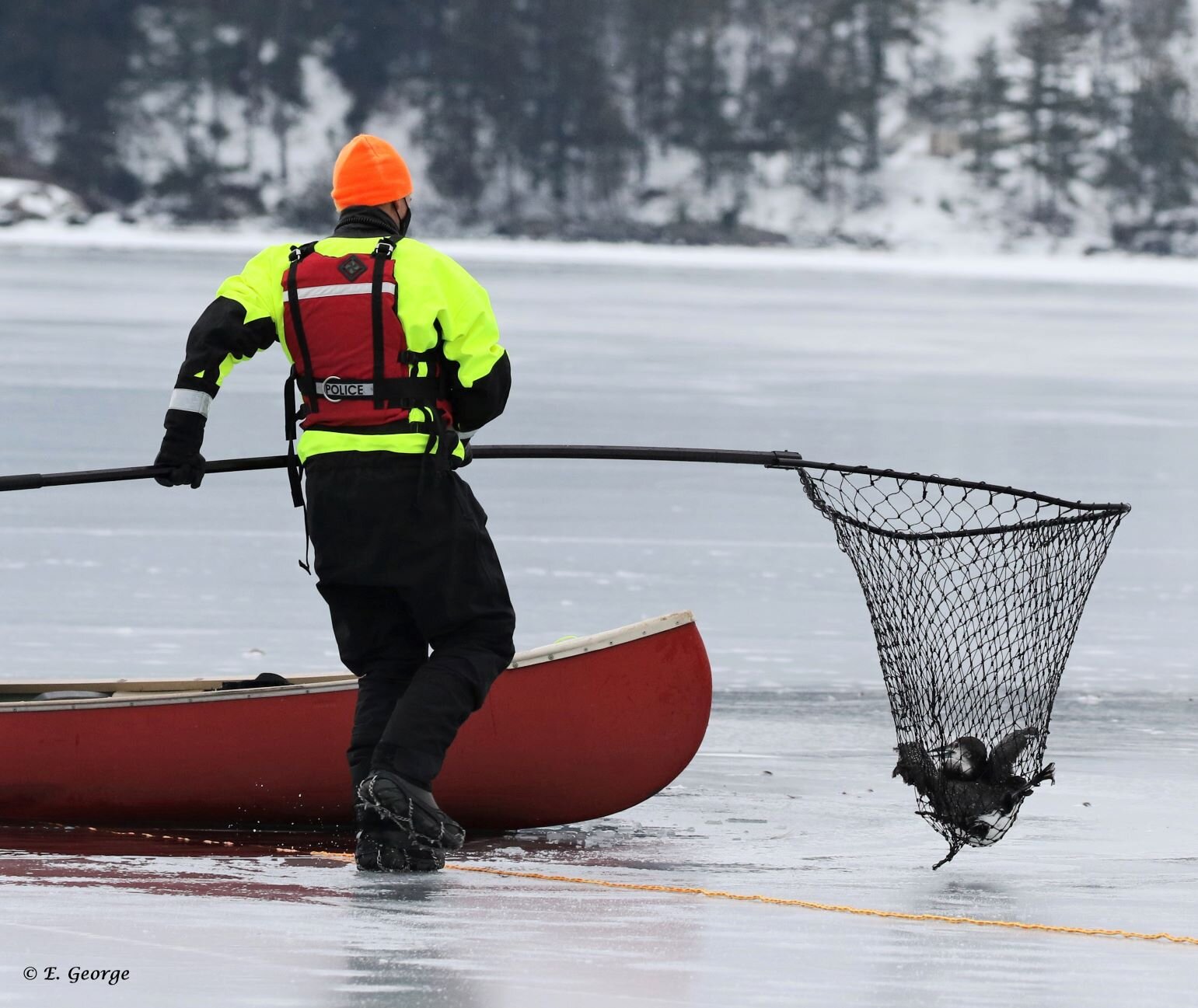

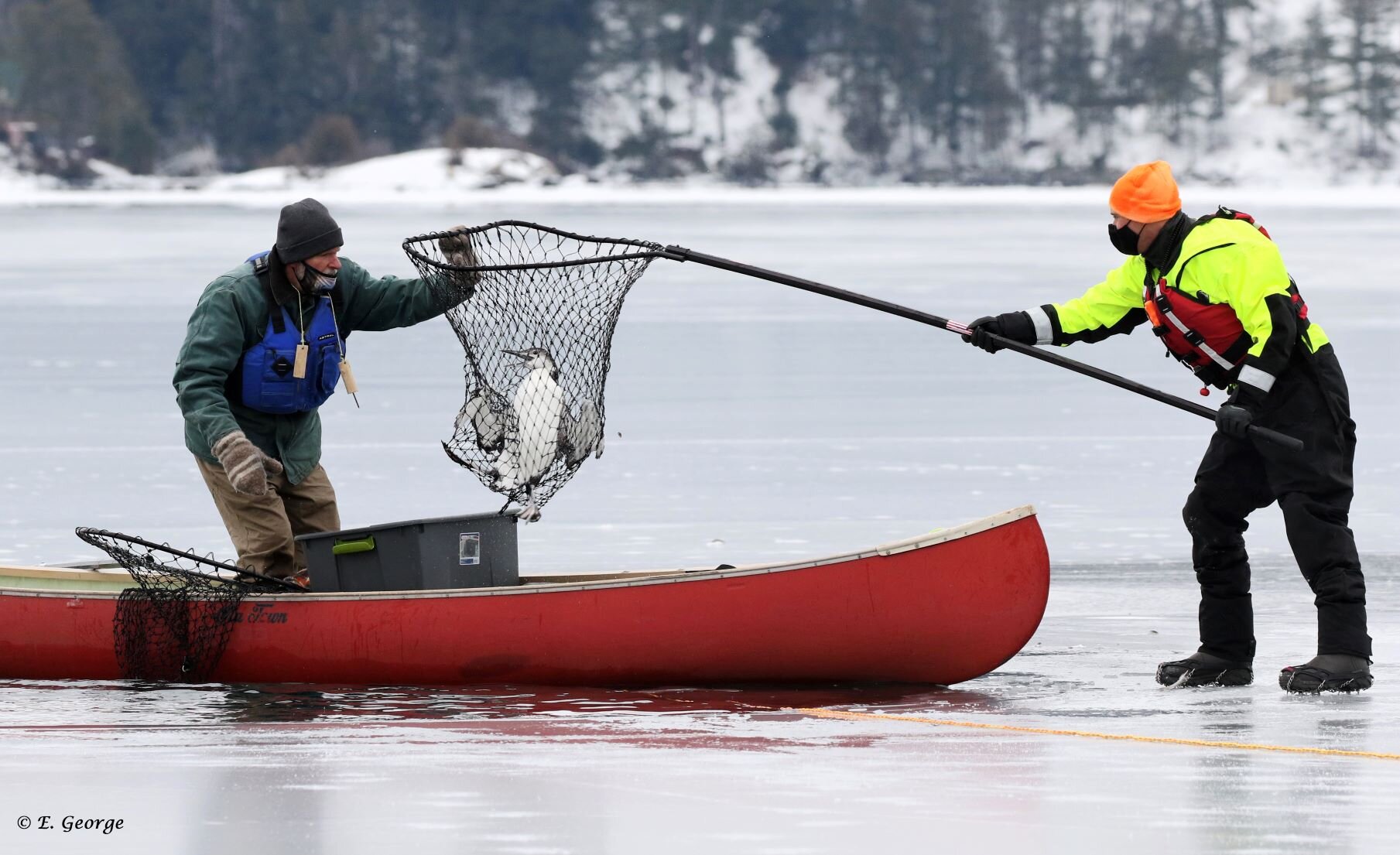
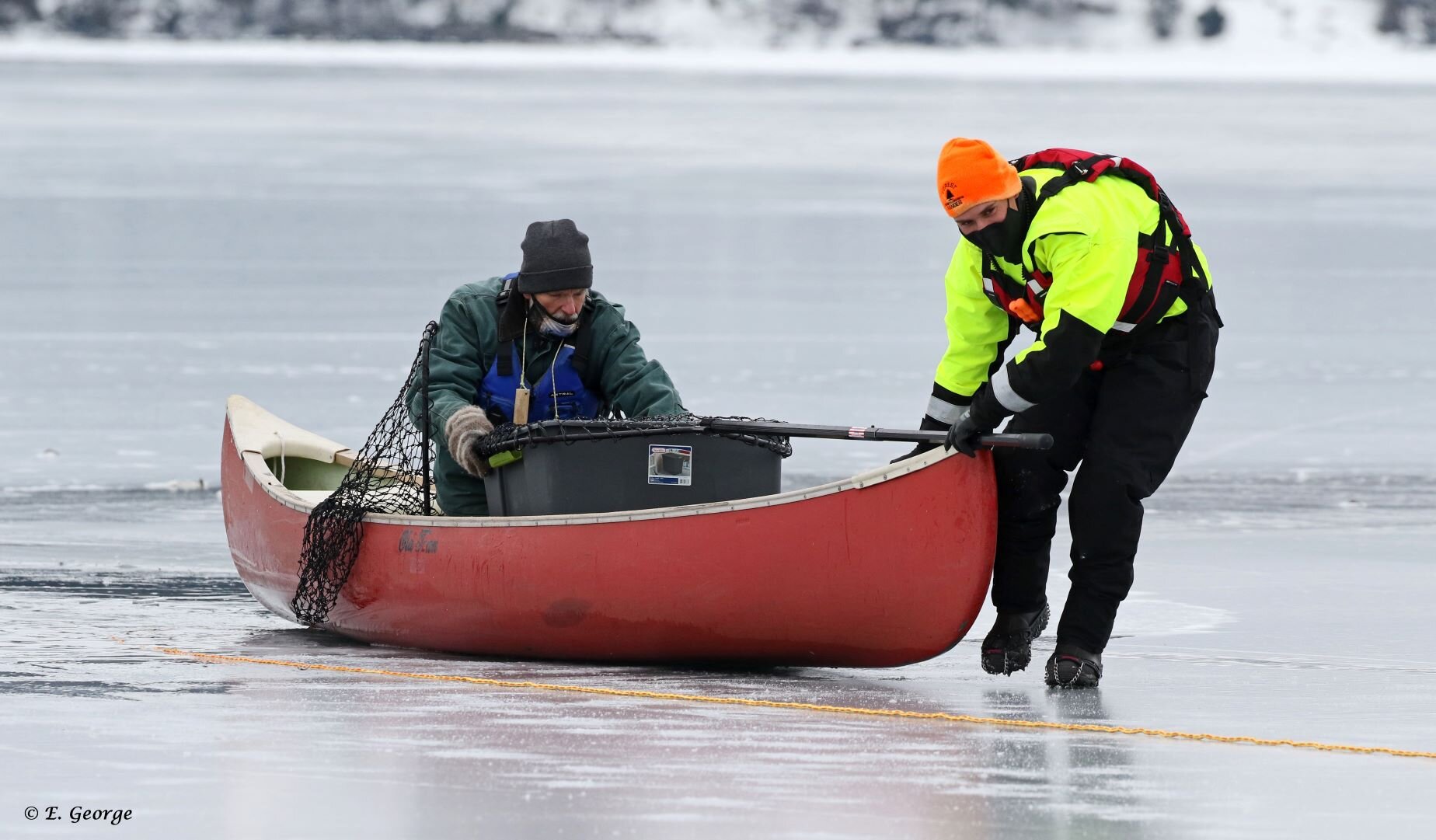
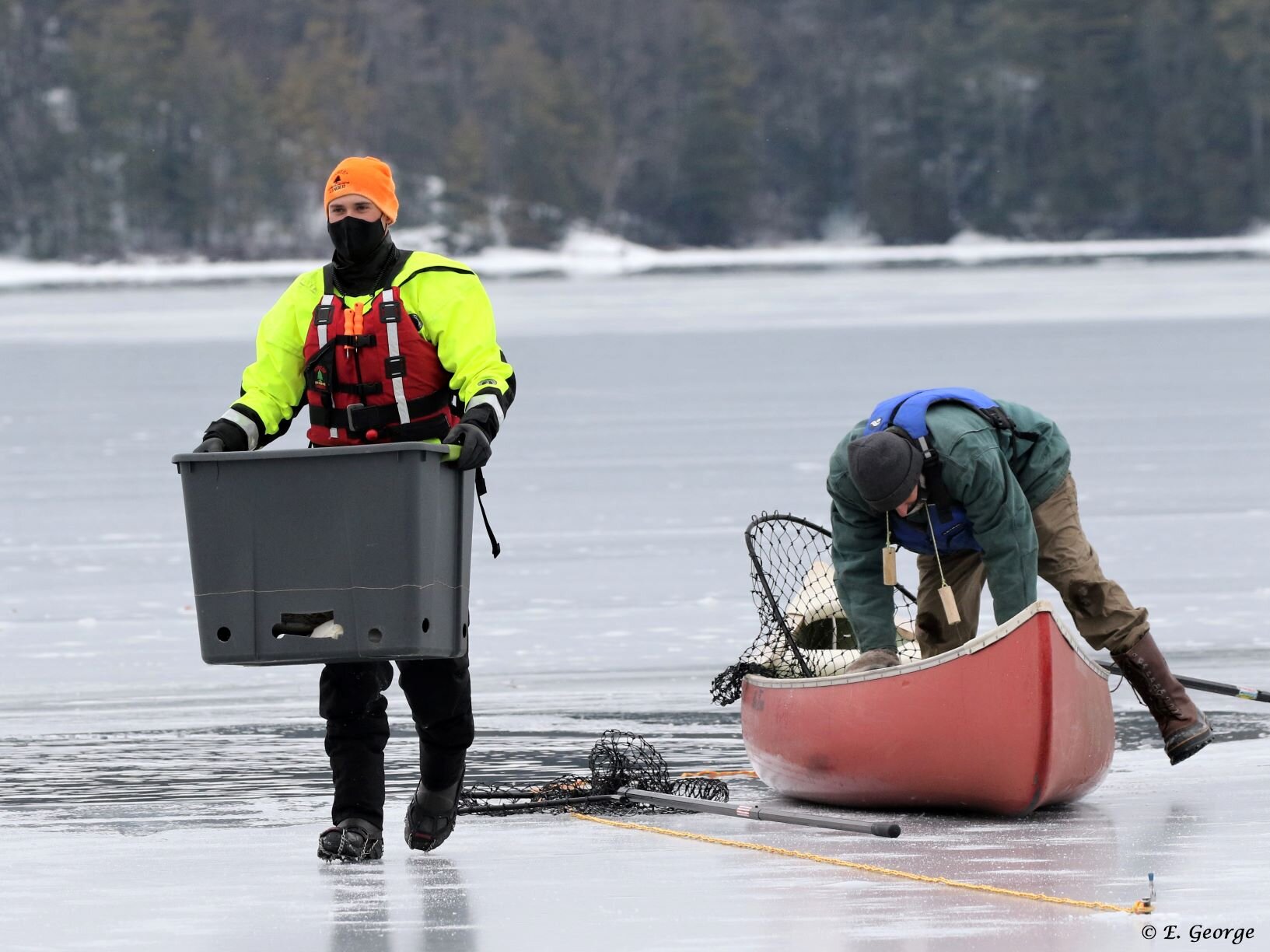
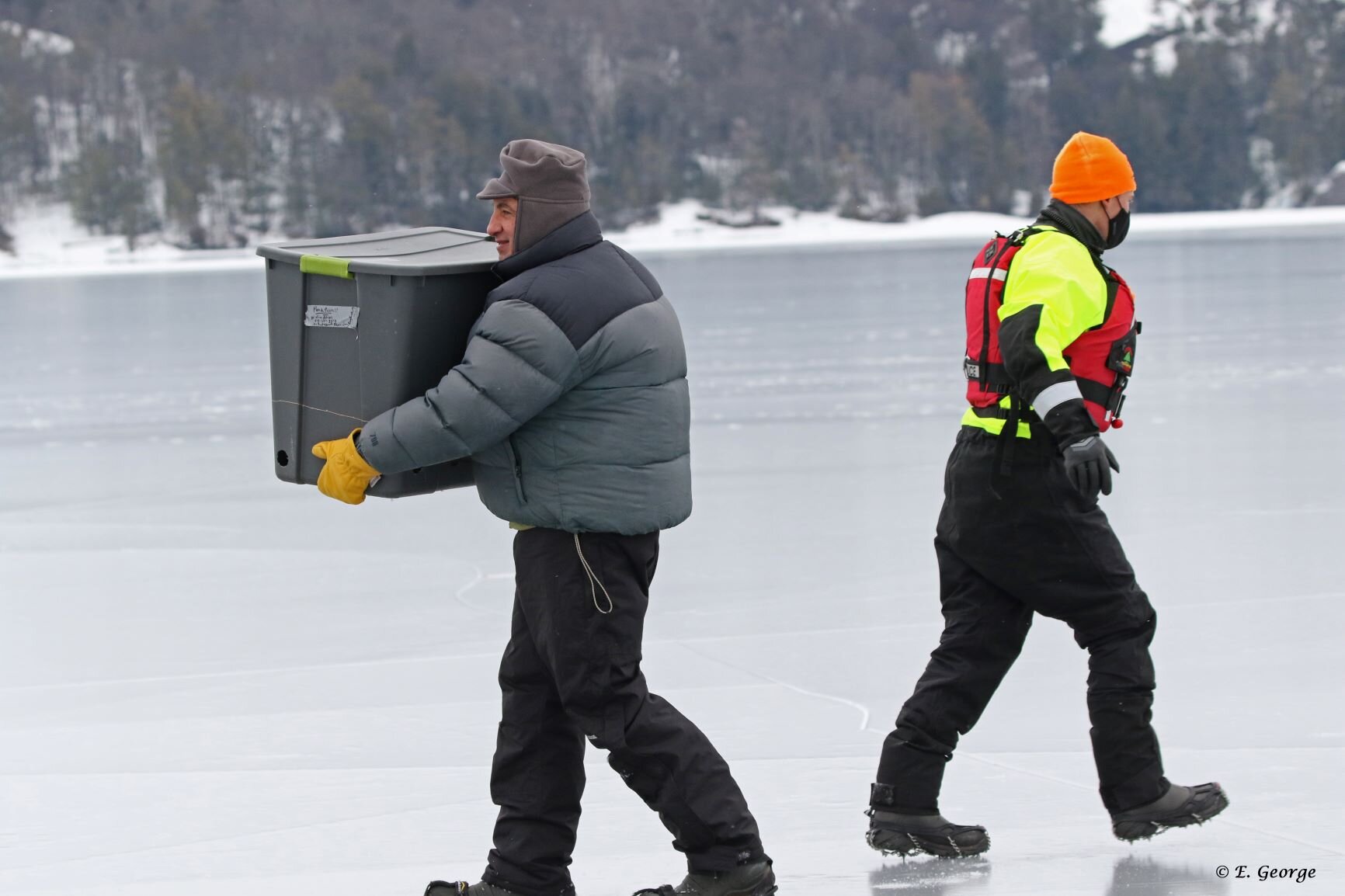
We put the bird bins and equipment on the sleds and in the canoe to slide them back to shore, and carry them up the hill to the cars and banding equipment. We examined each loon, measured it, and banded it.
All three were adults in good body condition, and molting out of their winter plumage into their breeding colors. The two males (based on their weight, ~11# each) were regrowing their primaries and may have been capable of flight. The smaller loon (~9#) had absolutely no flight feathers at all - they had completely molted out! So it would likely be several weeks before that bird would be able to fly.

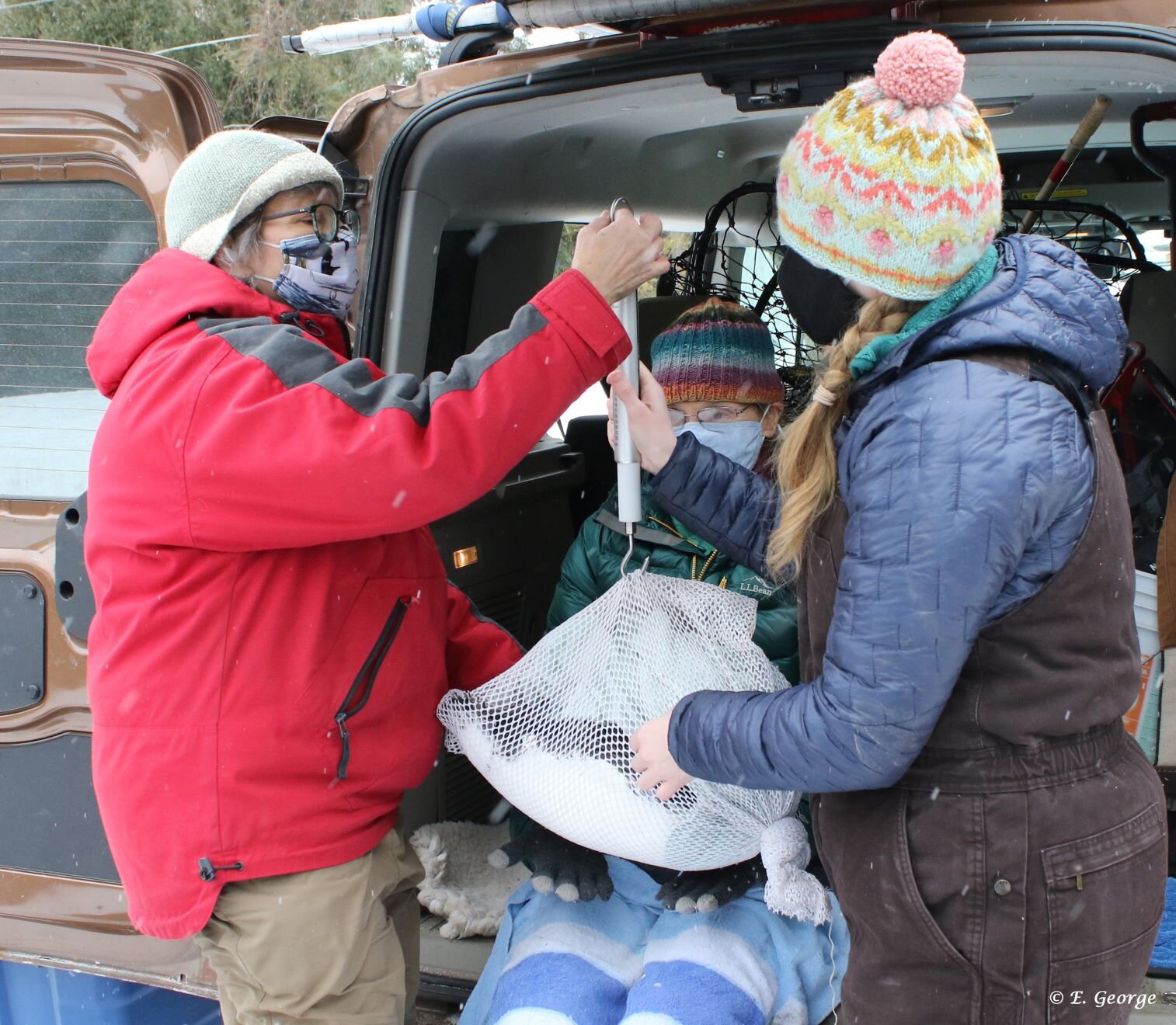


After they were measured and banded, we drove the loons to Lake Champlain where there was open water. They each swam quickly away from shore, and then gathered together and began preening. They were likely VERY relieved to be out of their predicament, and away from the eyes of the hungry eagle!
~MANY, MANY THANKS to Roger and Wendy Saks for giving us access to the lake, and to Forest Ranger Matt Savarie, our biologist Emily Prosser, and volunteers Lance Durfey, Malinda and Glen Chapman, Tim Demers, and Ellie and Cal George for their excellent assistance in this rescue!
11/5/20:“Loon Pond”, NY
October is a month of great change in the north country. It often starts out summer-like, and ends up like winter. Leaves fall off the trees, and most plants die back. Many creatures migrate, prepare to hibernate, or just plain die, as in the case of many insects and other invertebrates. And so it has been at Loon Pond.
On October 25 both loon chicks were still on the pond, although the father loon had left. But on October 27, only one chick remained. When a chick is all alone on a lake, it becomes more fearful and harder to approach, probably because it now lacks the support of its parents. This last chick kept its distance, and wailed twice when it saw me put my canoe in the pond. The chick was diving for fish, although I did not see it come up with any. When the fish captured are small, they are eaten underwater, but if a loon catches a large fish, it brings it to the surface to handle it and subdue it.
On October 28 and 29 the solo chick was still present, but on Halloween, no loons were left. A flock of 15 hooded mergansers fished the shallows, and a kingfisher rattle-cried as it flew along the shore. Although the day was in the mid-30's, the bright sun warmed up the air enough to encourage a trio of painted turtles to bask on a log, probably the last reptiles I'll see until next spring. The otter pup was fishing near a beaver lodge, and later dried off and took a nap right on a birch log that was part of the lodge. In the late afternoon a beaver swam to its winter food supply and slapped its tail at me while I was watching the otter pup. Then the beaver swam toward shore and ate some aquatic vegetation, maybe a few remaining lily pads.
The last 3 days had brought rain, snow, wind, a rainbow, and some temperatures at night in the mid-teens. This resulted in the surprise of finding the far west shallow end of the pond being mostly skimmed over with ice already. Winter is nipping at our heels.
Because the loons have migrated, this will be the last post about Loon Pond this year unless a loon is sighted again on the pond. I hope you have enjoyed reading these posts as much as I have enjoyed visiting the pond so often and watching the lives of the loons and other wildlife unfold. Please comment if you would like to see a return to Loon Pond next year when the loons migrate back, or if you would prefer that I post about a different pond or lake.
10/22/20:“Loon Pond”, NY
On October 22 a visit to Loon Pond found the father loon with just one chick. Remember that on October 15, the more independent chick was practicing take-offs and landings? Well, it appears that he/she left the pond, maybe for good. The remaining chick, who has been very clingy to the father, was still staying close and making low hoots and begging calls. The father was no longer feeding the chick, but he would dive to fish and the chick would also dive. The father loon continued to molt and look even more disheveled than last week as his gray and white winter plumage replaced his breeding plumage.
A pair of otters, seen last week also, were delightful to watch. The mother otter would dive and hide after she saw me, but the pup would continue to fish and surface with his/her catch if I kept a respectful distance. This was so rewarding, that I returned to Loon Pond for the next three days, mostly to watch the otters but also to see what was happening with the loons.
Before heading home on October 22, I stopped at Nearby Pond to see if any loons were left there. Remember that in the summer, intruder loons came from there to interact with the loons on Loon Pond, and also that the Loon Pond mother loon was observed visiting Nearby Pond. From shore, I spotted a loon way out on Nearby Pond, and with binoculars I could see that it was a chick! Nearby Pond did not even have a nest that I could find this year, and definitely no chicks, so it is highly likely that this was the missing Loon Pond chick.
The next day, October 23, I found the father loon with the dependent chick still on Loon Pond, and I watched the otters again. I also found the other chick still on Nearby Pond.
October 24 was crazy windy, with strong northwest winds that whipped Loon Pond into whitecaps and made for some difficult loon and otter watching. I did see the father loon with the dependent chick, and thought that this wind might encourage him to start his migration, pushing him southeast toward the Atlantic Ocean. I also spotted the mother otter, but not the pup.
October 25 brought change. I found and photographed the mother otter and pup, but the pond was quiet, with no loon sounds. Were there any loons left? Finally I sighted one chick in the far west end. I watched it for a while, and then the second chick surfaced! It must have flown back from Nearby Pond. Since the father was absent, the chicks were silent because there was no one to beg from. Probably those strong NW winds did start him on his migration. Every time I have visited Loon Pond since April, the father loon has been on the pond, never leaving to visit another pond or lake. This week's forecast is for cold weather, almost winter-like, with snow a definite possibility. Will the chicks be on the pond the next time I visit?
10/15/20: “Loon Pond”, NY
Both chicks and the father loon were still present on Loon Pond on October 15. The father loon was so advanced in molting into his winter plumage that he looked more like a chick than a breeding adult. His head and neck were mostly gray and white now, and his beak was also gray. He had lost half of his beautiful black feathers that are spotted with white, and several feathers drifted on the water's surface. His eyes were a duller red-brown instead of the crimson of the breeding season.
The chicks were both very vocal on this day, with lots of begging calls and wails. The father did not fish to feed them, but that did not stop the chicks from making hoarse, wheezy begging calls and sidling up to his neck and nibbling on his feathers. One of the chicks spent a lot of time by itself, wailing. It stretched its neck up and lifted its wings as if to feel the wind. I thought it was going to try to fly, because this is a pattern of behavior I have seen before in chicks learning to fly. The wind was increasing, and wind is a stimulus for chicks to try flying. The more wind, the greater the lift and the easier it is for them to get airborne. Learning to fly appears to be exciting and perhaps scary, because the chick about to fly calls a lot and acts very restless. Finally the chick started to run across the water into the wind, and just barely got airborne before dragging its feet and landing on its belly again on the pond. The other chick stayed with the father and continued to make begging calls.
The father loon has done a superb job of incubating the eggs, defending his territory, and feeding, raising, and protecting the two chicks. He should be leaving his offspring soon to migrate, and then the chicks will migrate on their own when they are ready. But perhaps he will stay longer until the next strong north winds blow.
Loon Pond held another surprise: an otter family! One otter, probably the mother, was swimming near the occupied beaver lodge and popped her head up to look at me. Two youngsters were further west near the old, unoccupied beaver lodge, and one of them was crunching loudly on a brown bullhead catfish.
A pair of adult hooded mergansers and two juvenile mergansers added to the wildlife action on the pond. And even though the foliage was well past peak, the golds and oranges were still intense enough to make beautiful reflections.
9/25/2020: “Loon Pond”, NY
It was Indian summer on September 25 at Loon Pond, with a warm late afternoon and heavy clouds starting to break up after rainfall earlier in the day. The foliage was at peak, making Loon Pond just another gorgeous water in the Adirondacks. A pair of hooded mergansers fished the swampy west end, while a belted kingfisher flew along the main shoreline, giving his rattle call along the way.
One loon chick was alone near the north shore, and a clear, pure tremolo call echoed across the waters. It sounded so much like the mother loon's tremolo, that I looked around to see if she had just surfaced nearby. But no, it was the chick's call. Usually chicks have calls that are thin and reedy and sound like they come from a cheap wooden toy flute, while the adults have rich, pure tones that sound as if they come from a well-made silver flute.
Then the father loon surfaced with the other chick begging from him on the south side of the pond. The father looked even grayer and more patchy than he did the last time I visited, since he is continuing to molt into his winter plumage. White curved feathers floated on the pond's surface, a testament to his preening out his old breeding plumage. The lone chick joined the father and his sibling, and they dove and fished together, heading east. One chick seemed to be doing most of the begging, while the other stayed off by itself.
The mother loon was absent. Either she was visiting another pond nearby, or she had left Loon Pond for the year, heading to bigger lakes to feed before migration, or perhaps had already started her migration south to the Atlantic Ocean. Loons may stop at water bodies en route to rest and feed, or if the distance is short enough, make the flight without stopping. Loons fly very fast, since they have to in order to keep their heavy bodies airborne. Also, since they are big birds, they can store energy in their bodies to fuel themselves for a long flight. Last year the mother loon left by late September, so it is probable that she has done the same this year.
In 2019 the father loon stayed with his two chicks into the middle of October. What will happen this year? When will the chicks leave? Stay tuned for the final chapters of the loons' lives on Loon Pond this year.
9/26/20: Lake Clear, NY
It was a clear blue day with a hint of hazy smoke from the fires out west in the air. The lake looked empty when we arrived on the beach with our boats, and I only spotted one loon when I scanned with my binoculars. After talking with a few people who were leaving the lake, we knew that there was a large group scattered at the other end. We paddled onto the glassy water and admired the red and yellow foliage that carpeted the hills and mountains around us.
After a few minutes, I did another scan and saw clusters of loons on the lake in the distance. It was hard to make out how many, but we could hear them hooting to each other, so we paddled in the direction of the most calls. As we moved closer, the scattered group surrounded us, calling back and forth to each other. We ended up seeing 47 loons that day.
Loons are leaving their breeding territories and congregating on large lakes to feed while they molt into their winter plumage. Once they finish their molt, they will leave the Adirondacks and migrate to the Atlantic Coast.
9/22/20: “Loon Pond”, NY
It was hat and gloves weather on September 19 at Loon Pond. The temperature dipped well below freezing early in the morning, but the loon family didn't seem to mind. The mother loon was fishing with the two chicks in the middle of the pond, while the father loon was by himself in the west end, preening. He was having a well-deserved break from parenting.
After about 20 minutes, the father joined the family, and the mother swam further away to take a break herself. The chicks were still begging from their parents, but they also dove each time a parent dove, and probably caught some fish for themselves. They would approach a parent that just surfaced by lying low in the water, snake-like, and then sidle up to a parent and nibble or poke them with their bills. The chicks also made wheezy begging calls.
The female is just starting to molt into winter plumage, and there were a few white feathers around the base of her bill. The male is much further along in his molt into his gray and white winter plumage, and he looks like a grizzled old man around his beak and neck. Note how the base of his beak itself is also turning gray. However, while graying is a sign of aging in humans, it is a sign of winter for loons, and all adult loons molt into this different plumage for spending winter on the ocean or southern reservoirs. Our Adirondack loons spend the winter along the Atlantic Coast probably from Long Island to Florida. Some might winter on freshwater in large southern reservoirs, such as in the Carolinas.
When will the parents leave to migrate? They have done their job, and the chicks are old enough and fully developed to fend for themselves. Some loon parents leave early, while others stay late into October. Some parents even wait for their chicks to leave first, but that is not as common as for the parents to depart first.
9/8/20: “Loon Pond”, NY
A morning visit on September 8 and an evening visit on September 10 found the whole loon family fishing together with no intruders. Both parents would dive for fish and the chicks would also dive. When they surfaced, at least one of the chicks would beg for food from the nearest adult. Chicks beg by rubbing their heads and necks on the parent's head and neck, and also by poking or nibbling the parent's neck with their bill. The chicks also make loud wheezy noises, and these begging behaviors are usually annoying enough to make the parent dive again to try to feed the chicks. Although the chicks are still begging for fish and being fed by their parents, they are now over three months old and should be able to feed themselves and fly. Do not be surprised if one or both parents depart the pond for the winter soon, leaving the chicks to fend for themselves.
The female has not started molting much yet, but the father loon is growing in winter plumage, white feathers around the base of his beak and also molting some back feathers where you can see missing spots. His beak is turning gray at the base, and it will turn all gray just like the chick's beak by winter. His legs and feet will also turn from black to gray. Loons molt at different rates, but most are starting now. You may find loon feathers floating on the water or washed up on shore. Fortunately, loons do not molt their flight feathers until later in the winter, after they have reached their wintering areas, usually on the ocean.
The early autumn weather with cooling temperatures might nudge loons and other birds south a bit early this year. Stay tuned to find out when the parents migrate, and when the chicks finally head off on their own.
8/19/20: “Roadi” the rescued juvenile loon
On August 19th, the Adirondack Center for Loon Conservation got a call from a person who had found a loon on a road the night before. The kind man scooped up the loon and put it in a large plastic bin and brought it to his home. Two ACLC field staff responded, went to his house, and took the loon home to my house, which is nearby on Paradox Lake. Our plan was to assess its health and then release it on the lake, which is good-sized and has a loon pair breeding on both the upper and lower parts of the lake.
The loon was a chick and might have been on its first flight off its natal lake. The evening before had thunderstorms and some high winds, and the chick may have been blown away from its lake. Loons need to land on water, since they slide on their bellies to land. A wet road may look like a river to waterfowl, and occasionally a loon or other water bird lands accidentally on a road. Loons cannot take off from a road but need a long stretch of water to run on. Often, they get injured when landing on such a hard surface.
Nina Schoch decided to come out to assess the chick’s health and to band it so we would know if we found the chick again in the future and gain some knowledge from re-sighting it. The chick was small which indicated that it was probably a female. She was fully feathered and was developed enough for flight. Nina did not find any evidence of significant injury. She took measurements and banded the chick with 3 colored plastic leg bands and one metal band with a USGS ID number, as we do for all our study loons. The unique combination of band colors, two bands on each leg, enables us to identify a loon as an individual.
Next, we put water in the bin and set the chick back in to see if she could swim. We were looking to see if the chick would float and swim without listing to one side, and if her feathers were waterproof, indicating that the chick was healthy and had been caring for its plumage. The chick seemed happy to be back in water and swam well. She even took a nip at Nina’s pants when she walked close to the bin.
Nina carried the chick down to the lake, and I gently released her. She slowly swam out into deeper water, then dove for a short time. She resurfaced and did a wing flap, another sign that she was normal and healthy. We watched her swim on the surface and dive a few more times, getting smaller as she got further away, before we headed back.
The next day I was eager to canoe on the lake and look for Roadi, the name I had given her for her road landing. I located five adult loons interacting in the middle of the upper lake, and then found a loon chick in Le Goy’s Bay. This chick was not banded, however, so it had to be one of the pair of chicks that hatched on the upper lake this June. I did not find the second chick, though, so I wondered if Roadi might be that second chick. Paradox Lake is one of the closest lakes or ponds near where the chick had come down on the road, so we thought that maybe it was her natal lake. As I paddled into the Narrows, I spotted a loon chick up ahead. The chick swam toward me and was not afraid of me. I used binoculars to look for its leg bands, and I saw a flash of red in the water. It was Roadi! On her left leg she has a silver band over a red band with a white dot, and on her right leg she has a green band over a blue band. Soon I was able to see all her bands. She was quite friendly and allowed me to follow her and watch her dive and fish. After some time, I paddled back, thinking that she was one of the Paradox pair of chicks, and glad that she was back safely on the lake.
Five days later, on August 25, I paddled out to search for Roadi and the other Paradox chick. I noticed loons feeding in Le Goy’s Bay and went over to see who it was. Just as I was approaching, another adult loon flew over, giving flight calls. The two loon parents, who had probably been feeding chicks, swam out of the bay to investigate this visiting loon. Then I spotted a loon chick, and then another. Were either of these Roadi? My eye caught motion and I spotted a third chick! This chick was a little smaller and darker in color, and as I paddled closer, I could see colored bands! It was Roadi, together with the two Paradox chicks and a few minutes ago with their parents.
We had wondered if the Paradox loon parents would possibly harm Roadi or try to drive her away if she was not one of their chicks. Apparently, this did not happen, and it is possible that they might have even fed her along with their own two chicks. Unfortunately, I arrived just a few minutes too late to see if this had happened.
The two Paradox loon chicks hunkered low in the water and hid as their parents went out to interact with the visiting loon. This is normal behavior. Roadi, however, swam tall and headed toward the Narrows. The wind was picking up, and she raised her wings to feel the wind. Then she started to run across the water, flapping her wings as if to take flight. After a few seconds she slid back down onto the water, ending her trial take-off. She did two more short take-off attempts, doing a little preening right before lifting her wings to test the wind. Then suddenly she started running into the wind even faster than before, flapping hard. As I watched and photographed, she lifted off the water and was flying! She flew straight east down the Narrows but then circled west. She made three large circles over the west end of the Narrows, getting higher in the sky each time. And then she was gone, out of sight.
Would I ever see Roadi again?
I have been out on Paradox Lake twice since then, looking for her. I found both Paradox chicks fishing with their parents in the inlet cove one day. A few days later I found only one of the Paradox chicks by itself, but three adults were interacting not far away. I will keep looking and I hope I see her again this year, but if not, maybe after 3 or 4 years if she survives, she will migrate back from the ocean and I will see her on Paradox or another nearby lake or pond when she is an adult and seeking a breeding territory of her own.
9/5/20 ~ “Loon Pond”, NY
September started rainy and calm at Loon Pond. For once, there were no intruder loons in the morning, just a misty rain making photography difficult. The loon family didn't mind, though, as the chicks were busy begging from both of the parents, and the parent loons were busy diving to catch fish for the chicks. The chicks are now two months old, and are almost as big as their mom and dad! They are fully feathered in juvenile plumage, handsome in their gray scalloped feathers with white margins. They will be practicing take-offs and landings a lot, and should be able to fly in less than two weeks. Two days previously, a visit just to the shore of the pond was rewarded by watching one of the chicks attempting a short run across the water, flapping its wings in an effort to get airborne. Chicks are stimulated to fly by windy weather, but this morning was almost windless.
The adult loons are easy to tell apart now, because the male has already started to molt into his gray and white winter plumage. You can see his new gray feathers around the base of his beak. Loons molt all of their beautiful black and white spotted feathers except for their flight feathers in the fall, and become gray and white, looking a lot like their chicks. Some loons migrate early and do most of their molting while they live on the ocean, but others stay later on freshwater ponds and lakes, and may become almost all gray and white before they migrate.
In the shallow back part of the pond, a bullfrog rested on the end of a beaver-chewed log. A great blue heron hunted for frogs and fish in the lily pads. Warblers fed in the trees along the shore, fattening up for their southward migration. Soon they will be gone. Some early red maple leaves were already scarlet, igniting the start of the autumn foliage extravaganza. The seasons change fast in the Adirondacks, with the daylight shrinking by three minutes every day now.
8/26/20: “Loon Pond”, NY
Fog ruled the morning at Loon Pond. The mother loon flew off the pond at 7:10 AM, heading in the direction of Nearby Pond. The father loon was tending the two chicks in the northwest end. The chicks are now 7 weeks old, and they are almost all gray and white in their juvenile plumage. The gray feathers on their backs are edged with white, giving them a scalloped appearance, and the only remaining brown down is on their necks and along the hind edges of their backs. In a week they should be completely gray and white, with their flight feathers also developed. The chicks will make many wing flaps and start to practice take-offs by running across the water and flapping their wings by the time they reach 10 weeks of age. By 12 weeks, they should be able to fly and take care of themselves.
At 7:30 AM, a pair of loons flying side by side plus a third loon trailing behind flew over the pond from east to west and kept going. But at 7:32, the loon pair flew back and landed on the east end of the pond. One of these loons was the mother of the chicks. The father loon swam out to meet the pair, while the chicks hid along the north shore. The three adult loons circled, and at one point the father loon reared up in a penguin dance, which made the visiting loon wing-row away, straight toward the loon monitor! After that, the visitor would dive and try to keep its distance from the territorial pair.
Photos of the visiting loon suggest an interesting identity. Although the loon was not banded, it did have a downward curving beak, significantly more than most loons, who generally have straight beaks. In 2017, the territorial male who was mated to the banded female at that time had a bill like this. He successfully raised two chicks with the female but was defeated by the current male in the spring of 2018. It is possible that he was the visiting loon, and the action of the father loon penguin dancing to drive him away suggests that the visiting loon may have been a male, since the visitor was not anywhere near the chicks, yet the father loon still wanted him gone.
At about 9 AM the visiting loon and the mother of the chicks took flight. The father loon fished to feed the chicks. In late August and September it is common for loons to leave their ponds and visit other loons on different ponds. Females tend to do this more than males, who are more territorial, especially if they have chicks. As hormone levels drop, loons become more social and seek out the company of other loons before migration.
This was the last week of the ACLC’s field season, so this is the last regular weekly post. Your loon monitor, photographer, and writer has been Ellie George. Hyla Howe has edited and posted the accounts. However, if you are a fan of Loon Pond, do not despair. Ellie loves Loon Pond and often visits it on her own time, so there may be a few more posts into the autumn so we can all see if the chicks survive until they migrate.
Last year the current banded loon pair also raised two chicks, and by mid-September the female left the pond for migration. The male stayed on into October still feeding the chicks, who hatched late last year, in the second half of July. Then he left for migration, and the chicks stayed on Loon Pond until late October. Loon Pond is shallow and freezes over by late November or even earlier in a normal autumn. Loon parents usually migrate before the chicks, and often leave at different times and spend the winter in different areas. The chicks manage to find their own way to the coast of the Atlantic Ocean where they will spend the winter and also the next 2 to 3 years while they mature into adults.
8/19/20: “Loon Pond”, NY
At 7:00 AM, four adult loons were interacting in the middle of Loon Pond. Both chicks were hiding near shore on the north side, lying low in the water so that their heads and necks were on the water. The chicks seem to know either instinctively or from their parents teaching them that other adult loons are to be avoided. The father of the chicks swam toward them, but one of the intruders started to approach also. The loon father reared up in a penguin dance, which is the most aggressive display that a loon makes. The intruder wing-rowed away, not wanting to risk a fight.
The mother and father loons paired off and swam together to seek the two intruders, who had also paired off. The two pairs approached each other, then circle danced and splash dove. One intruder broke away from the group, and started running on the water to take flight at about 8:00. It flew two laps around the pond while it worked to get enough elevation to clear the trees, then it headed in the direction of Nearby Pond.
The remaining intruder played hide and seek with the territorial pair, but finally took flight also, heading west at 8:20. A minute later, the mother of the chicks ran on the surface to take flight, and the photo shows her just getting airborne, displaying all four of her identifying bands. She headed in the direction of Nearby Pond, but returned to Loon Pond in less than ten minutes, landing near her mate.
The father loon started to make low hoot calls, calling the chicks to come out of hiding and join the parents. First one and then the other chick swam toward Dad and Mom, and quickly started to beg for food, making wheezy begging calls and rubbing their heads and necks on the parents' necks. Sometimes chicks poke and nibble their parents' necks trying to urge them to fish for them. The parents obliged and started to dive for food. The chicks are 6 weeks old and are beginning to molt into feathers that will allow them to start hunting for their own food.
8/12/20: “Loon Pond”, NY
It was a quiet morning on Loon Pond on August 5th. The female was not on the pond at 7:30, but two long parallel lines of bubbles in the east end suggested that she and another loon, probably that frequent female intruder, had recently flown off the pond together. Since loons have to run across the surface of the water while flapping their wings for several hundred yards in order to get enough lift to take flight, the series of splashes can often be heard or the bubbles that they leave behind can be seen afterward. It is likely that the two loons were visiting Nearby Pond, since last week the female of Loon Pond was observed there with two other loons.
The male was in the west end with the two chicks, who are now 5 weeks old. See how funny the chicks look, since they are molting their fuzzy brown down and replacing it with sleek gray and white juvenile plumage! Molting starts on the head around the beak and eyes, and the chicks' heads are now getting light colored. Also, you can see some of the scalloped gray and white contour feathers on their backs. By the time the chicks are 8 weeks old, they will be in full juvenile plumage and look beautiful again in their new feathers, but for the next 3 weeks they will be pretty goofy looking. Their flight feathers are growing in also, and the chicks will perform many wing stretches and wing flaps as they develop their muscles for flight and get used to their new feathers. Lots of preening occurs during the molt as the chicks remove old down.
An unbanded loon flew overhead at 8:00 AM heading west, but did not land on the pond. Then at 8:30 the mother of the chicks flew in from the direction of Nearby Pond and landed near the loon monitor. Of course, the monitor moved further away from the loon family so they would not be stressed. The parents started to dive to fish for the chicks, while the chicks waited on the surface for their breakfast to be delivered.
8/10/20: Loon Drama on an Adirondack Lake!
We got a heartbreaking update from one of our field staff last week **Not on Loon Pond**.
“Wow. I saw some loon drama this week. When I first arrived everything seemed "normal". The chick was with an adult bird swimming about and peering as the adult dived around it. But then the adult seemed to leave the chick floating in the center of the lake by itself.
An adult loon wing rowing.
An adult eventually reappeared next to the chick, and I initially assumed it was one of the parent birds. But it proceeded to attack and kill the chick, using its beak to spear or hold the chick underwater, and to beat the chick with its wings. The chick made several attempts to swim away, but the adult was having none of it. The chick eventually died and floated belly-up. At that point one of the other loons joined the attacking male. As it approached within 20' or so, a mature bald eagle swooped down between the two birds and grabbed the dead chick and flew away with it. This elicited calls from both the adults, and shortly thereafter the attacking male did a short penguin dance. The other adult bird did a short wing-walk away. It was not clear to me if the penguin dance and wing walk were in response to the eagle or a loon-to-loon interaction. But wow.”
As the NY loon population has gradually increased since the 1970s (when DDT was banned), good territories are now filled and the resident breeding birds are often being challenged by “intruding” loons who want to take over the territory (like the birds on Loon Pond). The intruders will kill chicks and fight with the adults, sometimes mortally wounding them. This is a sad consequence of progress, similar to the increased predation from the recovering bald eagle population.
8/2/20: “Loon Pond”, NY
On the morning of July 27, the territorial female, mother of the two chicks, was busy interacting with an unbanded female intruder in the east end of Loon Pond. Sounds familiar by now, doesn't it? During almost every visit in the morning, the mother loon is trying to drive off a female intruder, and sometimes there is more than one intruder. This time, the pair of females circle danced, stared at each other (with no social distancing), and splash dove together. Finally at about 8:00 AM the intruder flew off toward the west, and the image of the flying loon is the intruder. Note how loons hold their legs out behind them when they fly, and how they hold their feet together to reduce drag in the air.
Meanwhile, the male was caring for the chicks, which are almost four weeks old. They are still in brown down, but soon will start to grow in their gray and white contour feathers, their juvenile plumage. The chicks are growing well and appear to be about equal in size, meaning that they are both getting enough food. Also, they do not beg much from their parent, another indication that they are well fed.
Way down in the boggy west end of the pond, an otter pup was squeaking for its mother. The otter was climbing around on an abandoned beaver lodge and swimming around the base of it, calling for Mom.
On August 1st, our intrepid loon monitor visited a pond close to Loon Pond, which we shall call Nearby Pond. The purpose was to try to figure out where the intruder female comes from, by hopefully seeing her return or take off in the morning, and seeing which direction she heads. Nearby Pond used to be part of the Loon Pond loons' territory about 12 years ago. But then 10 years ago, a pair of loons settled on Nearby Pond and claimed it as their own territory. There were many noisy interactions between the loons of both ponds for the first two years, which happened on Nearby Pond. The Loon Pond loons would fly over there and interact, but would eventually fly back to Loon Pond. Nearby Pond is not as good a territory as Loon Pond. The loons there have fledged only one chick in the past 10 years, while the Loon Pond loons have fledged about 10 chicks during that same time period.
Our monitor arrived on Nearby Pond to find two adult loons together on the water. An unbanded loon flew overhead but did not land on the pond. Then a third loon surfaced some distance away, and swam toward the pair. The loon pair wailed and tremoloed, and the third loon, obviously an intruder, wailed back. The three loons vocalized a lot but never got close enough to circle dance. One of the loons did some wing-rowing, and tensions were high but no fighting was observed. Our monitor managed to paddle close enough to the intruder to look for bands on its legs. Surprise!! The intruder loon was none other than the Loon Pond female! The tables had turned.
Why would the Loon Pond female, who has 2 chicks on Loon Pond, be visiting Nearby Pond? Perhaps she came to fish or just to visit the other loons. Loons are actually social birds when they are not breeding, and hormone levels decrease as summer wears on, making loons more tolerant of each other. By late August, loon "parties", social gatherings of up to 12 or more loons, may be seen on some ponds and lakes. Or, maybe the Loon Pond female had chased the intruder female off of Loon Pond before the monitor arrived at Nearby Pond, and she followed the intruder to Nearby Pond and landed there. The Loon Pond female has been observed to fly off Loon Pond and follow the intruder. Also, the Loon Pond female was the territorial female 12 years back when Nearby Pond was part of her territory along with Loon Pond, so she may still feel some ownership there. Whatever the reason, the Loon Pond female took flight at 10 AM and headed back toward Loon Pond, giving flight calls as she winged away.
7/21/20: “Loon Pond”, NY
July 21 was a fairly calm morning on Loon Pond. The territorial female, mother of the two chicks, was playing hide and seek with a female intruder. Intruders visit ponds to search for a territory to take over, either at that time or in the future. A good territory, one with plenty of fish, big enough for a loon to run on the water to take off, and having secure nesting sites like islands or bog mats, is necessary for a loon pair to breed successfully. Loon Pond is a good loon territory, fulfilling all those requirements, and the loons breeding there have been very successful, making it a desirable territory for a take-over by another loon. Intruders look for chicks on a pond, because then they know that it is a productive territory.
Loons also visit other ponds especially later in summer just to socialize. Loons without chicks are "on vacation", and have time to visit nearby ponds to interact with other loons. Loons are very social birds except during breeding season, and as their hormone levels drop in late summer, groups of loons of 10 or more may be found on some ponds and lakes. Fighting does not usually occur during these "loon parties".
The territorial male on Loon Pond was busy caring for the two chicks, which are growing well. One chick was still back-riding, which is uncommon after the chicks are two weeks old. The Loon Pond chicks are now three weeks old, and you can see how big and heavy the chick is since it covers half of its father's back and sinks Dad low into the water. Both chicks are very capable swimmers and can dive and stay underwater for some time. The chicks are still in the brown down stage of development, but in a couple of weeks will start to grow in their gray and white juvenile plumage.
The intruder took flight, and the Loon Pond female flew off after her. Soon after, the Loon Pond female returned, and the photo shows her flying back over the pond.
7/18/20: “Loon Pond”, NY
On July 18, the day of the annual loon census, the loon parents were in the east end feeding their chicks at 8:00 AM when the census started. At 8:15, two pairs of loons flew over the pond together, and they turned back and all four loons landed on the pond. The parents stashed their chicks along shore and interacted with the four intruders. There was much staring, circling, splash diving, and several eruptions into penguin dancing, yodeling, and tremoloing. Often the six adult loons swam together peacefully, but then they would get nervous, tuck their bills, and one would dive. This prompted the others to splash dive and all would be underwater for a while. Then they would all surface at about the same time, and sometimes the parents would penguin dance and the male would yodel. The intruders would wing-row away, but then come back again. You can see the bands on the male's legs in one of the penguin dance photos.
After about 45 minutes, a fawn swam across the pond and swam right past the loons! The loons watched it but were not alarmed by it. The fawn made it successfully across the pond and climbed up into the woods. No doe was seen.
At 9:20 AM the first intruder flew off the pond, followed by the second at 9:30. Finally, at about 10:00 AM the remaining two intruders flew off the pond together, leaving the parents to find their chicks. The parent loons swam to the north shore and quickly relocated their chicks, and then took them to the west end to fish and feed them. It was a relief to see that the chicks survived this intruder invasion, and appear to be growing well despite all of these interruptions to parental care.
Wowza!! What a day on Loon Pond!
7/15/20: “Loon Pond”, NY
The chicks are both thriving on Loon Pond, despite the chaos of two intruder loons who come every morning and stay for several hours before finally being chased off or flying off on their own.
The chicks are now in the brown down stage of development, and you can see that their beaks are elongating a bit. Look how big they are already! They will only back-ride for a few more days.
Between 6 and 7 AM every day, the two intruder loons fly in. One is the female who is missing the right wing feather. The mother of the chicks spends all of her time trying to locate the invaders and then circle dancing, staring, and diving with them. The father usually stays with the chicks, but sometimes he stashes the chicks along shore by themselves, and joins the fray.
He engaged the female intruder missing the wing feather in a long wing-row chase, and he almost caught up to her. After finally getting away, the female took flight, but she will probably return. When an intruder gets anywhere near the chicks, both adults tremolo and penguin dance, and the male yodels. Intruders sometimes kill chicks, so the parents do their utmost to drive them away.
As soon as the intruders leave the pond, the parents start to fish to feed the chicks. They also likely feed them very early in the morning before the intruders arrive.
7/9/20: Rainbow Lake, NY
On a recent long paddle, I found a small loon family feeding together in the middle of a lake. The chicks looked like they were a week or two old - still brown and puffy, but getting close to the “tick” phase, when they look like fluffy, over sized ticks. They stayed very close to their parents but would occasionally dive for a few seconds. One dove more frequently, while the other watched it intently with its head under the water. It was likely the younger sibling, working up the courage to try on their own.
I sat still in my kayak and relaxed, lulled by the waves and the confident presence of the adult loons. With the periodic interruptions from boats passing by a little too close, I was amazed that they seemed so calm. I shifted between camera and binoculars, trying to capture each interaction that they had with each other. As I was watching both chicks with my binoculars, I didn’t realize that both adults were under water.
The chicks both suddenly perked up, and one made a shrieking call similar to a tremolo. It made the call several times, and then both chicks dove under water. Almost immediately, both adults popped out of the water and started calling and wing rowing toward the spot where the chicks had disappeared under the water. A Bald Eagle flew into view and snatched at the water, coming up with empty talons. The two adults loons were frantic. I could feel the panic in their voices, and the desperation in their body language as they tremoloed and yodeled and tried to get between the eagle and chicks. The eagle made another pass, again coming up with empty talons.
The chicks had been under water for much longer than any of their earlier dives at this point, and I was starting to become concerned. Would they be able to stay under water long enough? Luckily, after the second pass the eagle turned and flew to a nearby tree. The loons, obviously shaken, gathered the chicks and stayed in a tight cluster as they moved away from shore. Their heads pivoted nervously as they eyed the sky.
The eagle perched in a large White Pine along the shoreline. It’s eyes stayed fixed on the loon family for the rest of the time I was there.
7/8/20: “Loon Pond”, NY
Loon Pond has two chicks! The chicks hatched on July 1 and July 2. Every time the observer visited the pond, the male was on the nest with the newly hatched chicks while the female interacted with intruding loons in the main part of the lake. The pond has had at least two intruders each day, and the female with the missing feather returns each morning. This is making it more challenging for the parents to care for the newly hatched chicks, as the chicks are too young to be left alone while their parent hunts.
We are hoping that the chicks can continue to grow and thrive with all of the commotion. Check back next week to hear about their progress!
7/1/20: “Loon Pond”, NY
We had drama this week on Loon Pond!
When our monitor arrived on the lake, the female loon was playing hide and seek with an intruder female. This went on for more than 20 minutes, so they paddled to the back end of the pond to see how the nest was doing. The male was on the nest in hangover position, but when they sat in their canoe for a few minutes, he relaxed and sat upright. Loon eggs hatch in 27 to 28 days, and by their calculations it should have been day 27 for the egg they first saw in the nest on June 3.
Back on the main part of the pond, the intruder female surfaced and started swimming straight toward the territorial female. They swam toward each other, and when they neared, the two loons stared at each other, circled, and then the intruder dove. The Loon Pond female dove right after her, and soon the two resurfaced and repeatedly stared, circled, and dove. This happened about 15 times, and the tension seemed to increase. It is likely that the intruder was looking for a territory and would like to take over Loon Pond and drive off the older nesting female. It is also likely that the intruder is an offspring of the older Loon Pond female. She raised many chicks here, and the chicks return to their natal pond or ones close by to live and breed when they become adults. After the two females dove for the last time, only the banded Loon Pond female surfaced. She floated high in the water with her tail up, which is a sign of dominance. Then she started to preen, which shows that she drove off her rival. The intruder loon surfaced in the far east end of the pond and took flight, heading west.
In the photos you can see that the intruder is missing a feather in the middle of her right wing. After comparing it to photos from the previous week, we think it is the same bird that visited before.
What will happen next week? Will the eggs hatch? Will the intruder return? Check back next week for another update about our beloved Loon Pond!
6/24/20: “Loon Pond”, NY
There were visitors this week on Loon Pond! On June 22, the female was seen interacting with a pair of intruding loons. They circle danced and dove and resurfaced in different parts of the pond and looked for each other. No fighting occurred, although if this were a serious territorial takeover visit, it might have. Territorial battles can be fatal.
After an hour, the two intruders took flight, first one heading east, and then a few minutes later the other also headed east. Both of them flew right over the canoe on their laps around the pond to gain altitude.
The male loon was in hangover position, as usual, on the nest. He did not leave the nest to interact with the pair of intruders, which is surprising.
The female in this pair is one of the oldest birds in our study. She was banded as an adult (at least 5 years old) in 2002, making her at least 23 years old. She has nested on "Loon Pond" every year since then. She is a very successful breeder, and has had 3 different mates in the last 10 years, raising chicks with all of them.
Placing colored bands on the legs of loons when we capture them to monitor mercury levels allows us to monitor them over time. This has given us invaluable information about their nesting habits and reproductive success, and has proved that they do not always mate for life.
The chicks on Loon Pond should hatch in the next two weeks! Check back next Wednesday to hear how they are doing!
6/20/20: Rainbow Lake, NY
Pink lady’s slipper orchids
June is the season of Lady slippers (and black flies) in the Adirondacks! These lovely orchids grow in clusters on the shaded forest floor. Pink lady’s slippers are found in mixed hardwood forests and rely on mycorrhizae in the soil for most of their nutrients. While the Pink lady’s slipper is one of the most common species of orchids in the Northeast, they require specific soil conditions and are still vulnerable to human disturbance! Make sure to take only pictures when you see these beauties in the woods!
6/17/20: “Loon Pond”, NY
Nineteen volunteers and employees from the ACLC paddle 103 Adirondack lakes and ponds each week, for 12 weeks, to document the breeding success of loons on 168 territories.
They look for nests and record the number of eggs laid, the success or failure of each nest, the number of chicks that hatch, and the number of chicks that survive to fledge. When a nest fails or a chick disappears, we try our best to figure out why. Field staff also record the unique set of colored bands on the legs of some loons. These identify them as individuals and allow us to track their reproductive success over time.
This summer, we are going to take a break from Loon Trivia and instead give you weekly updates on a lake that we monitor. For the sake of protecting the loons that live there, we will refer to it as “Loon Pond”. Each week, we will give you an update on what our loon monitor saw when he or she visited “Loon Pond”. So, climb in our canoe and let’s get started!
On June 3rd (first picture), there was one egg in the nest on Loon Pond. Loons will lay one egg and begin to incubate it immediately. They often lay a second egg a day or two later. Most loons only lay two eggs (three is very rare), and the eggs are olive-brown with dark spots. On June 8 (second picture), the female is still on the nest, but she is in the hangover position, which means that she is feeling threatened and might flee from the nest. Luckily, the photographer is familiar with loon behavior and knew to back up and give her more space. In the next image you can see the female on the nest in the far left, and a tree in the far right with a trail camera on it, set up to record what happens in the nest. We only visit each pond once a week, but the camera is busy recording photos all day long, and shows us things we would not be able to learn otherwise.
Do you want to know what happens next week? Check back on Wednesday for an update about Loon Pond!
5/22/20: Saranac Lake, NY
A late May heat wave brought sunshine, warm temperatures, spring flowers, and black flies to the Adirondacks! Trillium and other wildflowers are punching through the leaf litter in clusters, filling the forest floor with pops of color. Two species of trillium (Painted, and Red) are very common in the Adirondacks, and can be found close to one another in mixed deciduous forests.
Painted Trillium
Red Trillium
5/6/20: Lake Placid, NY
Finally, spring is coming to the Adirondacks! In the span of a few weeks, green leaves and occasional flowers have replaced the dwindling snowbanks along our roads, streams, and trails. The forest is filled with familiar birdcalls that would have seemed out of place several months ago. It is a season of firsts that bring a special joy: first robin, first maple flowers, first trout lily, first loon! After a long winter - and especially now - seeing these familiar plants and birds is a calming reminder that the world goes on.
This spring, instead of making occasional weekend trips to see spring come early to Vermont and the Catskills, I have been focusing my time on the hiking and mountain biking trails around Saranac Lake! Over the past two weeks, green shoots have poked through the leaf litter on the forest floor, spring beauties and trout lilies emerged in sunny patches, and the flowers of the red maples opened up. On a recent mountain bike ride, I was riding through the woods when I heard a familiar call – a vireo! I came to a stop and the silence of the forest suddenly surrounded me. I heard the call once again and looked up to see four Blue- headed Vireos chasing each other through the trees. Obviously fighting over a territory or mate, they were making unfamiliar calls and interacting in a way I had never seen before.
Spring Beauties
I watched them for what felt like a few minutes before they drifted out of sight. I spent the rest of the afternoon stopping to look at flowers, listening for birdcalls, and noticing the green blush of the understory plants. Spring is a welcome change in the Adirondacks, and we will be updating our nature blog regularly for those of you who cannot experience it this year in person!


